Commemorative postage stamps Program
Traditions of China
Chinese Zodiac – Year of the Loong
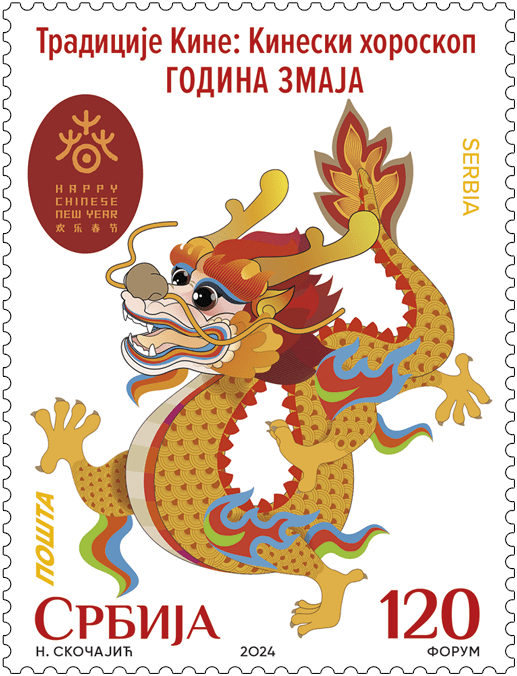
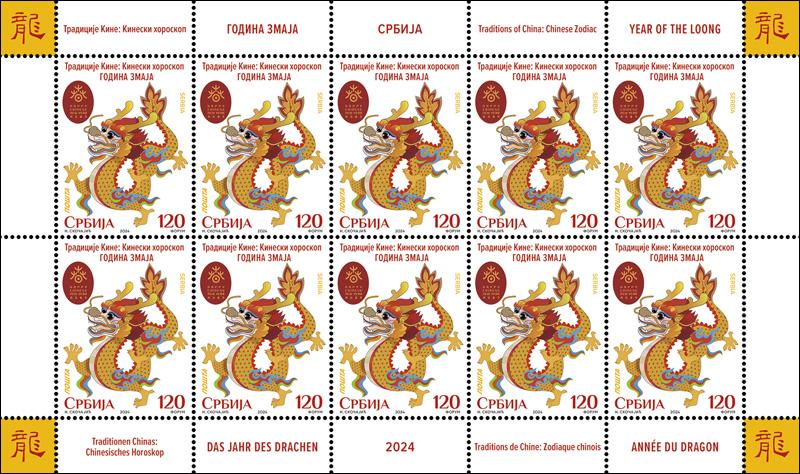
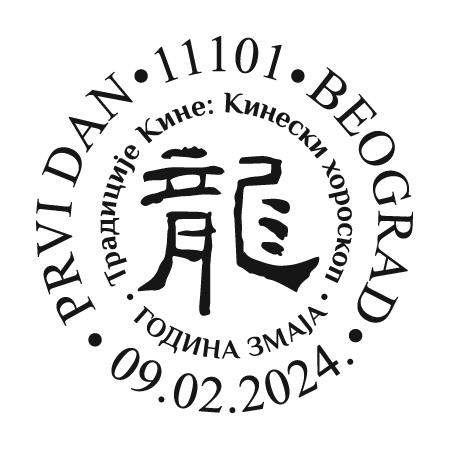

Chinese culture, thousands of years old, has nourished a tradition of excellence that has been passed down to this very day. It profoundly affects the spiritual world and living customs of the Chinese people, and gifts the world and mankind with precious cultural heritage and spiritual wealth.
The Chinese Zodiac signs are twelve animals that match the twelve astrological branches, including Mouse, Ox, Tiger, Rabbit, Loong, Snake, Horse, Goat, Monkey, Rooster, Dog, and Pig, with a twelve-year cycle. In China's pre-Qin period, it has already developed into a relatively complete zodiac system.
The year ahead marks the year of the Loong. Endowed with innate courage and enthusiasm, The Loong is a symbol of propitiousness and happiness, heralding a year full of opportunities and positivity.
The material for the realization of the commemorative postage stamp was provided by the Ministry of Culture and Tourism of the People's Republic of China.
Professional cooperation: China Cultural Center in Belgrade
Artistic realization: Nadežda Skočajić, academic graphic artists
Technical details
Date of issue: 9. 2. 2024.
Denomination: 120.00 RSD
Number of stamps in set: 1
FDC: 1
Subject: Traditions of China – Chinese Zodiac – Year of the Loong
Issue format: sheet of 10
Dimensions: 31,9 x 42 mm
Perforations: 13 3/4
Printer: Forum Novi Sad
Artistic realization: Nadežda Skočajić
Serbia-Slovenia: Our Great People

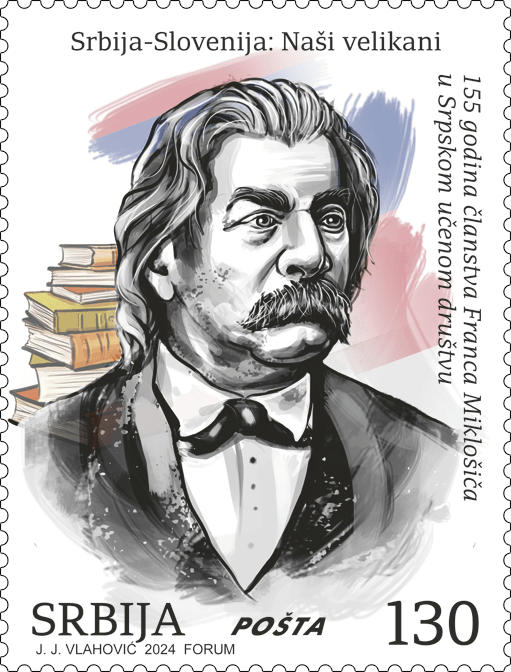
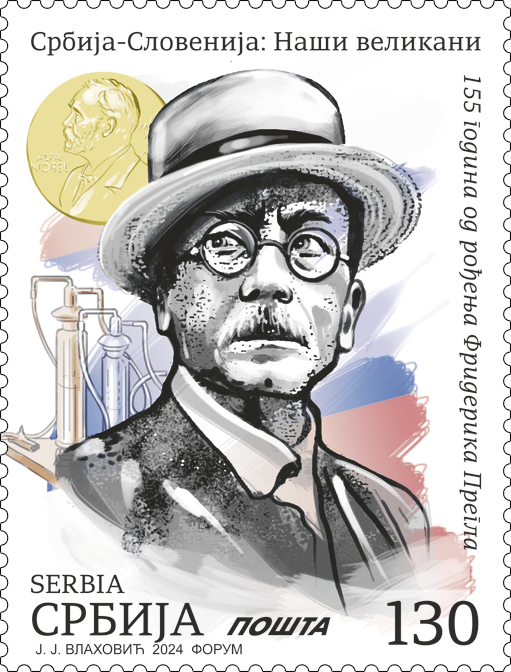
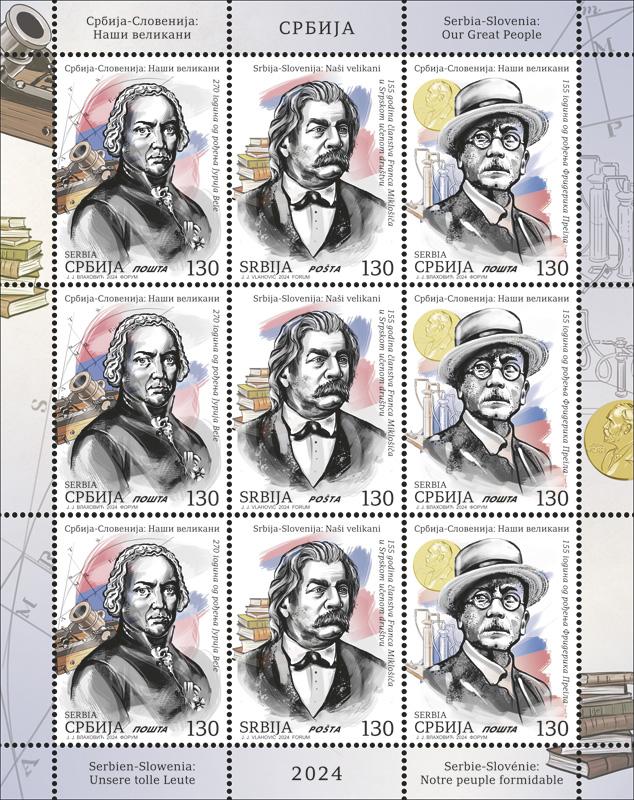
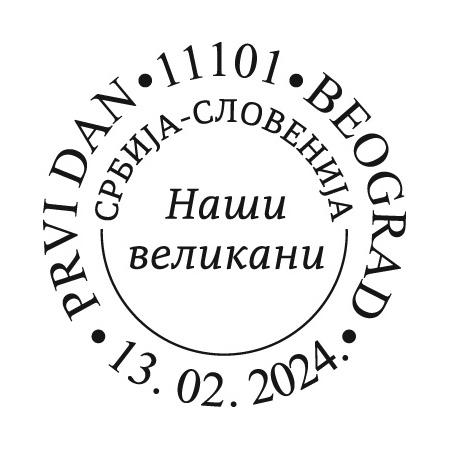
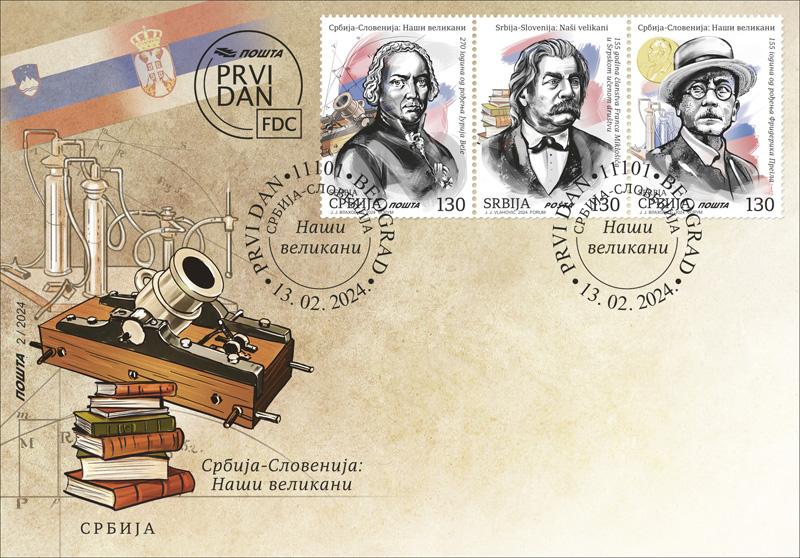
People of Serbia and Slovenia are united by their Slavic origins, close languages, cultures and common, shared history. The Republic of Serbia and the Republic of Slovenia have excellent bilateral relations, and cooperation in the fields of economy, science, culture, sports and education is at an exceptionally high level. This isuue acknowledges and underlines the role played by three great historical figures of Slovenia in the history of both Slovenia and Serbia.
Jurij Vega (March 23, 1754 - September 26, 1802) was a Slovenian mathematician and artillery officer. He will be remembered as a mathematician who broke the then world record for calculating the decimal of the number Pi (with 140 calculated decimals) and an engineer who regulated the flows of the Sava and Ljubljanica rivers. The Serbian people, however, will primarily remember him as a war hero who, in command of the artillery, liberated Belgrade from the Turks in 1788.
Franz Miklosich (November 29, 1813 - March 7, 1891) was a Slovenian philologist and linguist, a member of the Serbian Learned Society and later the Serbian Royal Academy. He left behind a large number of extremely important linguistic achievements for the Slovenian and Serbian languages. His “Comparative Grammar of Slavic Languages” and “Old Slavic-Greek-Latin Dictionary” are considered to be some of the most important works in this scientific field of that period. He was a signatory of the Vienna Literary Agreement (1850) and a recipient of the medal of Serbian Order of Saint Sava.
Friderik Pregl (September 3, 1869 - December 13, 1930) was a Slovenian chemist, winner of the Nobel Prize in Chemistry (1923), dean and vice-chancellor of the University of Graz. He received the Nobel Prize in Chemistry for his work in advancing quantum organic microanalysis. His method made possible to carry out this process with 50 times smaller amounts of material than before, thus openning the doors to research in many areas where it was difficult or impossible to obtain larger amounts of material for analysis.
Professional cooperation: “Svetozar Marković” University Library
Artistic realization of the issue: Jakša Vlahović, Academic Graphic Artist
Technical details
Date of issue: 13. 2. 2024.
Number of stamps in set: 3
Denomination and printrun:
1300. 130.00 RSD, 25.000
1301. 130.00 RSD, 25.000
1302. 130.00 RSD, 25.000
FDC: 1
Artistic realization: Jakša Vlahović
Subject: Serbia-Slovenia: Our Great People
1300. Portrait of Jurij Vega
1301. Portrait of Franz Miklosich
1302. Portrait of Friderik Pregl
Issue format: sheet of 9
Dimensions: 31,9 x 42 mm
Perforations: 13 3/4
Printer: Forum Novi Sad
Two Centuries of “Letopis Matice srpske”
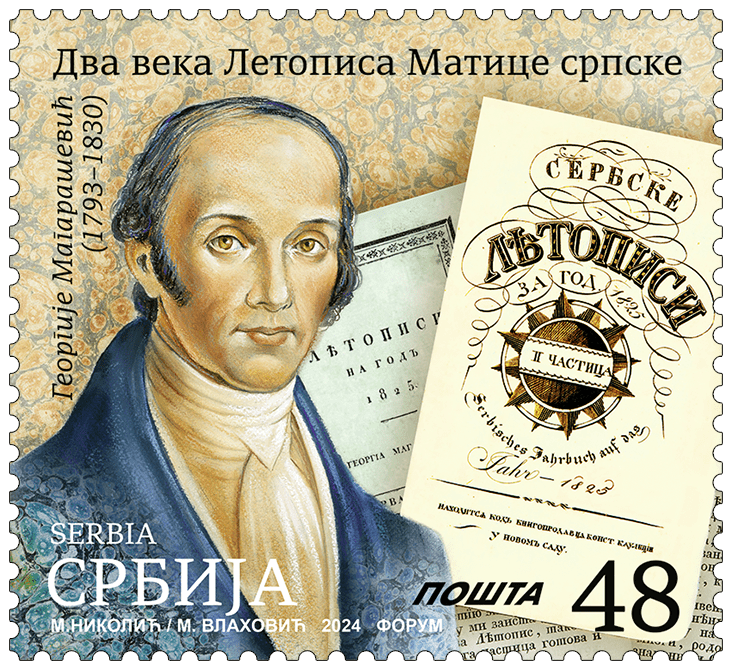
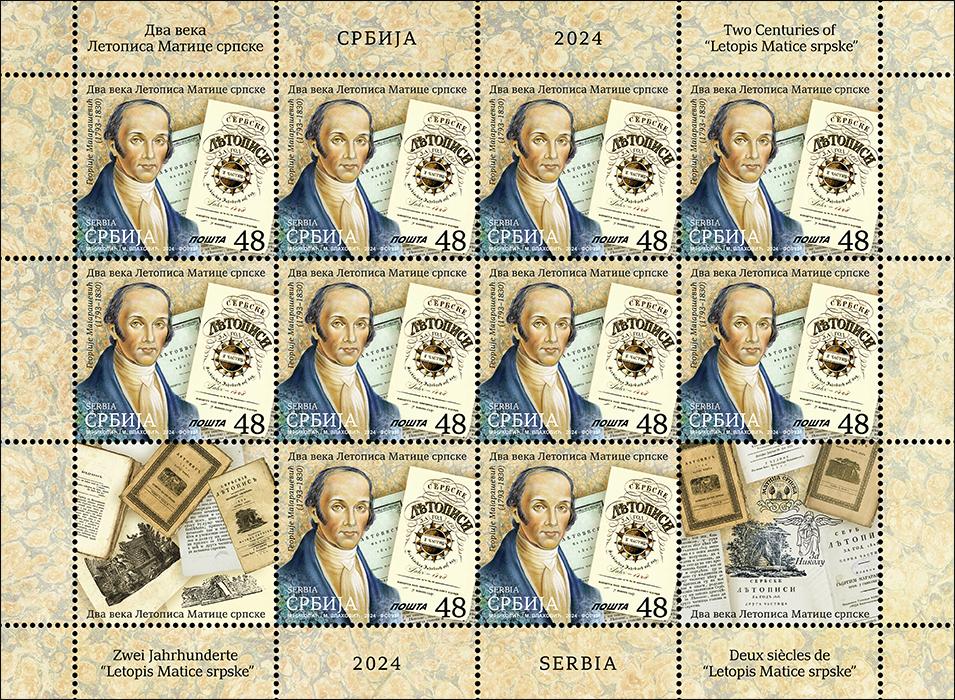
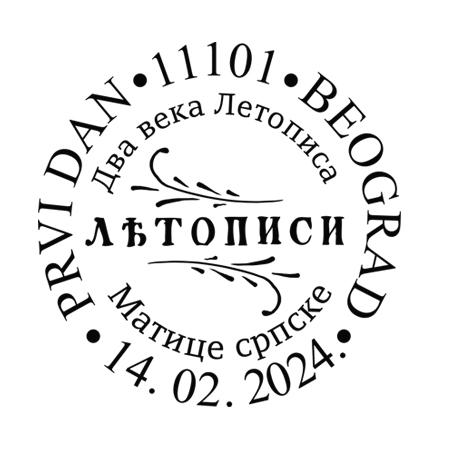
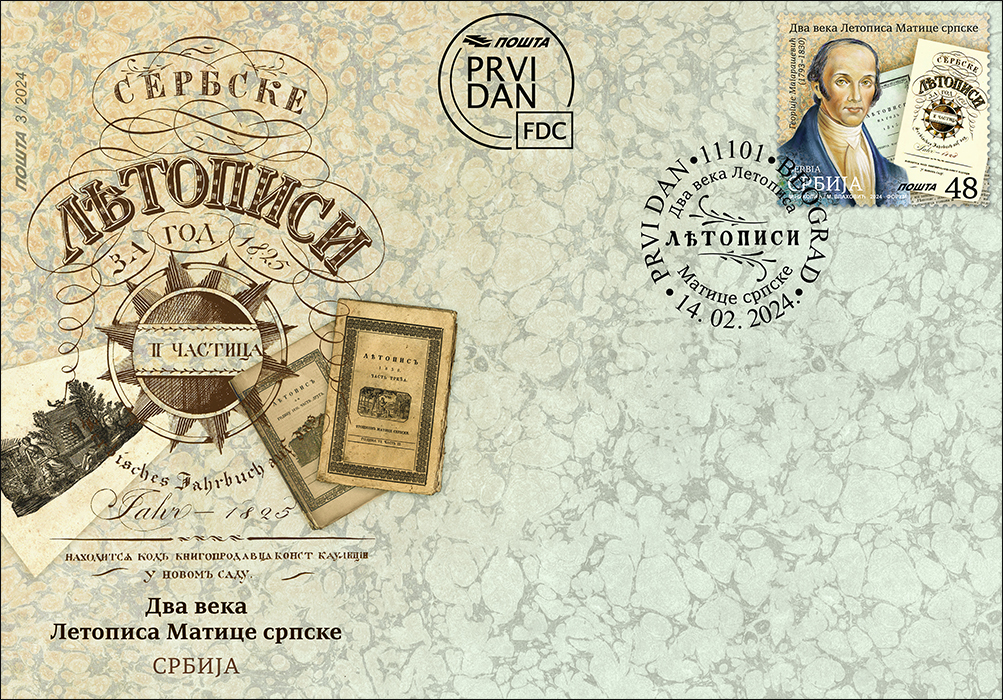
Matica srpska, one of the most important cultural institutions in the Republic of Serbia, dedicates the year 2024 to the celebration of a great jubilee — “Two Centuries of Letopis Matice srpske”.
Letopis of Matica srpska is a literary magazine founded in 1824 in Novi Sad with the aim of presenting the results of creativity, primarily of the Serbian people and in Serbian language, in literature and science. The founder of the maga-zine, Georgije Magarašević, wanted, and two centuries later we can say that he succeeded in his intention, to create a central place for the gathering and dissemination of knowledge in the fields of language, literature, history, religion, folklore and culture in general, and not only of the Serbian people, but also of the entire Slavic world. The publication of the issue of commemorative postage stamps “Two Centuries of Letopis Matice srpske” contributes to this great jubilee marking the publication anniversary, as well as the literary magazine itself, with the aim of presenting it in the best way possible and bringing it closer to all citizens of the Republic of Serbia.
Georgije Magarašević (September 10, 1793 — January 6, 1830) was a Serbian writer, historian and publisher who will be remembered as the initiator of the Letopis, the oldest literary magazine in this region and beyond. A humanist by determination, and a lover of Serbian history, language and people, Magarašević left an eternal mark and memorial to his name by founding the Letopis, and provided Serbian culture with a place of permanent remembrance of the past, a space for considering the present and a pledge for the future.
Artistic realization of the issue: Miroslav Nikolić,
MA Marija Vlahović, academic graphic artist
Technical details
Date of issue: 14. 02. 2024.
Number of stamps in set: 1
Denomination and printrun:
1303: 48.00 RSD, 25.000
FDC: 1
Artistic realization: Miroslav Nikolić, Marija Vlahović
Subject: Two Centuries of “Letopis Matice srpske”
1303. Portrait of Georgije Magarašević and first two covers of this Chronicle
Issue format: sheet of 10
Dimensions: 35 x 31,9 mm
Perforations: 13 3/4
Printer: Forum Novi Sad
100 years of Radio Beograd
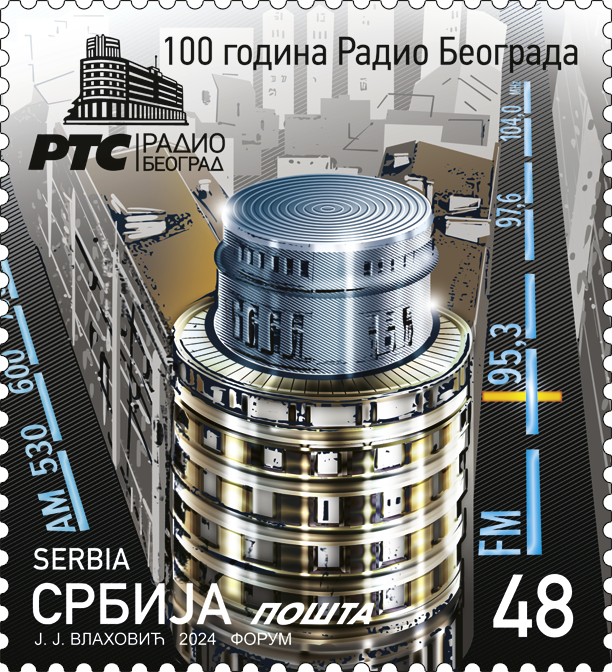
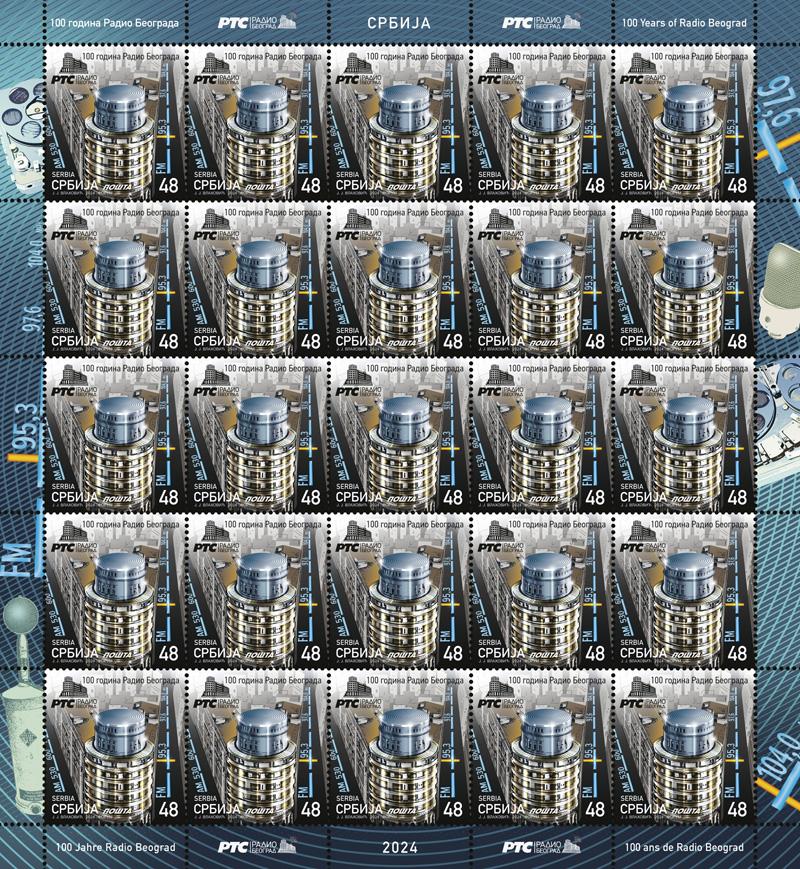
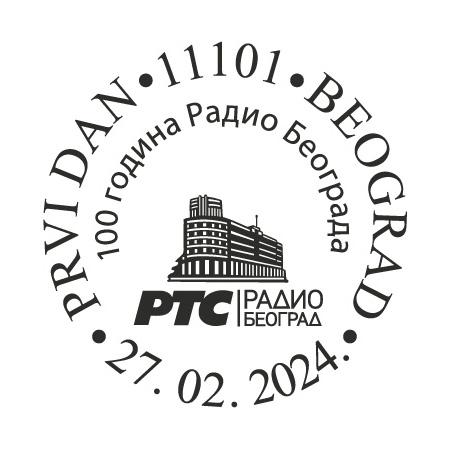
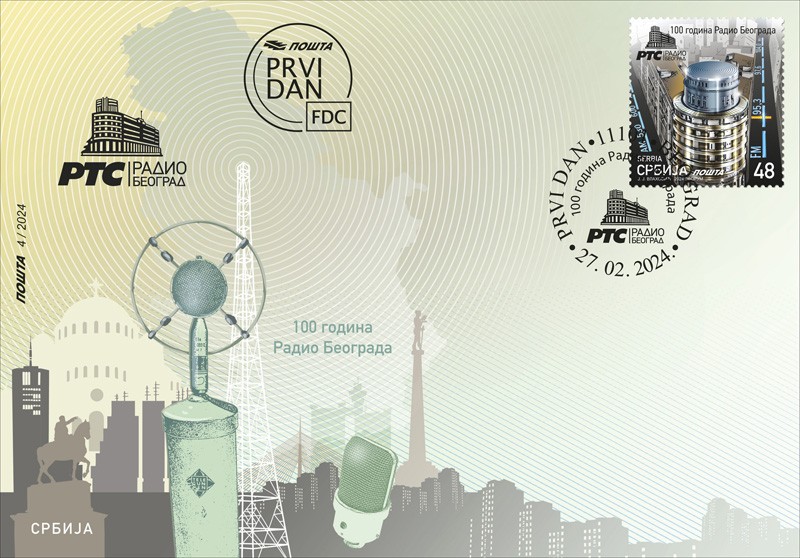
October 1, 1924 is taken as the date of the official start of broadcasting of radio programme in our country, the day of the beginning of programme broadcasting of Radiophonic Station Belgrade–Rakovica, the first in Serbia, the Kingdom of SCS, and the Balkans. On the same day of the same year, radio programme in Vienna began broadcasting. Politika and all the other daily press of the time published the news about the radio programme schedule, the radio concert that was held on Tuesdays, Thursdays and Saturdays afternoon in the concert hall at Knez Mihailova 42 in Belgrade, and was broadcast through the radiotelegraph station in Rakovica.
The technical innovation of that time met with a more than warm reception from listeners who demanded regular daily broadcasting of the programme, so the newly formed enterprise Radio Beograd JSC started regular broadcast of radio programme on March 24, 1929, with the words spoken by Jelena Bilbija, “This is Radio Beograd calling”. The bombing of Belgrade on April 6, 1941 and the German occupation of Serbia led to the interruption of the Radio Beograd programme, on the airwaves of which the signal of the occupation German station Military Radio Belgrade, known for the wartime hit Lily Marlene, was broadcast.
On November 10, 1944, Jelena Bilbija once again addressed the listeners of Radio Beograd from the liberated capital, with the familiar words – “This is Radio Beograd calling”. Not long after the liberation, in 1947, Radio Beograd got a new address – a building at Hilandarska 2, from the roof of which the letters of this radio station are still visible today.
“Jolly evening”, “Caravan”, “Good morning, children”, “Time for sports and entertainment”, are just some of the shows with which generations from these areas grew up listening to the voices of Draga Jonaš, Ljiljana Marković, Dušanka Kalanj, Mića Orlović, Svetislav Vuković, Jordan Ivanović, Marko Marković and many others who, from the waves of Radio Beograd 1, and then Radio Beograd 2 (from 1958), the third programme of Radio Beograd (from 1965), and Programme 202 (from 1969), were daily guests in homes throughout our region, making Radio Beograd the most influential radio station in the Balkans.
Professional cooperation: Radio Beograd
Artistic realization of the issue: MA Jakša Vlahović, academic graphic artist
Technical details
Датум издања: 27. 2. 2024.
Број марака: 1
1304: 48.00 дин, тираж: 25.000
Коверат првог дана (FDC) са жигом: 1
Табак: 25
Димензије марака : 31,9 x 35 mm
Штампа: вишебојни офсет
Зупчање: чешљасто 13 3/4
Штампарија: Форум Нови Сад
Artistic realization: Jakša Vlahović
Нацрт: 1304. Зграда Радио Београда у Хиландарској улици, представљена као потенциометар за радио станице
Prominent Serbs
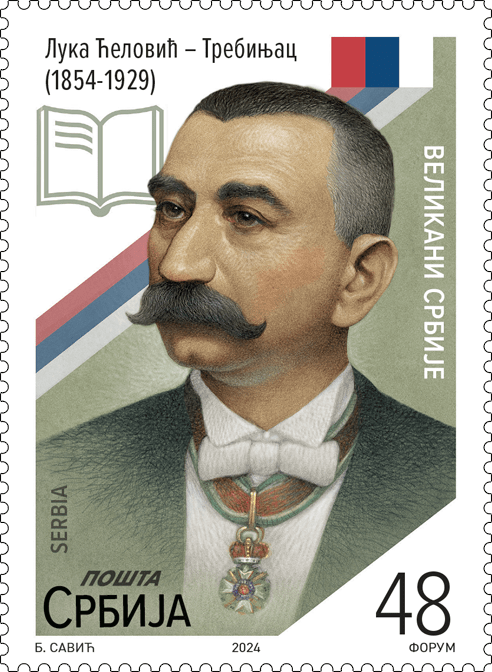
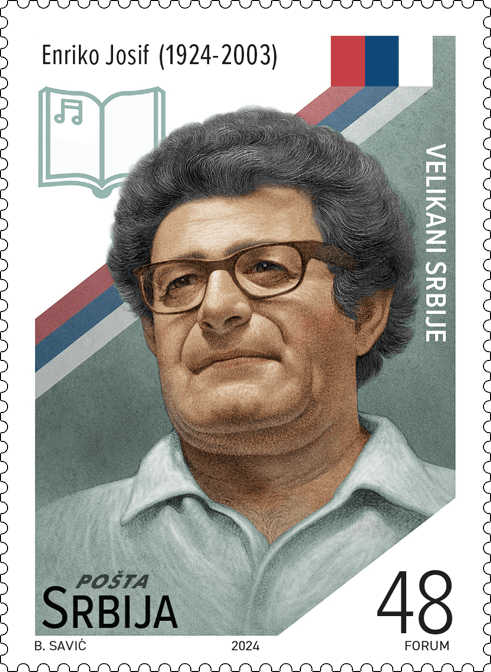
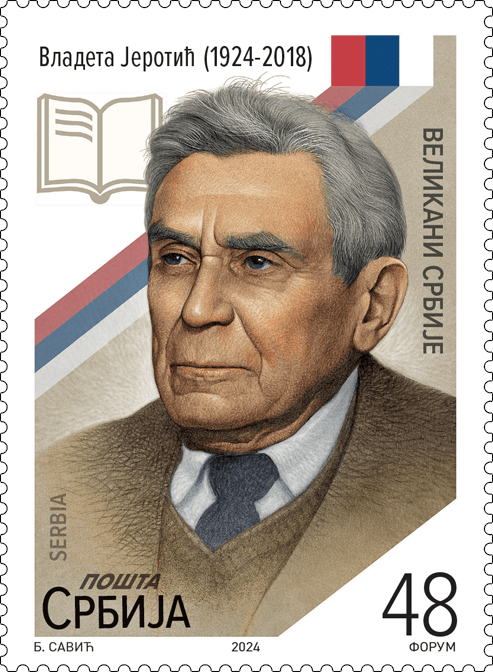
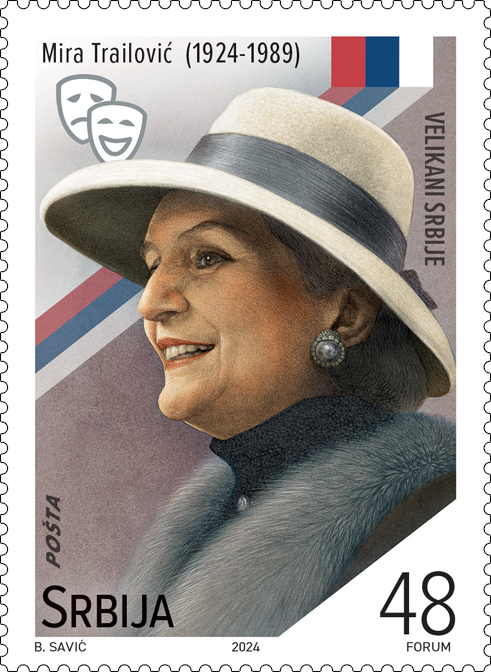
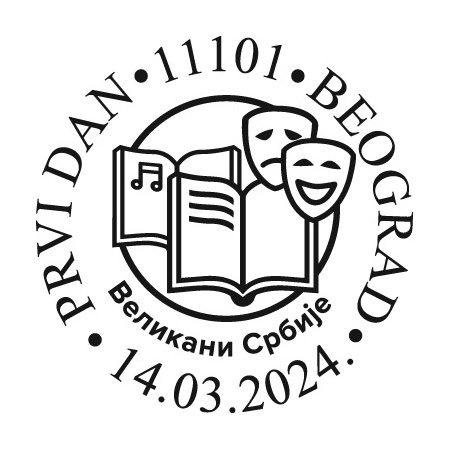
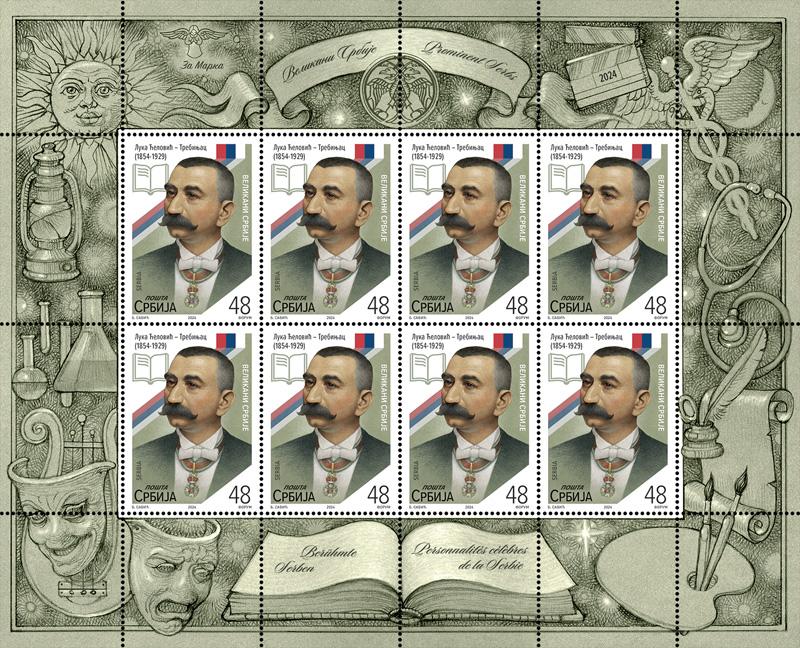
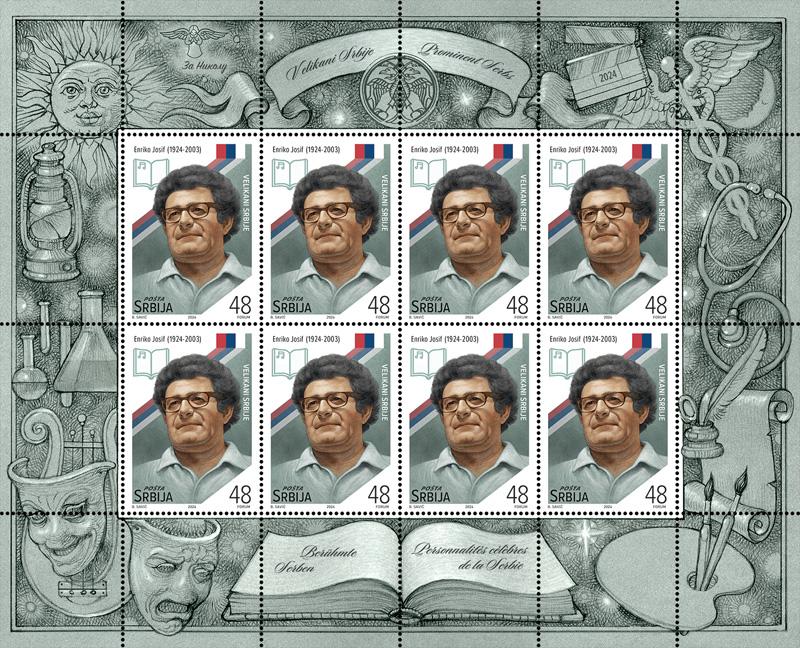
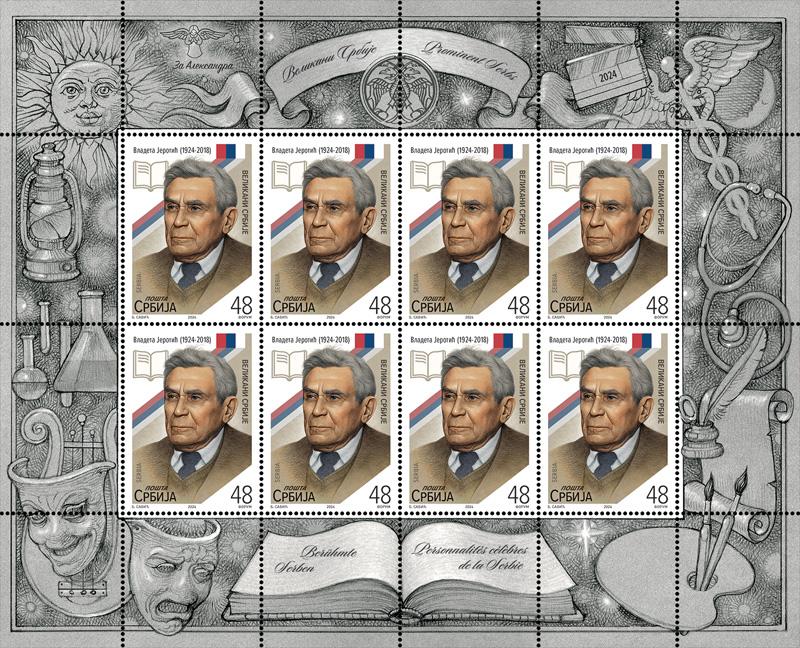
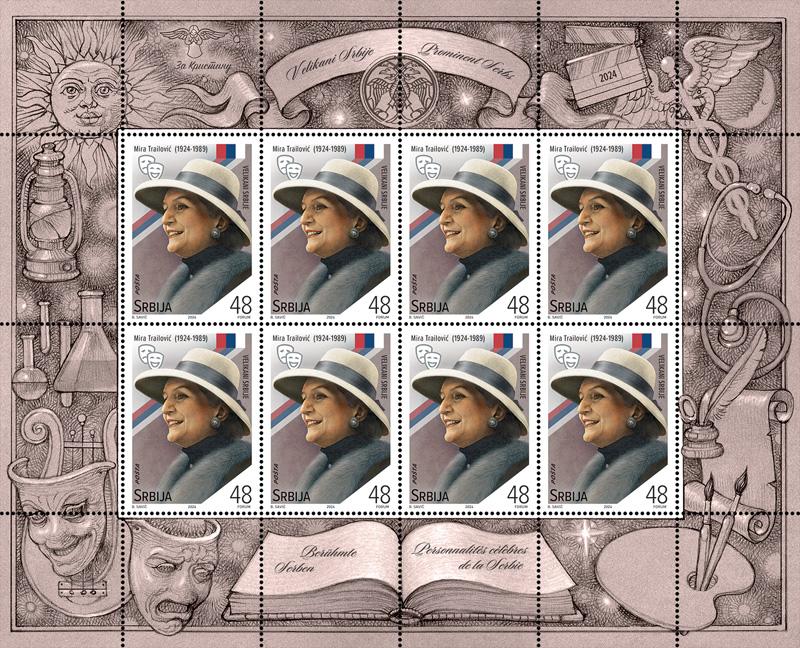
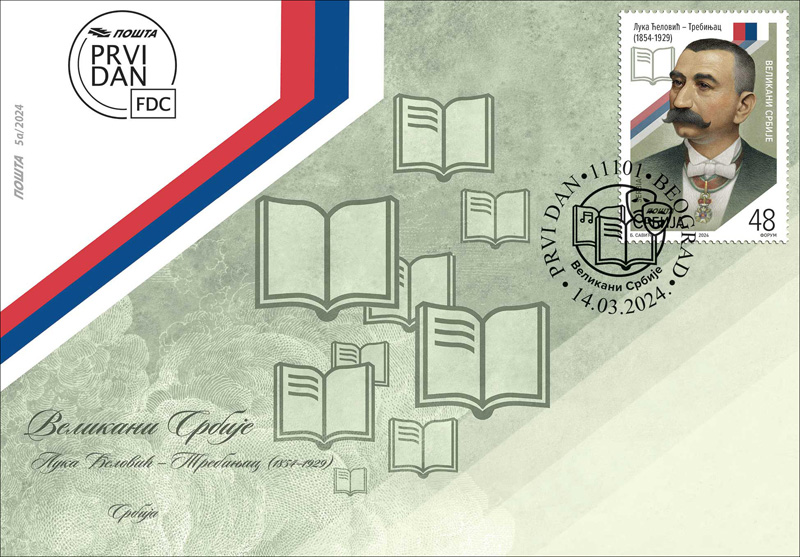
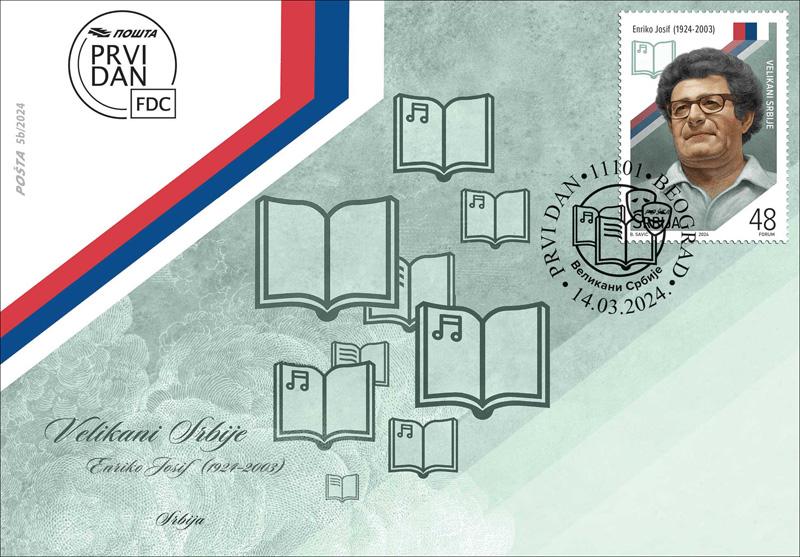
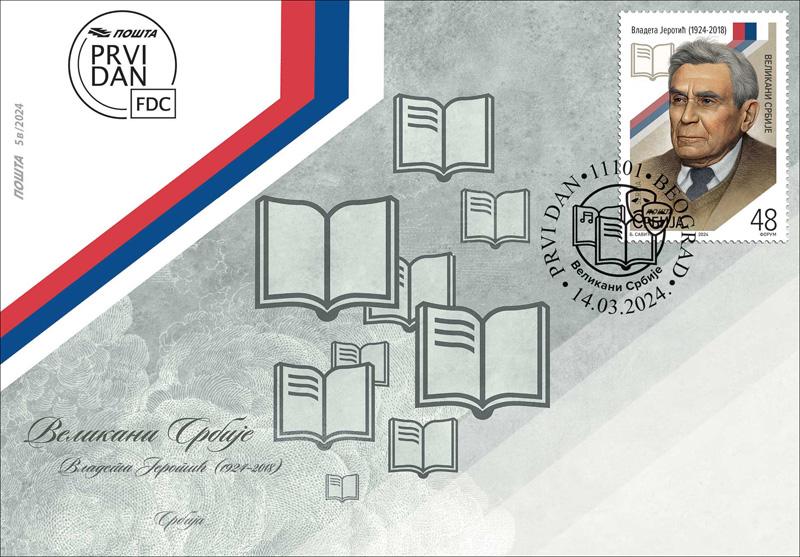
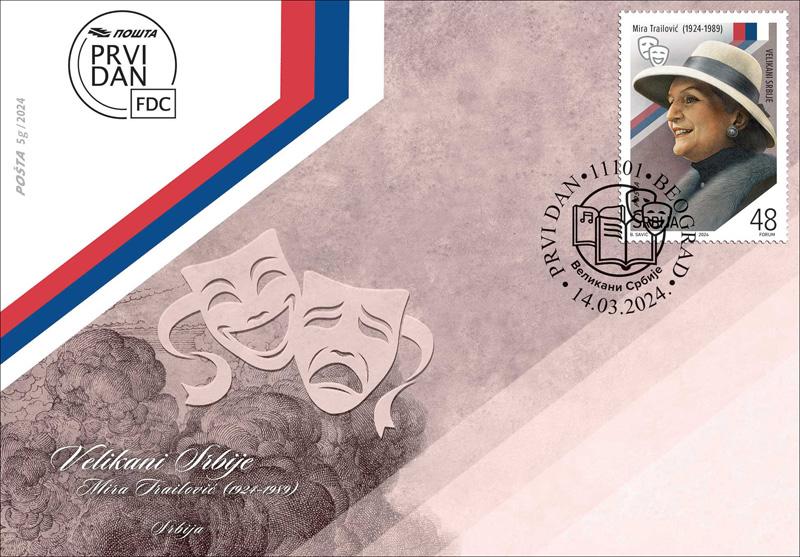
Luka Ćelović – Trebinjac
Luka Ćelović – Trebinjac (Pridvorci near Trebinje, October 18, 1854 – Belgrade, August 15, 1929) was a famous merchant, financier, benefactor and endower, one of the richest people in Serbia at the beginning of the 20th century and a great benefactor of Belgrade University.
He completed his elementary studies in Trebinje, apprenticed in trade in Banja Luka and Brčko, and from 1872, he was apprenticed to Petar Radosavljević and Mita Ignjatović in Belgrade. As a volunteer, in the summer of 1875 he joined the insurgents in Herzegovina, and from 1876 he joined the Serbian army during both Serbian-Turkish wars. In the fall of 1878, he began to engage in trade on his own. As early as 1882, as a reputable merchant, he participated in the founding of the Belgrade Cooperative, which was intended for small and medium-sized merchants, artisans, and officials, and devoted himself completely to the activities of the Cooperative.
He was elected as a member of the Steering Committee of the National Bank of Serbia in February 1912 and in the same year by the Decree of His Highness King Petar I from February 7, Luka Ćelović was appointed a member of the Endowment Council at the Ministry of Education, a member of which he remained until his death.
During the First World War, as a member of the Steering Committee of the National Bank, he participated in the evacuation of the National Bank's treasury with Đorđe Vajfert and Marko Stojanović, first to Thessaloniki and then to Marseilles, where he remained until the end of the war, helping our wounded and refugees.
Luka Ćelović significantly contributed to the change of Belgrade's visual identity, first by building a family house in Savamala at Kraljevića Marka St. 1, which was built in 1903 by Eng. Miloš Savčić, and then by participating in the construction of the Palace of the Belgrade Cooperative and the magnificent building of the "Bristol" hotel, as well as the Stock Exchange building. On his estate, in today's Karađorđeva Street, he built and arranged a large and beautiful park, which he visited every morning. He bequeathed all his property to the University of Belgrade. He founded the "Endowment of Luka Ćelović – Trebinjac, a Belgrade merchant" in 1926.
Enriko Josif
Enriko Josif (Belgrade, May 1, 1924 – Belgrade, March 13, 2003) was a Serbian composer, pedagogue, music writer, professor and member of the Serbian Academy of Sciences and Arts.
He was born in a Jewish Sephardic family as Hayim Yosif, but his father, Mosha Yosif, a merchant and representative of German and Italian companies, otherwise a fan of music and a fan of the famous Italian tenor Enrico Caruso, affectionately called him Enriko. Mother Sofia, educated in Switzerland, was a translator and a member of the international PEN club.
The Josif family spent the war years in exile. After the end of the war, they return to Belgrade, where Enriko continued his education and graduated from the First Belgrade Gymnasium. He graduated from the Academy of Music in the class of Professor Milenko Živković in 1954. He began his career as a music pedagogue in 1955 at the "Vojislav Vučković" Junior Music School (1955–1956) and the "Kornelije Stanković" Secondary Music School (1955–1957). He became the Assistant Lecturer at the Department of Composition at the Academy of Music in 1957 under his Professor Milenko Živković. During 1961 and 1962, he stayed in Rome for further studies, and after Živković's sudden death in 1964, he took over his chair at the Department of Composition. He was elected Assistant Professor in 1965, became Associate Professor in 1970, and earned the title of Full Professor in 1976. He worked as a Full Professor until his retirement in 1989.
He was elected a corresponding member of SANU in 1991, and became a regular member in 2000.
He composed numerous vocal and instrumental, chamber, choral and orchestral pieces, among which the most famous are "Sonata Antika", "Death of Stefan Dečanski", "Concerto for Piano and Orchestra", "Hamlet" and others.
Enriko Josif died in Belgrade on March 13, 2003. He was buried at the Jewish Cemetery.
Vladeta Jerotić
Vladeta Jerotić (Belgrade, August 2, 1924 – Belgrade, September 4, 2018) was a doctor, neuropsychiatrist and psychotherapist, professor, philosopher, writer and member of the Serbian Academy of Sciences and Arts. He graduated from the Second Male Gymnasium in Belgrade, then from the Faculty of Medicine in 1951, where he specialized in neuropsychiatry in 1957. He specialized in psychotherapy in Switzerland, Germany and France from 1958 to 1961.
Until 1963, he worked as an Assistant at the University Neurology Clinic, and when the first psychotherapeutic department was established at the "Dragiša Mišović" hospital, Vladeta Jerotić moved to work with the Primarius, Dr. Vladislav Klajn. During the decades of work on the development of psychotherapy in Serbia, he gained extensive experience in working with patients and obtained the title Primarius.
In 1985, at the Orthodox Faculty of Theology, he participated in the establishment of the Department of Pastoral Psychology and Medicine and devoted himself completely to pedagogical and scientific work, definitively leaving the hospital and psychotherapy. Interest that went beyond medicine and nourished the research spirit led Jerotić to cultural anthropology and resulted in over 70 books and several hundred scientific articles in the fields of psychotherapy, sociology, social psychiatry and philosophy. In addition to extensive journalistic activities and research work, he held a series of lectures throughout Yugoslavia and Serbia.
Since 1984, Vladeta Jerotić was a member of the Association of Writers. He was also a regular member of the Academy of Medical Sciences and a member of the Serbian Medical Society (psychotherapeutic section), the Psychotherapeutic Society of Yugoslavia, as well as the Jung Association in Belgrade. He was elected a corresponding member of the Serbian Academy of Sciences and Arts, Department of Languages and Literature in 1994, and a full member in 2000. He is the recipient of numerous recognitions and awards for his scientific work and social contribution. He died on September 4, 2018 in Belgrade.
Mira Trailović
Mirjana Mira Trailović (Kraljevo, January 22, 1924 – Belgrade, August 7, 1989) was a prominent Yugoslav theatre and film director, one of the founders and a long-time manager of Atelje 212, one of the most important theatre centres in the former Yugoslavia. Her overall contribution to culture in our region is extremely important, and her works left a deep and lasting impression.
She was born into a bourgeois family, her father was a translator, and her mother was a professor. She entered public life as an announcer at Radio Belgrade in 1944, where she later became a director and editor of the drama program. She graduated in directing in 1956 at the Faculty of Dramatic Arts in Belgrade, and later taught radio directing there. As her graduation thesis, she directed a concert performance of Goethe's "Faust" at the opening of Atelje 212 on November 12, 1956.
The establishment of the Atelje 212 theatre, at that time an avant-garde theatre known for its innovative performances that often challenged social norms and taboos, but were also extremely popular with the audience, is one of Mira Trailović's most significant achievements, although not the only one. Together with Jovan Ćirilov, she founded the Belgrade International Theatre Festival BITEF in 1967, and was its artistic director until the end of her life. In 1989, she participated in the founding of the Bitef Theatre.
On the stage of Atelje 212, she staged some of the cult performances of this theatre – the rock opera "Jesus Christ Superstar", the musical "Hair", the play "Miracle in Šargan" and numerous other, and thanks to her engagement as artistic director of Bitef, Belgrade hosted the biggest names of the avant-garde theatre of that time – Jean-Paul Sartre, Thomas Eliot, Eugène Ionesco, Samuel Beckett, etc.
Known for her brave and committed approach to theatre and active social engagement, Mira Trailović made a huge contribution and left a deep mark in the world of art and culture. She died in Belgrade in 1989.
Expert collaboration: ”Svetozar Marković” University Library, Belgrade
Artistic realization of the issue: Boban Savić MA, academic painter
Technical details
Date of issue: 14. 3. 2024.
Number of stamps in set: 4
1305: 48.00 дин, тираж: 25.000
1306: 48.00 дин, тираж: 25.000
1307: 48.00 дин, тираж: 25.000
1308: 48.00 дин, тираж: 25.000
Коверат првог дана (FDC) са жигом: 4
Табак: 8
Димензије марака: 35 x 47,85 mm
Штампа: вишебојни офсет
Зупчање: чешљасто 13 3/4
Штампарија: Форум Нови Сад
Уметничка реализација: Бобан Савић
Нацрт: 1305. Лука Ћеловић – Требињац
Нацрт: 1306. Енрико Јосиф
Нацрт: 1307. Владета Јеротић
Нацрт: 1308. Мира Траиловић
25 years of commemoration of the heroes of the homeland
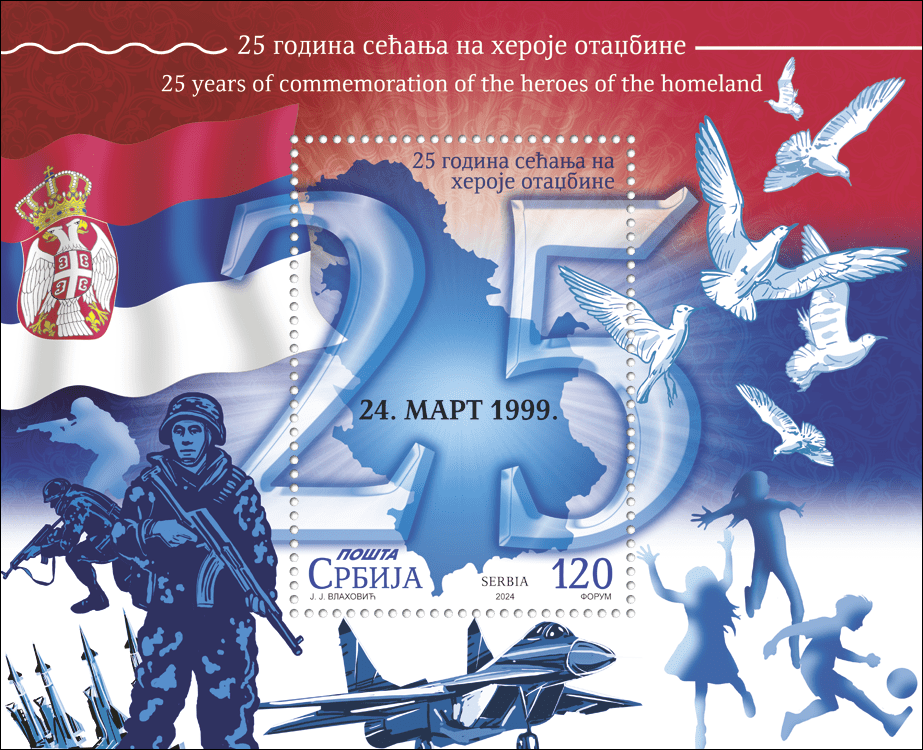

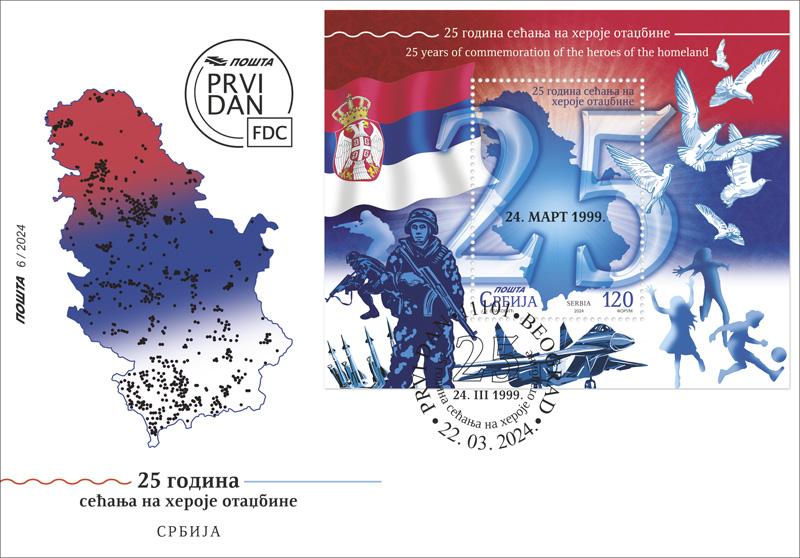
Heroism is an act of courage, sacrifice and selflessness, in the name of defending the good. Heroes consciously expose themselves to danger and risk in order to protect and defend those who are unable to defend themselves. Heroism is best perceived when times are hard, when they are most difficult – in war conditions, natural disasters and other crises.
25 years ago, Serbia was a victim of NATO aggression, which lasted 78 days and took thousands of lives, including more than eighty children. Our citizens died in the bombing of a bus in Lužane, a passenger train in Grdelica Gorge, the building of the Radio Television of Serbia in Belgrade, under cluster bombs in Aleksinac, Niš, Varvarin and Novi Pazar and in many other places on the territory of Serbia.
The heroes who, from the first enemy attacks, on March 24, 1999, defended Serbia in the actions of the army and the police in Kosovo and Metohija, in airplanes in the sky above Serbia and in anti-aircraft defence positions on the ground, will remain in the eternal memory of generations as an example of how to love and defend the homeland despite everything. The heroes we remember today are as well all our citizens who expressed opposition to aggression – protesting on the bridges, squares and streets of Serbia or conscientiously performing their duties in the most difficult moments of our country’s recent history.
The Post of Serbia publishes the issue of commemorative postage stamps “25 years of commemorating the heroes of the homeland” as a sign of gratitude to all heroes, known and unknown, brave individuals who laid down their lives defending the homeland a quarter of a century ago, as well as to all those heroes who contributed to the defence of our country by their actions at that time.
The heroes of the homeland, who defended Serbia in 1999, collectively entered the memory of the nation and established the best example of patriotism for all future generations of our people. Glory and thanks be to the heroes of the homeland!
Artistic realization of the issue: MA Jakša Vlahović, academic graphic artist
Technical details
Date of issue: 22. 3. 2024.
Number of stamps in set: block with 1 stamp
Denomination and printrun:
Block 111: 12.00 RSD, 10.000
FDC: 1
Artistic realization: Jakša Vlahović
Subject: 25 years of commemoration of the heroes of the homeland
Block 111: National landmarks of the Republic of Serbia with symbolic display of war heroes, freedom and peace.
Issue format: block
Dimensions of the block: 96 x 78 mm
Dimensions of the stamp in block: 35 x 49.3 mm
Perforations: 13 3/4
Printer: Forum Novi Sad
100 years since the birth of Martin Jonaš
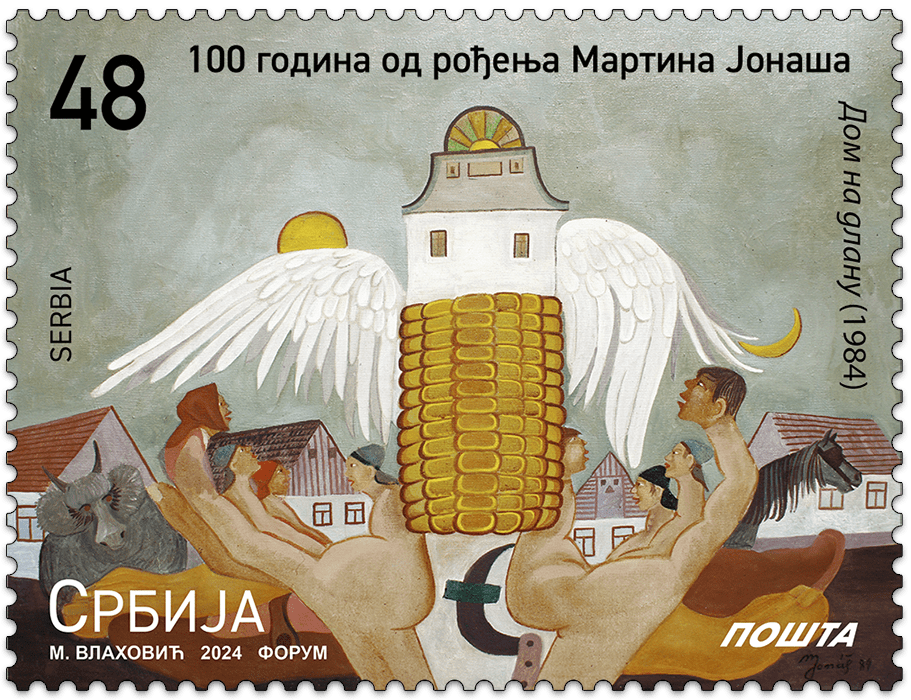
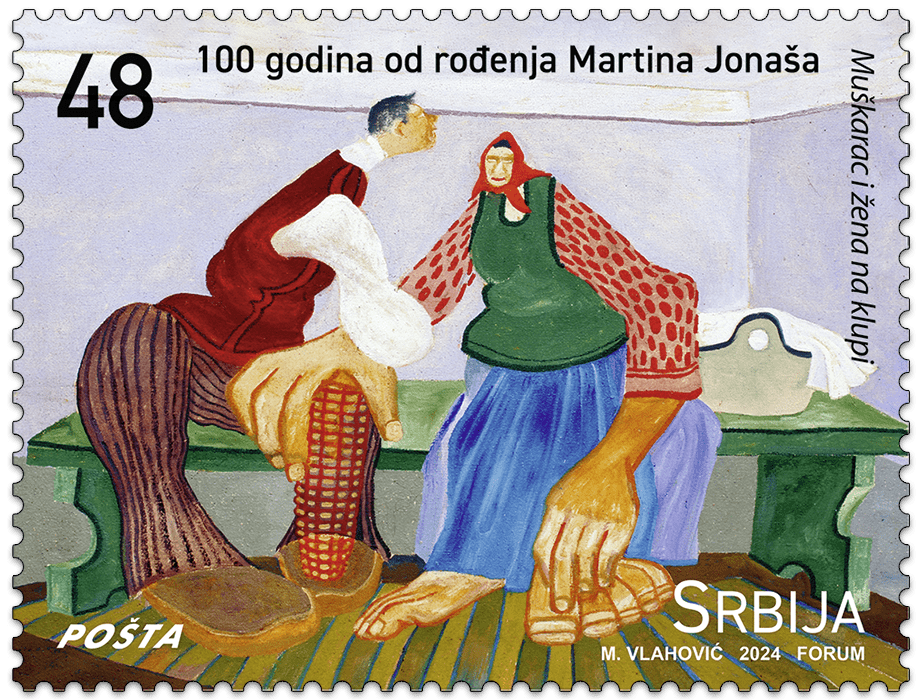

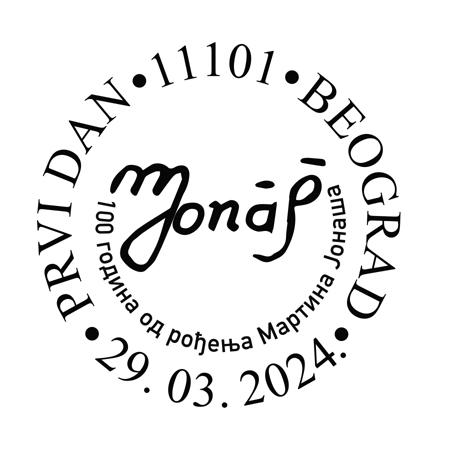
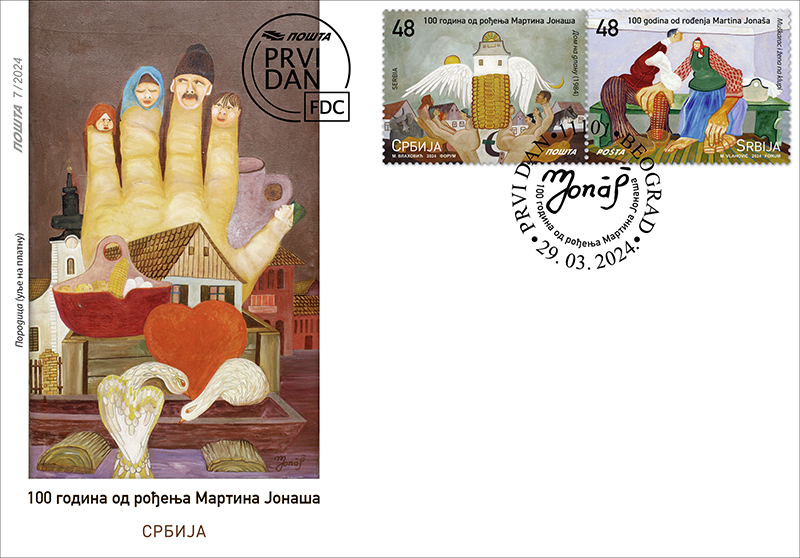
Martin Jonaš (1924–1996) is one of the most important and world-renowned naïve painters of Slovak origin from the Republic of Serbia. His painting became globally recognizable thanks to a large number of individual and group exhibitions held around the world and numerous international awards and recognitions. His paintings are characterized by a visually special way of depicting human figures, oversized hands and feet, which gives recognition to physical work, which makes it particularly current today. The issue is also a specific tribute to the naive painting of the Slovak national minority from Kovačica. That is why the sheet of the issue inscribes in the history of philately and national memory the extremely valuable works of contemporary Kovačica naive painting by its most prominent representatives: Pavel Hajko, Jan Glozik, Zuzana Vereski, Pavel Cicka, Pavel Povolni Juhas, Klara Babka, Vieroslava Svetlik and Miroslav Hraško.
Professional cooperation: National Council of the Slovak National Minority in Serbia, Babka Kovačica Foundation and Kovačica Naive Art Gallery – Martin Jonaš Memorial Home
Graphic realization of the issue: MA Marija Vlahović, academic graphic artist
Technical details
Датум издања: 29. 03. 2024.
Број марака: 2
1310: 48.00 дин,
1311: 48.00 дин,
тираж: 25.000
Коверат првог дана (FDC) са жигом: 1
Табак: 8
Димензије марака: 42 x 31,9 mm
Штампа: вишебојни офсет
Зупчање: чешљасто 13 3/4
Штампарија: Форум Нови Сад
Уметничка реализација: Марија Влаховић
Нацрт: 1309. Дом на длану, Мартин Јонаш, уље на платну, 1984.
Нацрт: 1310. Мушкарац и жена на клупи, Мартин Јонаш, уље на платну
180 years of Serbian Civil Code
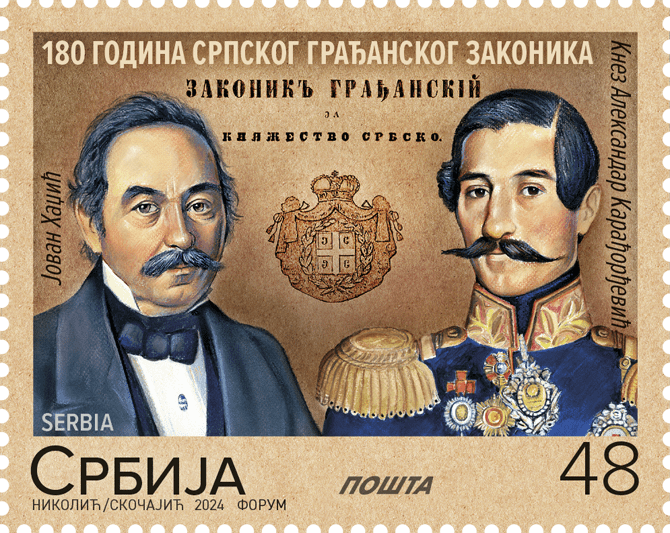
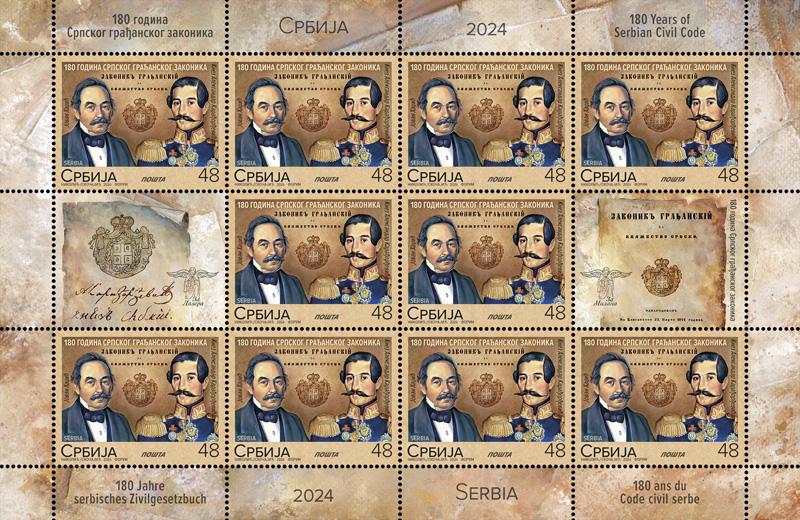
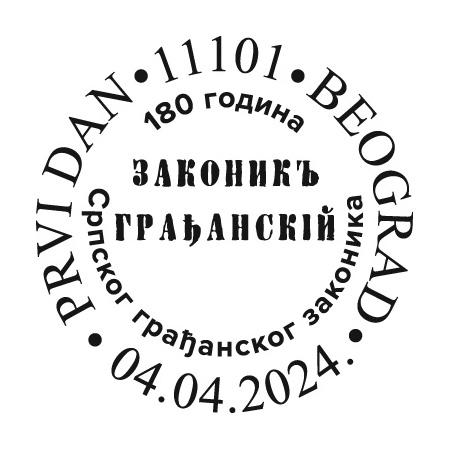
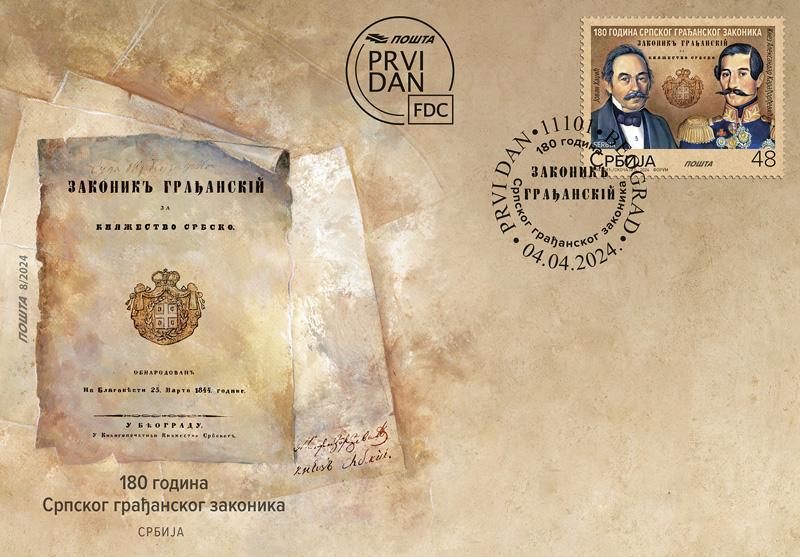
One of the earliest and most significant modern codifications of civil law in 19th-century Europe, the first and only comprehensive civil code in Serbia, the longest-lived code in the history of modern Serbia, the Serbian Civil Code, was adopted on March 25 (March 11 according to the old calendar) 1844.
The development of the young Serbian state, the foundations of which were the Sretenje Constitution (1835) or the so-called Turkish Constitution (1838) conditioned the need for the creation of a civil law code that would confirm the inviolability of private property and provide a legal framework for the transformation of the backward feudal society under Ottoman rule into a modern, European bourgeois society.
In 1829, Prince Miloš appointed the Legislative Commission for the Drafting of the Code, with the instruction to compile a short compendium of law modelled according to the Austrian Civil Code, but based on Serbian customary law. The translations of foreign laws were not entirely in accordance with the conditions and circumstances in Serbia, so in 1834 the work of the Commission on drafting the Code was suspended. In 1837, the continuation of the work was entrusted to the lawyer and writer Jovan Hadžić.
The Serbian Civil Code, promulgated at the Annunciation in 1844, during the reign of Prince Aleksandar Karađorđević, best illustrates the continuity of Serbian society's aspirations to join the modern states of Europe in an important aspect of statehood and civil legislation.
The foundation of this Code was the Austrian Civil Code, but the influences of common law, Roman law, the French Civil Code from 1804, and Church and Sharia law can be seen in it. The Code affirms liberal principles and values, supplementing the constitutional norms of the Turkish Constitution from 1838.
The importance of the Serbian Civil Code, which with a total of 950 articles is among the shortest civil codifications, is reflected in the fact that its adoption made a departure from the Ottoman legal legacy and established a social and legal order based on personal freedom and private property, which made the young Serbian state of those times focused on the European path.
Expert collaboration: ”Svetozar Marković” University Library, Belgrade
Artistic realization: Miroslav Nikolić and Nadežda Skočajić, Academic Graphic Artist
Technical details
Датум издања: 04. 04. 2024.
Број марака: 1
1312: 48.00 дин, тираж: 25.000
Коверат првог дана (FDC) са жигом: 1
Sheet of: 10
Димензије марака: 42 x 33,35 mm
Штампа: вишебојни офсет
Зупчање: чешљасто 13 3/4
Штампарија: Форум Нови Сад
Artistic realization: Miroslav Nikolić, Nadežda Skočajić
Нацрт: 1311. Портрети Јована Хаџића и Кнеза Александра Карађорђевић
140 years since the arrival of Nikola Tesla in the USA
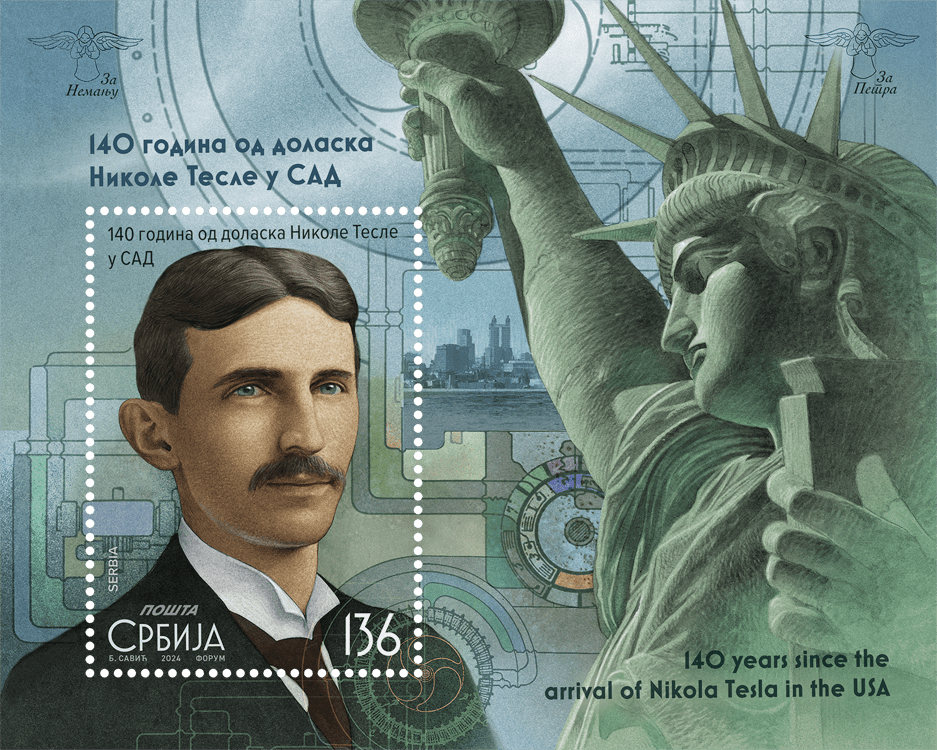
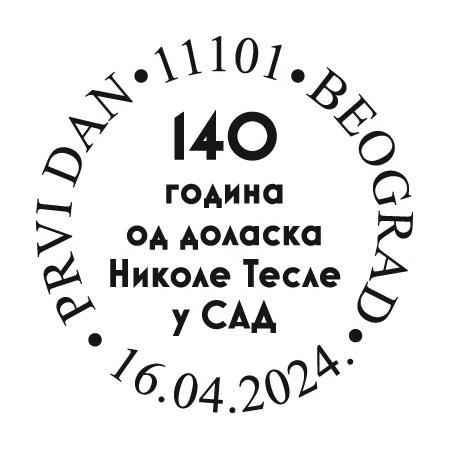
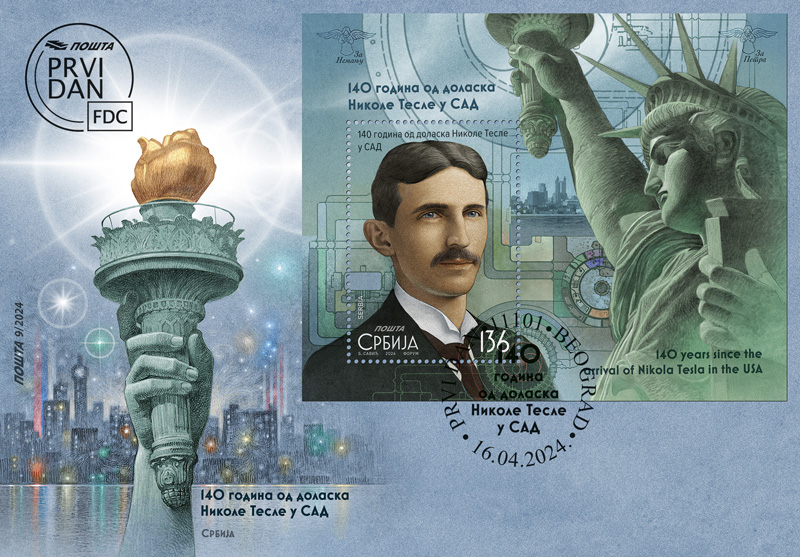
Nikola Tesla began his scientific journey long before leaving for America. A restless spirit and a desire for education led the young Nikola through European academic centres in Graz, Prague, Budapest and Paris, where he gained an education in electrical engineering studies as well as experience in improving electronic equipment.
Two years of study at the Polytechnic Academy in Graz, which was then a meeting place of scientific thought and artistic activity of people from all the countries of Southeast Europe, then studies and research work at the Technical University in Prague, recommended the young engineer Nikola Tesla for the job of chief technician of the American Telephone Company, first in Budapest, and then in Paris. His stay in Budapest resulted in the invention of the telephone sound amplifier. As an engineer for the Edison Company in Paris, he installed an Edison switchboard in Strasbourg that uses the principle of a rotating magnetic field of alternating currents.
У јуну 1884. године Тесла се укрцао на пароброд „City of Richmond” који је пловио за Њујорк. Образовање и искуство које је понео из Европе препоручили су га за посао инжењера у Едисоновој компанији „Едисонове машине” где је требало да ради на репројектовању генератора једносмерне струје. Прогресивне научне идеје и урођена инжењерска радозналост довеле су до тога да Тесла, 1886. године, оснује своју компанију „Тесла електрично осветљење и производња”, отварајући тако генију из Смиљана пут да својим научним деловањем и проналазачким радом човечанству утре пут ка 21. веку.
Nikola Tesla, Serbian by origin, European by education, realized his full potential and engineering genius as a resident of the USA, and he bequeathed his great scientific work to all of humanity, thus demonstrating that scientific thought and progress do not know and do not recognize borders.
Expert collaboration: ”Svetozar Marković” University Library, Belgrade
Artistic realization of the issue: Boban Savić MA, academic painter
Technical details
Date of issue: 16. 04. 2024.
Number of stamps in set: block with 1 stamp
Denomination and printrun:
Block 112: 136.00 RSD, 10.000
FDC: 1
Artistic realization: Boban Savić
Subject: 140 years since the arrival of Nikola Tesla in the USA
Block 112: Portrait of Nikola Tesla
Issue format: block
Dimensions of the block: 100 x 80mm
Dimensions of the stamp in block: 35 x 49.3 mm
Perforations: 13 3/4
Printer: Forum Novi Sad
90 years of standardization in Serbia
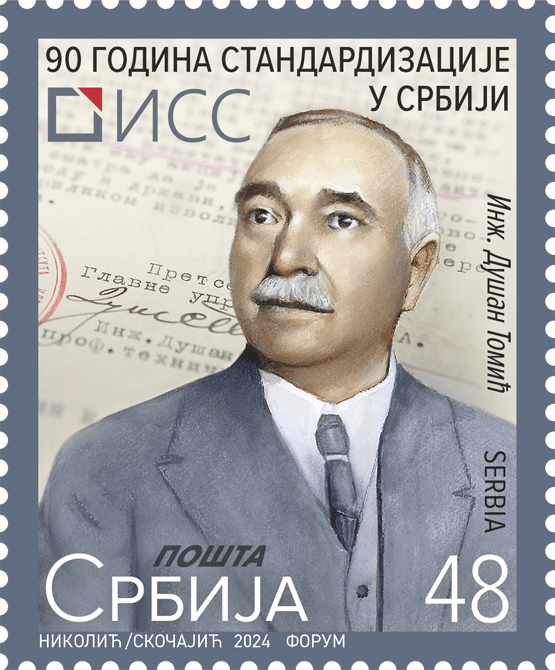
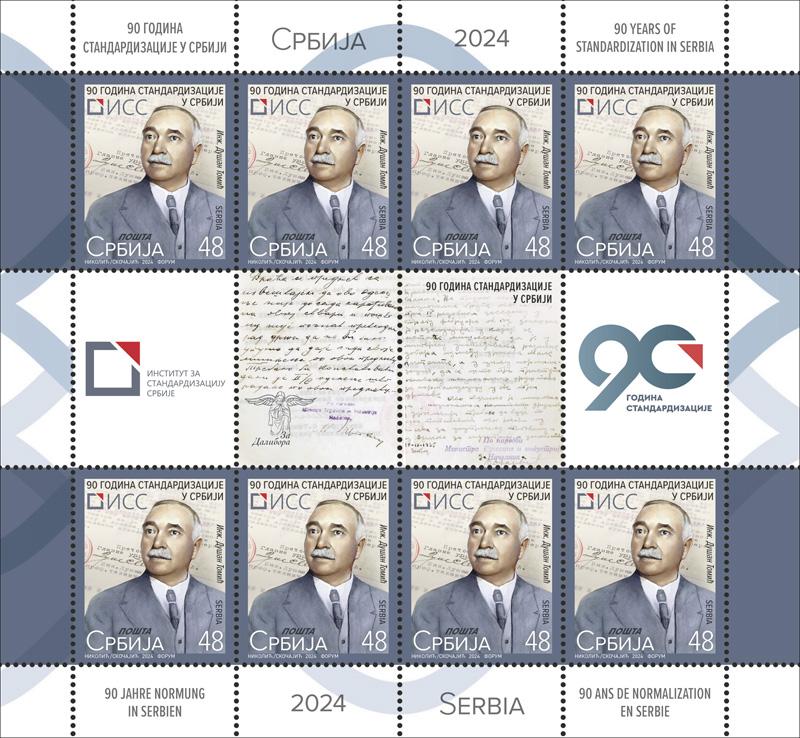
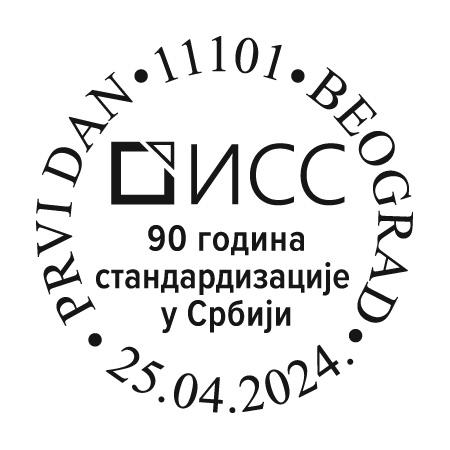
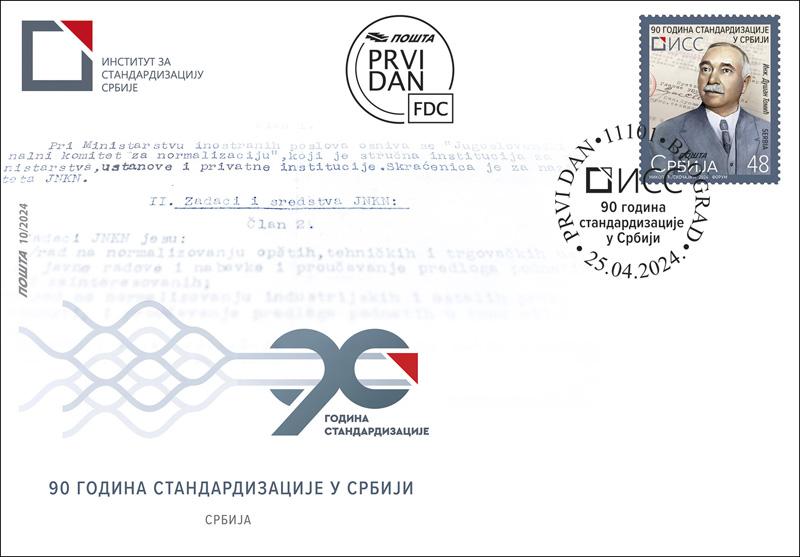
The beginnings of standardization on the territory of today's Serbia can be found as early as the 15th century, in the Law on Mines or the Mining (Novo Brdo) Code of despot Stefan Lazarevic, which contains regulations that regulate the exploration of mineral resources and the performance of mining works.
Starting from the twenties of the twentieth century, some normative documents were created for the needs of the economy, however, there is an increasingly strong awareness of the need for an organized approach to standardization work, especially in the field of mining, electrical engineering and construction. As a result of these aspirations, under the leadership of the Dean of the Technical Faculty in Belgrade and the President of the Association of Engineers and Architects Professor Dušan Tomić, on September 16, 1934, the Yugoslav National Committee for Normalization was formed, the task of which was: "to work on the normalization of general, technical and commercial conditions and regulations for public works and procurement, normalization of products of economic activity, concentration and coordination of activities in the field of normalization". The Committee for Normalization suspended its work in 1941 due to the war, and then continued in December 1944, when it published temporary Standards for the manufacture of military boots and Instructions for the maintenance of footwear. In 1946, the Government of FPRY established the Federal Commission for Standardization, which immediately after the renewal of standardization activities requested to be admitted to the International Organization for Standardization ISO, and since January 1, 1950, it has represented our country as the 28th member.
In the past, the name and legal form of the national standards body changed several times, and the legal successor of all those institutions is today's Institute for Standardization of Serbia (ISS), which is the only national standardization body in the Republic of Serbia. So far, the Institute has published tens of thousands of Serbian standards and related documents, which are harmonized with the corresponding international and European standards.
Professional cooperation: Institute for Standardization of Serbia
Artistic realization: Miroslav Nikolić and Nadežda Skočajić, Academic Graphic Artist
Technical details
Date of issue: 25. 04. 2024.
Number of stamps in set: 1
Denomination and printrun:
1320: 48.00 RSD, 25.000
FDC: 1
Artistic realization: Miroslav Nikolić, Nadežda Skočajić
Subject: 90 years of standardization in Serbia
1320: Portrait of Professor Dušan Tomić, Dean of the Technical Faculty in Belgrade and the President of the Association of Engineers and Architects
Issue format: sheet of 8
Dimensions of stamps: 29 x 35 mm
Perforations: 13 3/4
Printer: Forum Novi Sad
Easter
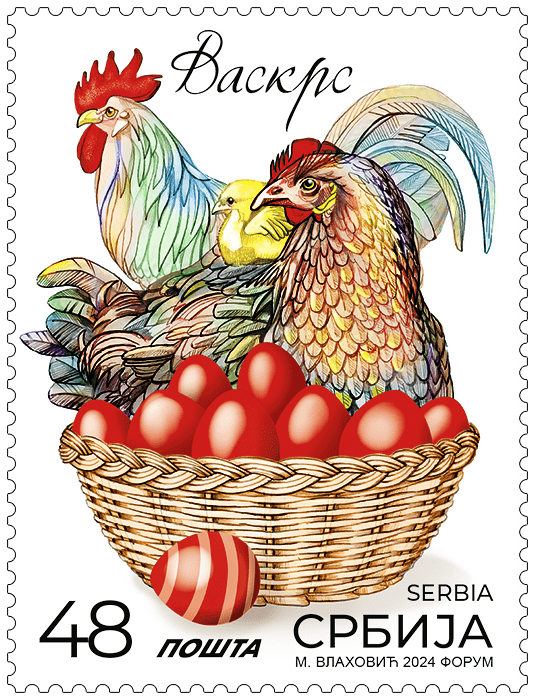
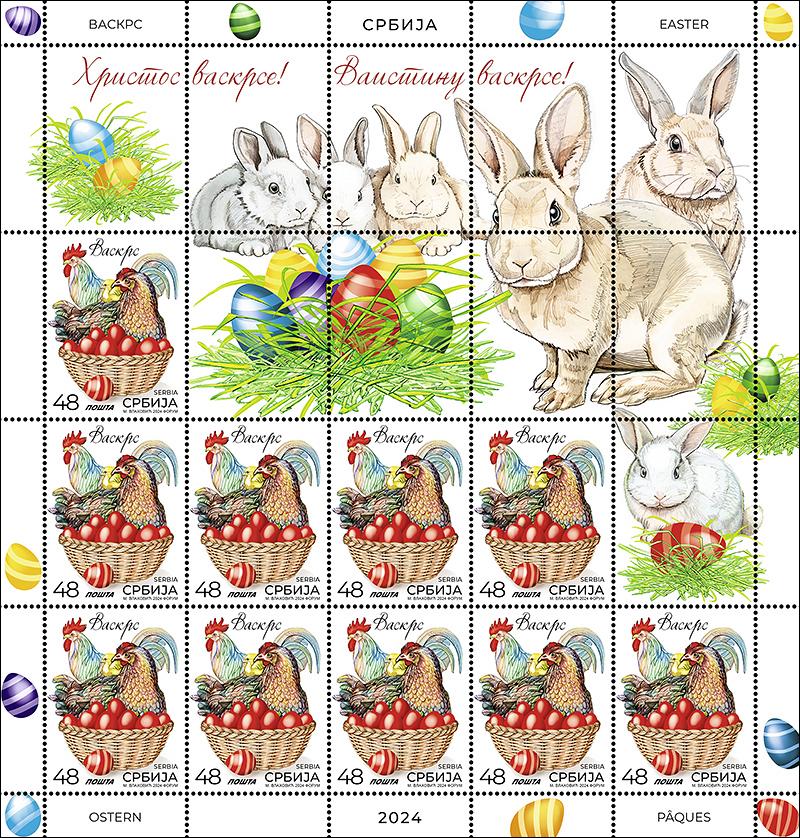
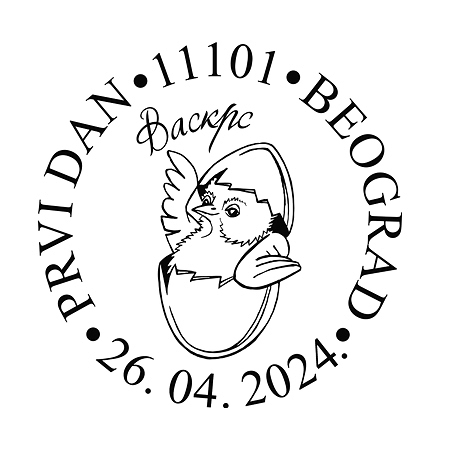
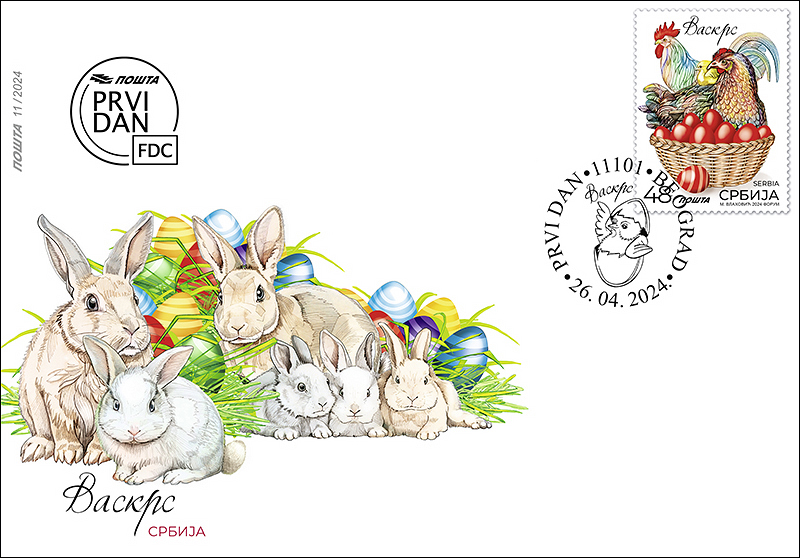
The most important and greatest Christian holiday – the day of eternal joy, the Resurrection of Christ, is celebrated in memory of the day when Christ, the Son of God, defeated death.
Easter is a moving holiday, it is always celebrated on a Sunday, and the date is calculated based on the date of the full moon that preceded Christ´s Resurrection in 30 BC and can fall between 4 April and 8 May according to the Gregorian calendar, or between 22 March and 25 April according to the old Julian calendar. The decision to celebrate the Resurrection of Christ was made at the first Ecumenical Council in Nicaea in 325. The Orthodox Church celebrates Easter according to the Julian calendar.
Easter is preceded by a seven-week fast, and the last week before Easter is called Great. Many folk customs are associated with this week, and the one that children love the most is colouring and giving eggs, which are actually a symbol of Resurrection. The first egg is dyed red and in many parts of our country this egg is called «guardian» and is kept all year, until the next Easter. The Day of Christ´s Resurrection is celebrated with a solemn liturgy in churches, and the believing people are greeted with the words: «Christ is Risen», «Truly He is Risen».
Artistic realisation of the issue: MA Marija Vlahovic, academic graphic artist
Technical details
Date of issue: 26. 04. 2024.
Number of stamps in set: 1
Denomination and printrun:
1321: 48.00 RSD, 25.000
FDC: 1
Artistic realization: Marija Vlahović
Subject: Easter
1321: Basket full of red painted eggs as a symbol of Easter
Issue format: sheet of 10
Dimensions of stamps: 31,9 x 42 mm
Perforations: 13 3/4
Printer: Forum Novi Sad
Friends who come from afar
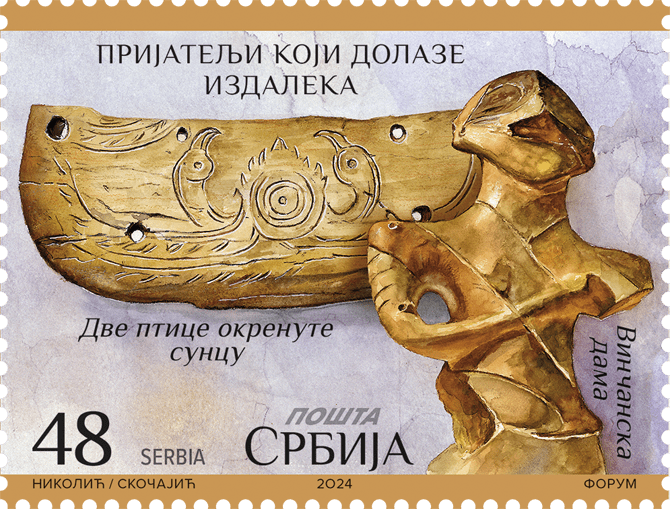
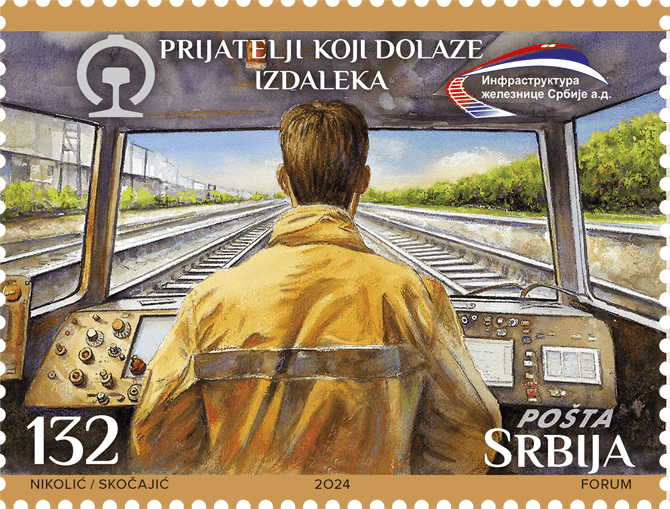

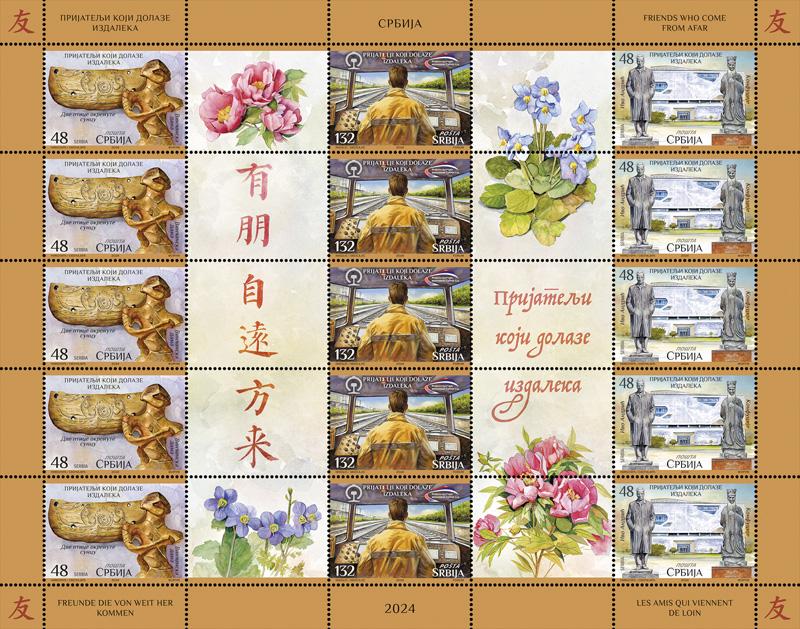
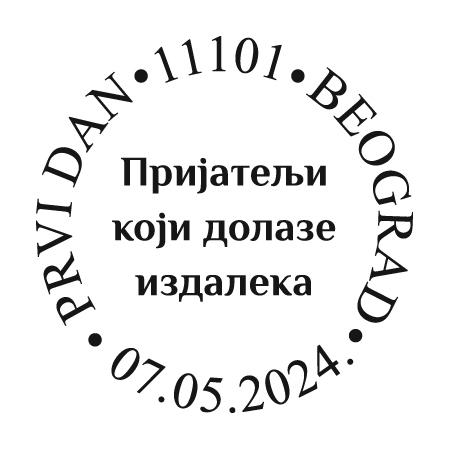
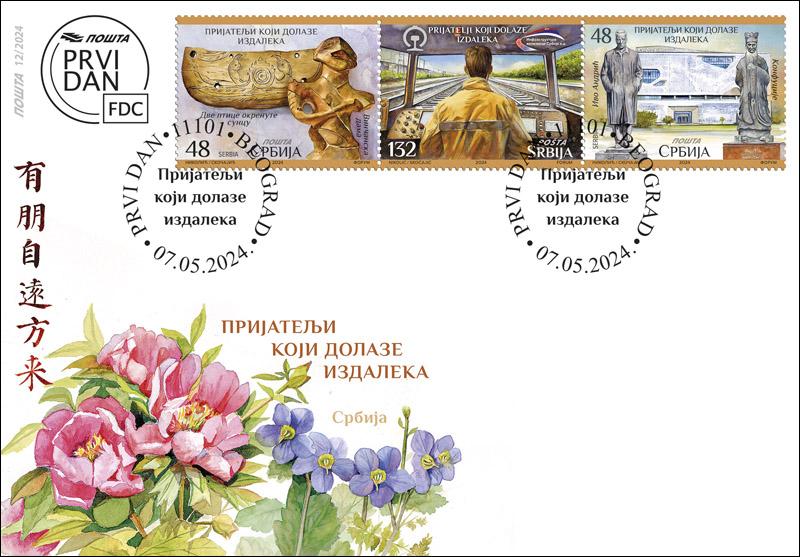
China and Serbia stand as testament to rich histories and vibrant cultures, intertwined through a bond of enduring friendship. Through triumphs and challenges, they have stood together, united in pursuit of mutual prosperity and shared values of fairness and justice. In June 2016, Chinese President Xi Jinping embarked on a historic visit to Serbia, marking the genesis of the China-Serbia Comprehensive Strategic Partnership. As President Xi Jinping returns for his second visit in May 2024, the iron-clad friendship between China and Serbia is poised to take on new glory.
Motifs on the stamps: Hemudu Culture and Vinča Culture: Echoes of History in Dialogue Belgrade-Budapest Railway: A Benchmark of Cooperation for the ‘Belt and Road’ Initiative Cultural Centers: A Stage for Cultural Exchanges between China and Serbia
Expert collaboration: China Media Group, China Cultural Center in Belgrade
Artistic realization: Miroslav Nikolić and Nadežda Skočajić, academic graphic artist
Technical details
Date of issue: 07. 05. 2024.
Number of stamps in set: 3
Denomination and printrun:
1322: 48.00 RSD, 25.000
1323: 132.00 RSD, 25.000
1324: 48.00 RSD, 25.000
FDC: 1
Artistic realization: Miroslav Nikolić and Nadežda Skočajić
Subject: Friends who come from afar
1322: Hemudu Culture and Vinča Culture: Echoes of History in Dialogue
1323: Belgrade-Budapest Railway: A Benchmark of Cooperation for the ‘Belt and Road’ Initiative
1324: Cultural Centers: A Stage for Cultural Exchanges between China and Serbia
Issue format: sheet of 15
Dimensions of stamps: 42 x 31,9 mm
Perforations: 13 3/4
Printer: Forum Novi Sad
Europe – Underwater fauna and flora
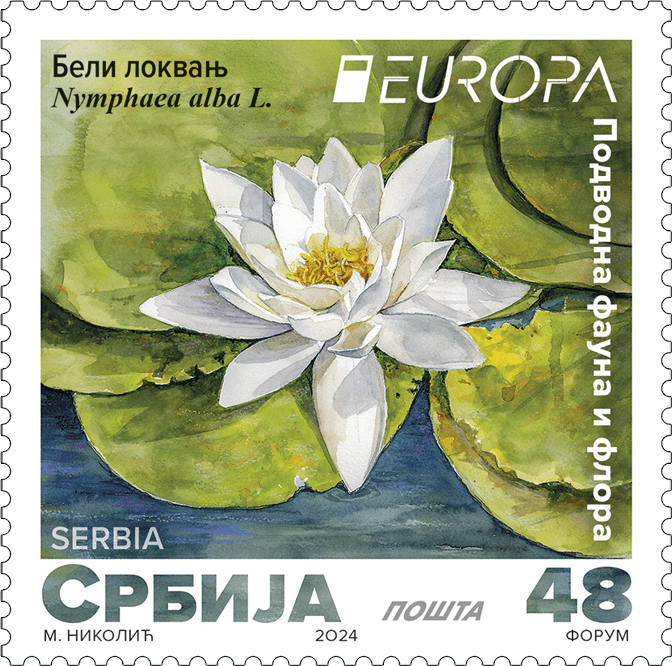
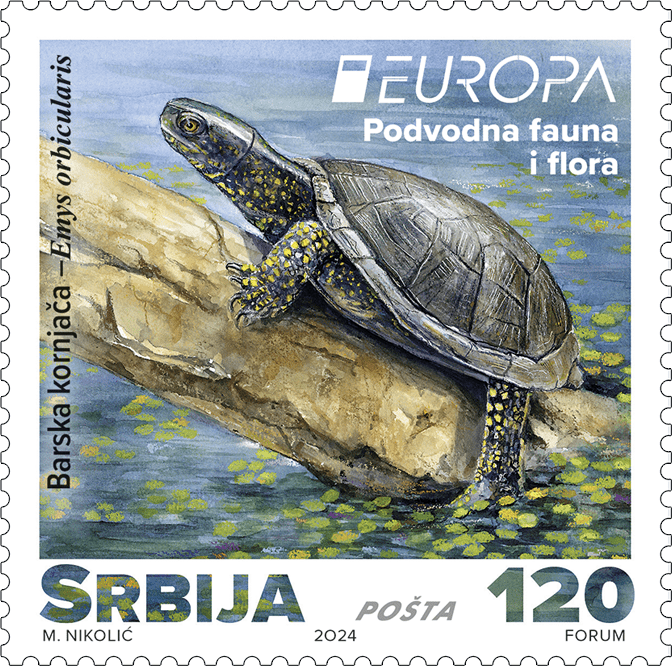
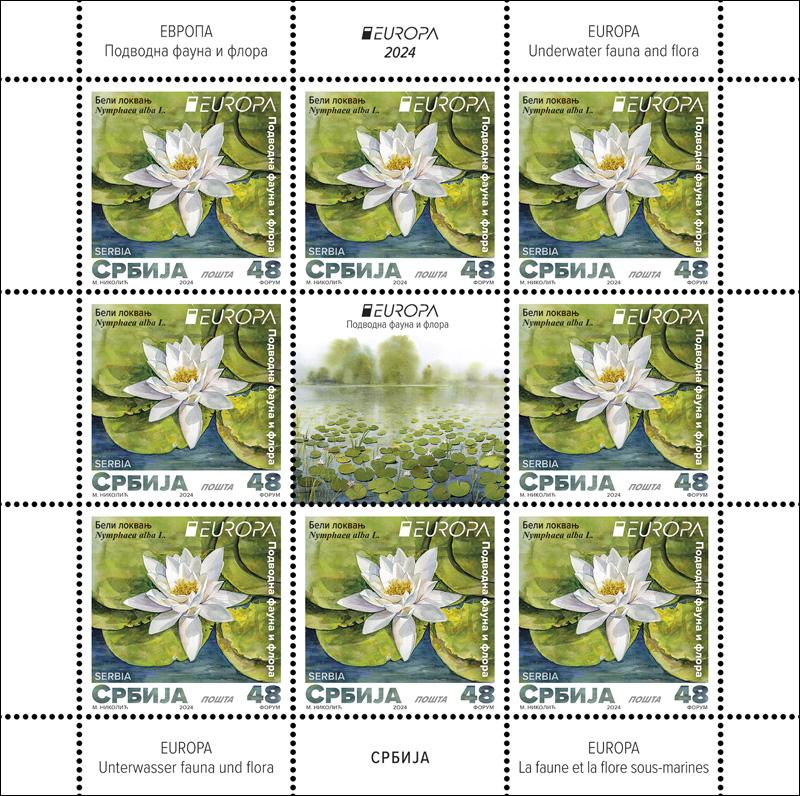
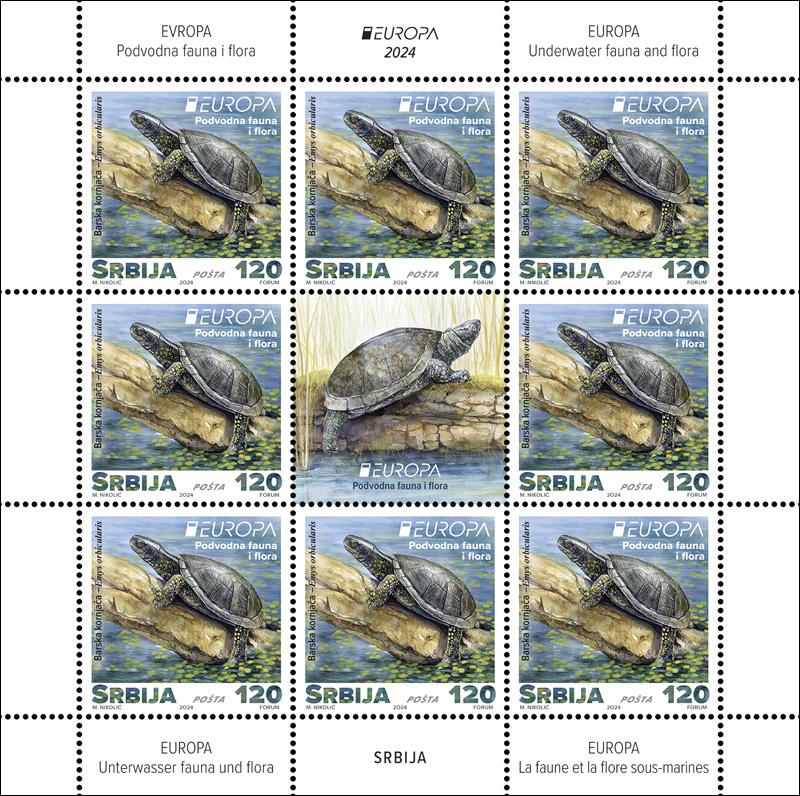
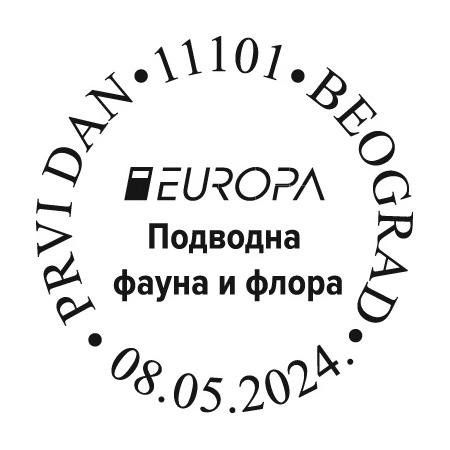
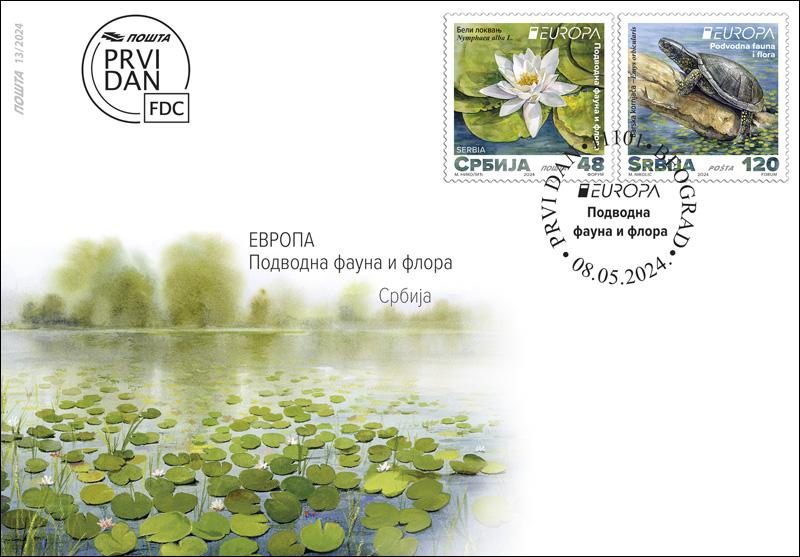
White Water-lily – Nymphaea alba L.
White water-lily belongs to the water-lily family (Nymphaeaceae) and a group of aquatic plants called hydrophytes. Water-lily is a perennial, herbaceous, rooted plant, the rhizome of which is placed horizontally and is located in the mud. The leaves are large, round with a deep cut, on long petioles, and can be submerged or float on the surface of the water. The face of the leaf is shiny, with a thick layer of cuticle that protects it from water retention and rotting. The shiny surface of the leaf reflects the sun´s rays, so that excessive temperature does not occur on the surface of the leaf. The flowers are above the surface of the water, large and individual, white, sometimes pink. The plant blooms from June to September.
Water-lilies inhabit stagnant and slow-flowing waters, such as ponds, moors, along rivers and canals. In the world, within this family, there are 8 genera with about 70 taxa, of which two genera (Nymphaea L. and Nuphar Sm.) are present in Serbia with one species each – white water-lily (Nymphaea alba L.) and yellow water-lily (Nuphar lutea (L.) Sm.).
European pond turtle – Emys orbicularis
The European pond turtle belongs to the Emydidae family and it is the only species of water turtle native to the territory of Serbia. It inhabits all types of stagnant inland bodies of water with rich aquatic vegetation – ponds, puddles and lakes - where the soil is muddy and overgrown with plants. Its shell is of a regular oval shape, and its size varies from 15 to 38 cm. Adult females are larger than the males. The head of the European pond turtle is dark, sprinkled with yellow spots. The feet are webbed, the toes ending in long claws. The color of the shell ranges from dark brown to black sprinkled with yellowish dots in varying amounts. The European pond turtle is mainly a carnivore. It swims and dives well, and it can stay under water for several hours. It does not move far from its aquatic habitat during the day, and it undertakes larger land trips at night. It usually spends the winter hibernating buried in the mud at the bottom of the body of water it lives in.
Professional cooperation: Museum of Natural History in Belgrade, Ana Paunović, PhD, Museum Advisor, Uroš Buzurović, PhD, Senior Curator, Scientific Associate; Marjan Niketić, PhD, Museum Advisor, Corresponding Member of SASA
Artistic realisation: Miroslav Nikolić
Technical details
Date of issue: 08. 05. 2024.
Number of stamps in set: 2
Denomination and printrun:
1325: 48.00 RSD, 25.000
1326: 120.00 RSD, 25.000
FDC: 1
Artistic realization: Miroslav Nikolić
Subject: Europe – Underwater fauna and flora
1325: White Water-lily – Nymphaea alba L.
1326: European pond turtle – Emys orbicularis
Issue format: sheet of 8
Dimensions of stamps: 35 x 34,8 mm
Perforations: 13 3/4
Printer: Forum Novi Sad
Stamp Day - 150 years since the establishment of the Universal Postal Union
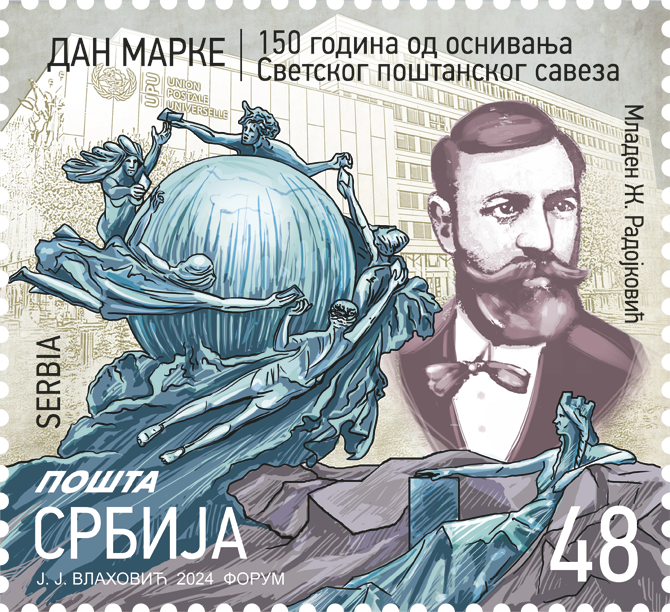
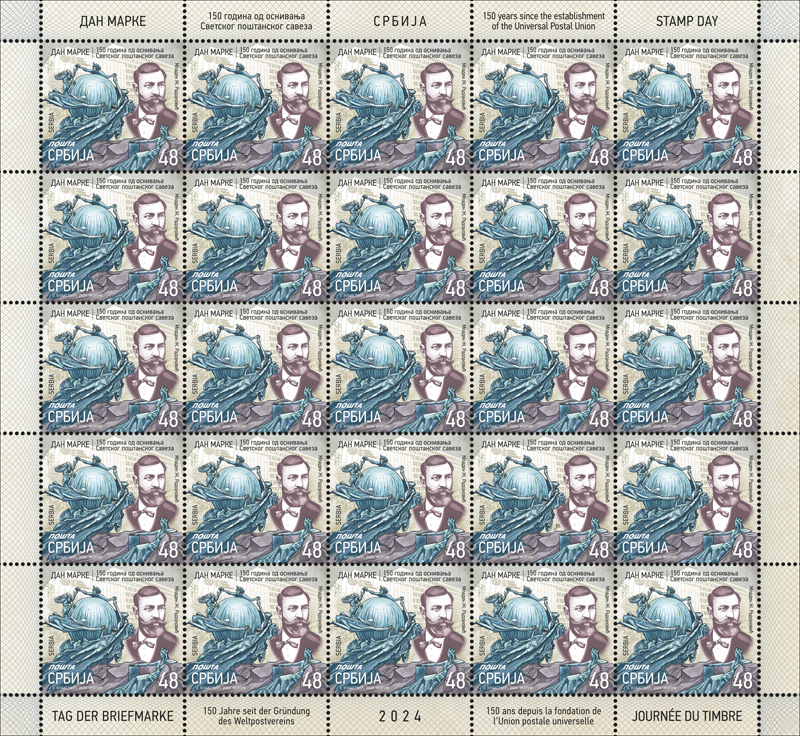
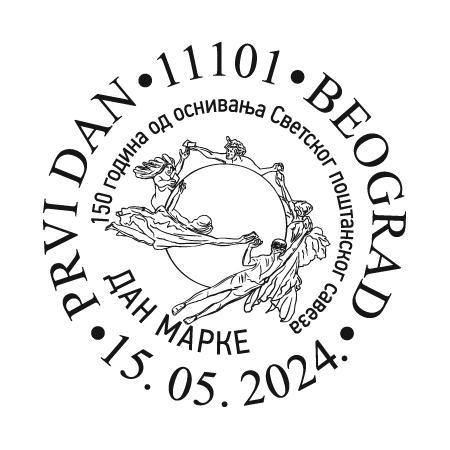

Human development and fast industrialization in the 19th century necessitated the intensification of international postal traffic, so in 1868 the first postal conference was held in Paris, where guidelines were adopted on the expansion and development of international cooperation in the field of postal traffic.
The first Universal Postal Congress was held in Bern, from September 15 to October 9, 1874. The Congress was attended by authorized representatives of 22 countries, which covered an area of about 350 million km2 with more than 350 million inhabitants: Austria, Belgium, Great Britain, Greece, Denmark, Egypt, Italy, Luxembourg, Germany, Norway, Portugal, Romania, Russia, United States of America, Serbia, Turkey, Hungary, France, Netherlands, Switzerland, Sweden and Spain. During the session of the Congress, Montenegro also joined the Union, and some countries that were colonies of some of the founding countries also joined.
On October 9, 1874, in Bern, as a delegate of the Principality of Serbia, Mladen Ž. Radojković, Secretary of the Postal and Telegraph Department of the Ministry of National Economy, signed the Treaty on the Establishment of the General Postal Union, later known as the Universal Postal Union.
Today, the Universal Postal Union is an international organization, a member of the United Nations, which operates on the principles of unity of postal territory, freedom of postal transit and unity of letterpost fees, with the aim of developing and improving postal traffic. This global organization, which gathers 192 member states, establishes rules for international mail exchange and makes recommendations to encourage the growth of the volume of postal, parcel and financial services as well as to improve the quality of service for customers.
Expert collaboration: Vladimir Milić, Union of Philatelists of Serbia
Artistic realization of the issue: MA Jakša Vlahović, academic graphic artist
Technical details
Date of issue: 15. 05. 2024.
Number of stamps in set: 1
Denomination and printrun:
1327: 48.00 RSD, 25.000
FDC: 1
Artistic realization: Jakša Vlahović
Subject: Stamp Day – 150 years since the establishment of the Universal Postal Union
1327: Monument-symbol of UPU, portrait of Mladen Ž. Radojković, the UPU's headquarters building in Berne
Issue format: sheet of 8
Dimensions of stamps: 35 x 31,9 mm
Perforations: 13 3/4
Printer: Forum Novi Sad
75th artistic season of the Ensemble "Kolo"

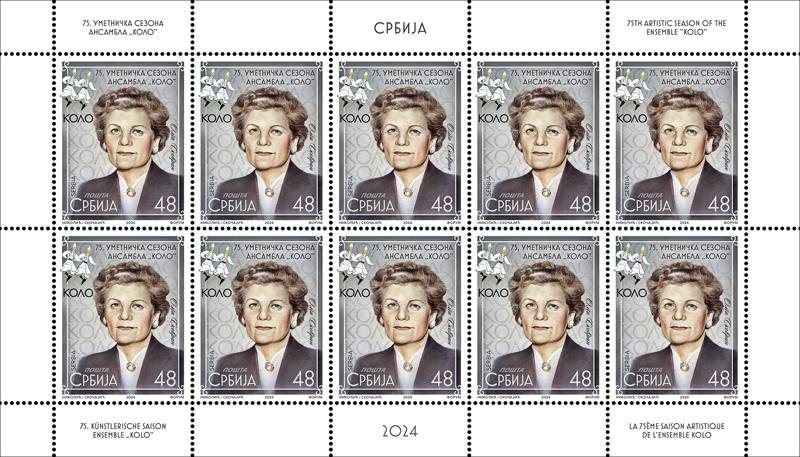
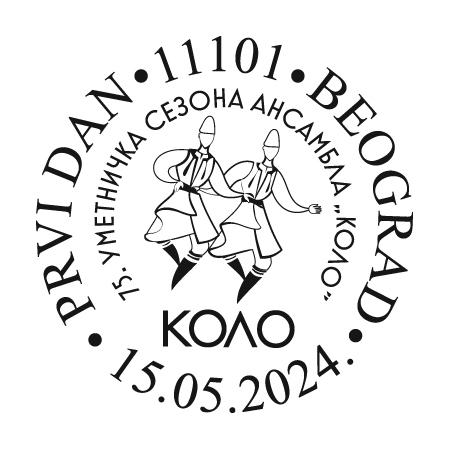

The ensemble of folk dances and songs of Serbia, KOLO, was founded in 1948 as the first ensemble of this type in Yugoslavia at the time. Although founded as the Ensemble of the People's Republic of Serbia, KOLO performed the role of the central ensemble of folk dances and songs of the former state, nurturing in its repertoire the traditions of all the peoples and nationalities of Yugoslavia.
Having its foundation in artistic ideals of the second half of the 20th century, KOLO levitated for decades between the inherited ideology of Yugoslavia and native affiliation. In the jubilee 75th year of its existence, KOLO partially transitioned into the National Ensemble of Folk Dances and Songs of the Republic of Serbia, striving to develop its own capacities for the benefit of the national culture and cultural policy of our country. At the current moment, KOLO artistically interprets the traditional folk dances and music of Serbia, including the ethnic practices of all national minorities living in it, while equally treating the traditions of the Serbian people who, as an autochthonous population, have inhabited the wider Serbian cultural space for centuries. Bringing its activities into harmony with the official public policies of the Republic of Serbia and prioritized strategic goals in culture, KOLO strives for its own (re)affirmation as an institution of primary national importance.
LONG LIVE KOLO!
Professional cooperation: Ensemble of folk dances and songs of Serbia “KOLO”
Artistic realization: Miroslav Nikolić and Nadežda Skočajić, Academic Graphic Artist
Technical details
Date of issue: 15. 05. 2024.
Number of stamps in set: 1
Denomination and printrun:
1328: 48.00 RSD, 25.000
FDC: 1
Artistic realization: Miroslav Nikolić and Nadežda Skočajić
Subject: 75th artistic season of the Ensemble "Kolo"
1328: portrait of Olga Skovran, logo of Ensemble "Kolo"
Issue format: sheet of 10
Dimensions of stamps: 33,35 x 42 mm
Perforations: 13 3/4
Printer: Forum Novi Sad
75 years since the founding of the Yugoslav Film Archive

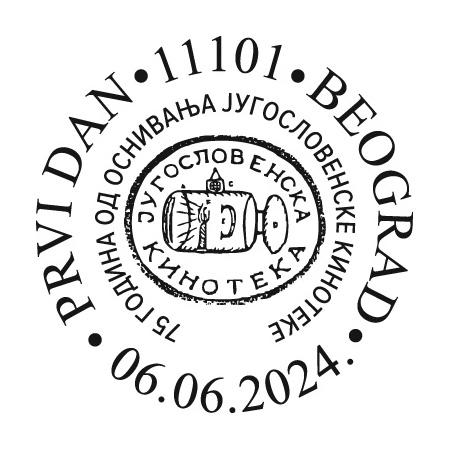
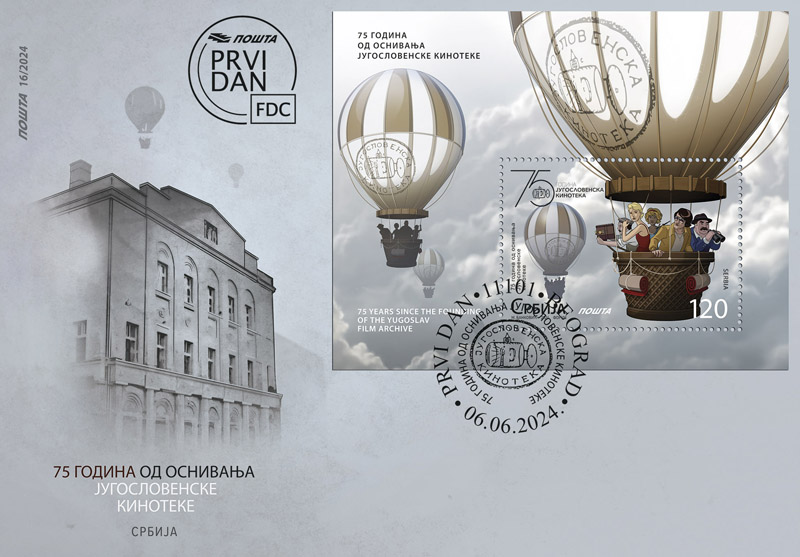
The Yugoslav Film Archive was founded in 1949 and two years later became a regular member of the International Federation of Film Archives (FIAF).
The Film Archive started with only two hundred unsorted boxes of nitrate films, but the fund grew rapidly and already in 1964, the Yugoslav Film Archive became one of the richest film archives in the world.
The collection of the Film Archive today numbers around 100,000 copies, with 12,000 copies created from 1896 to 1953, when filming was done on flammable film tape. In the collection of Serbian films, the documentary film "The Coronation of King Peter the First Karađorđević" from 1904 and the first Serbian feature film "The Life and Deeds of the Immortal Leader Karađorđe", filmed in Belgrade in 1911, stand out for their historical and cultural significance.
The Film Archive also includes a photo library that stores a large number of photographs from domestic and foreign films and a collection of film posters. The collection of items consists of exhibits from the history and prehistory of film, such as the original camera of the Lumière brothers from 1896, the first studio film camera – the Lifka camera, the Edison phonograph and many other. In the Film Archive Library, there are tens of thousands of books, magazines, film catalogues, scripts and recording books.
The Film Archive Museum deals with film and exhibition programs, and in 2020 the permanent exhibition "Our Film Museum" was opened, which presents the most significant works and creators of Serbian and Yugoslav cinema, and includes the legacies of the following film artists: Milena Dravić and Dragan Nikolić, Pavle Vuisić, Velimir Bata Živojinović, Živojin Pavlović, Ružica Sokić, Ljubiša Samardžić, Veljko Despotović, Miomir Denić, Karl Malden and others.
During the last decade, the Film Archive has been actively involved in the restoration of our film heritage, and so far in this process it has restored close to 50 representative titles of Serbian feature films. Film Archive Day is celebrated on June 6 as the day when the first film screening was held in Belgrade and in the Balkans – in 1896 in the tavern "Golden Cross" at Terazije.
Professional collaboration: Jovan Marković, Yugoslav Film Archive
Artistic realization: Milisav Banković, Animation Director
Technical details
Date of issue: 06. 06. 2024.
Number of stamps in set: block with 1 stamp
Denomination and printrun:
Block 113: 120.00 RSD, 10.000
FDC: 1
Artistic realization: Milisav Banković
Subject: 75 years since the founding of the Yugoslav Film Archive
Block 113: Actors-characters from popular domestic movies in flying balloon with logo of Yugoslav Film Archive
Issue format: block
Dimensions of the block: 94 x 74 mm
Dimensions of the stamp in block: 49,3 x 35 mm
Perforations: 13 3/4
Printer: Forum Novi Sad
170 years of vocational education in Serbia
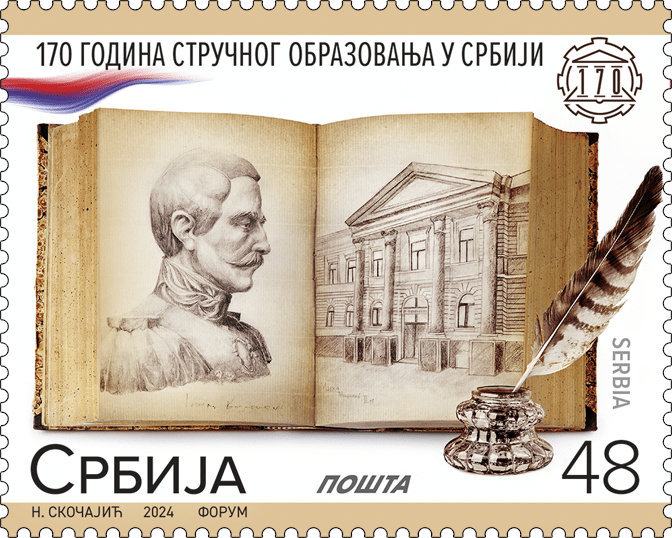
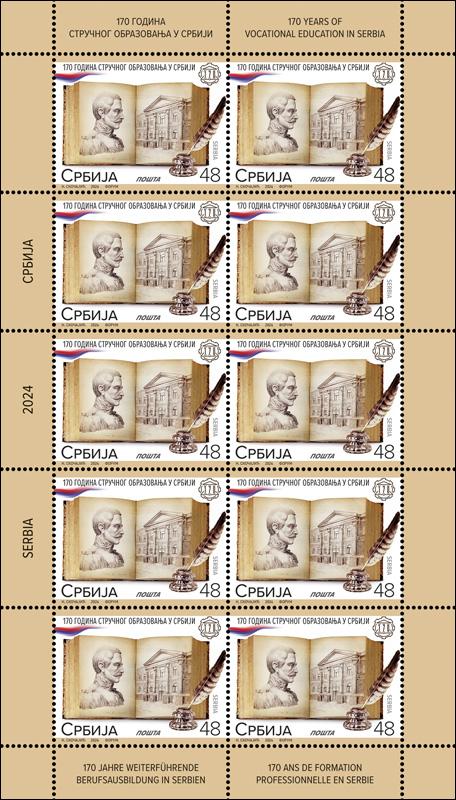
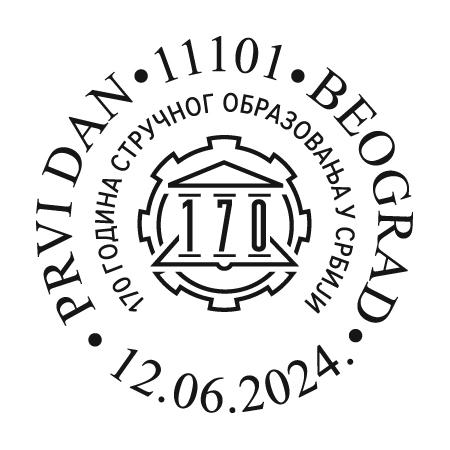

By the Decree of Prince Aleksandar Karađorđević in March 1854, the first vocational school in Serbia was founded – the First Vocational School, for the planned and systematic preparation of personnel necessary for the new military factory (Topolivnica). The proposal to establish a boarding-type school, based on the model of vocational schools in France, was sent to the Prince by Charles Loubry at the end of 1853. The school, with notable success, participated in science and technology fairs in Paris in 1889 and London in 1898. By the Decree from 1867, the school was named the Military-Vocational School. The school resumed its work in 1888 through the efforts of the Director of the Institute, Pavel Šafárik, and received the status of a secondary school. The Military-Vocational School grew into a leading vocational school in the Balkans in the time before the First World War. Before the Second World War, only trades necessary for the military industry were represented in the school programme. The new teaching plan adopted in 1940 could not be implemented due to the outbreak of war.
The Military-Industrial School in Kragujevac was founded in September 1946 by the Ministry of National Defence at the "Crvena Zastava" Institute. From the school year 1994/1995, new courses in the traffic profession were started, and in 1996, the school was named the Technical School for Mechanical Engineering and Traffic. In 2009, the school was named the Polytechnic School and provided students with general and specialist theoretical and practical knowledge that enabled them to quickly and easily join the world of work, but also to successfully continue further education.
The Secondary Vocational School was founded by the Decision on the establishment of the Secondary Vocational School in Kragujevac and the abolition of the Polytechnic School and the Second Technical School in Kragujevac. As of September 1, 2018, the Polytechnic School and the Second Technical School, the origin and development of which are closely related, once again became one institution, under the name Secondary Vocational School. By merging these two schools, the offer was further enriched. In addition to mechanical engineering, traffic, and electrical engineering, forestry, wood processing and culture, art and public information were also added.
Today, the school is called Secondary School "Knez Aleksandar Karađorđević".
For the stamp motifs, the following were used: the portrait of Prince Aleksandar Karađorđević, the work of student Ivona Bogdanović and drawing of the school building, the work of student Marko Milanović.
Professional cooperation: Siniša Kojić, Director of Secondary School “Knez Aleksandar Karađorđević”.
Graphic realization: Nadežda Skočajić, Academic Graphic Artist.
Technical details
Date of issue: 12. 06. 2024.
Number of stamps in set: 1
Denomination and printrun:
1329: 48.00 RSD, 25.000
FDC: 1
Artistic realization: Nadežda Skočajić
Subject: 170 years of vocational education in Serbia
1329: portrait of Prince Aleksandar Karađorđević and drawing of the school building Issue format: sheet of 10
Dimensions of stamps: 42 x 33,35 mm
Perforations: 13 3/4
Printer: Forum Novi Sad
200th Anniversary of the birth of Branko Radičević
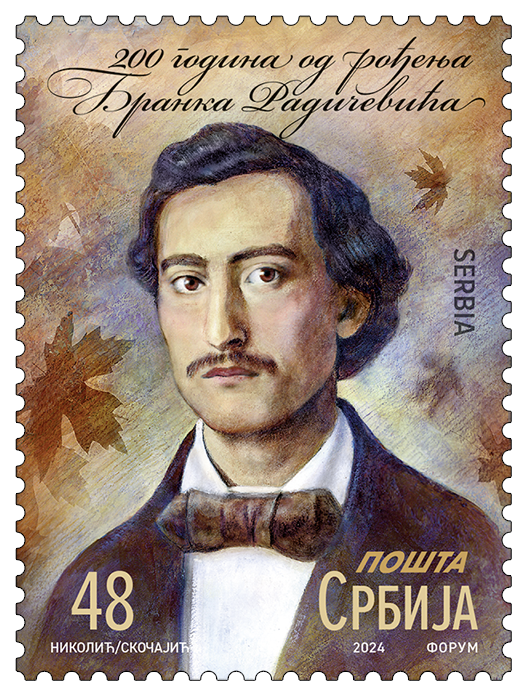
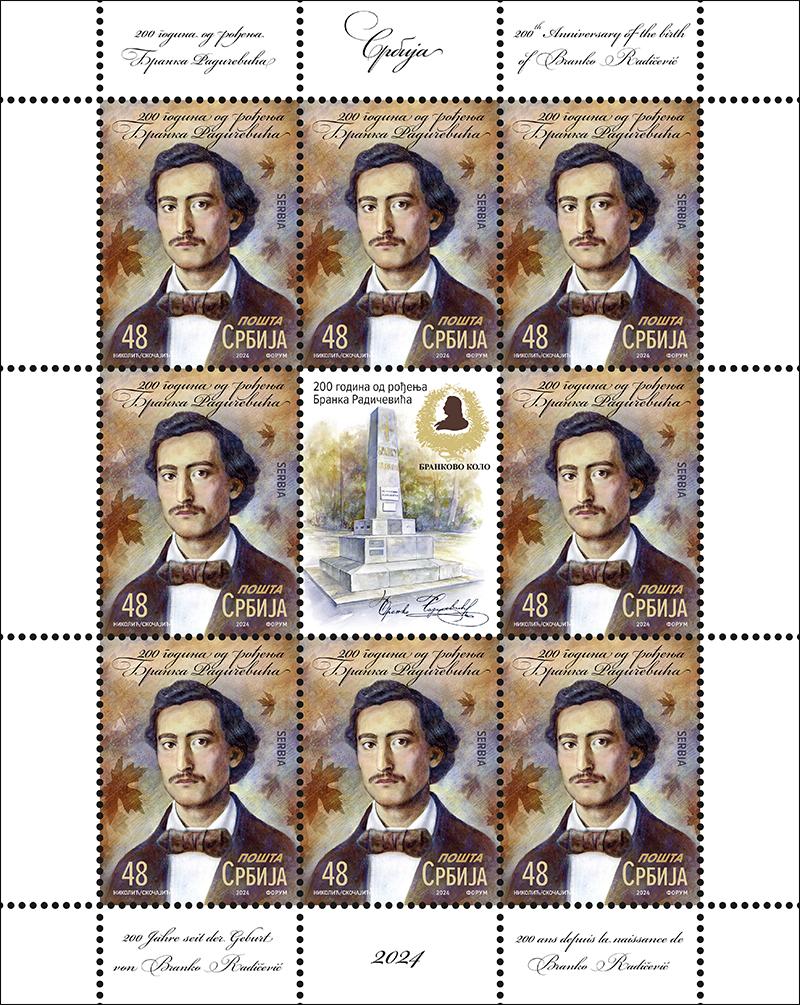
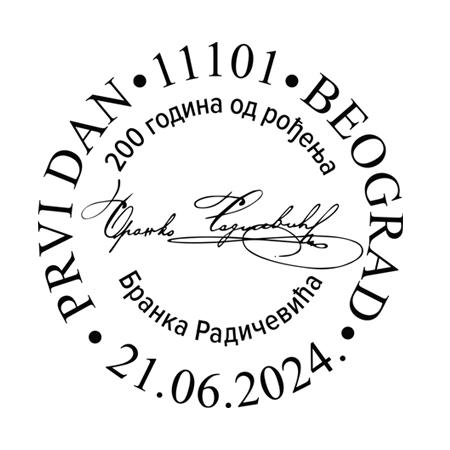
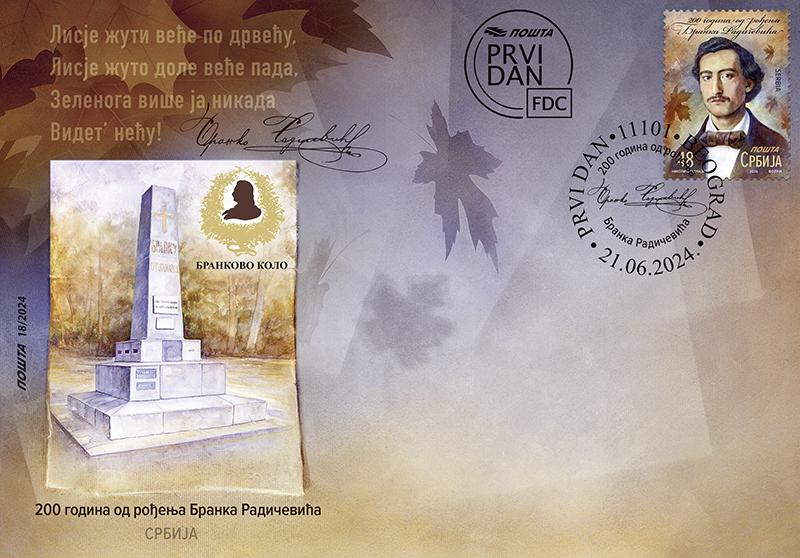
Branko Radičević (Slavonski Brod, March 28, 1824 – Vienna, July 1, 1853), a great poet of Serbian romanticism, introduced revolutionary changes in the development of Serbian literature and language. He was born to his father Todor and mother Ruža just before the holiday of St. Alexius, after whom he got his baptismal name. He lived in Slavonski Brod (Brod na Savi) with his family until 1830. Until 1835, he studied at Serbian and German elementary schools in Zemun. From 1835 to 1841, he studied at the Karlovac Gymnasium – "the most excellent student" with calligraphic handwriting and the best herbarium with plants from Stražilovo. In Timisoara from 1841 to 1843, he studied philosophy. There he writes his first poem in Serbian – Girl at the Well. He moved to Vienna to study law, which he did not like.
With the publication of his first book, "Poems" (1847), he translated his name from Greek (Alexios) into Serbian – Branko, and his first poetic debut caused a tectonic upheaval on the literary scene. With the encouragement of Vuk Stefanović Karadžić, the divinely inspired Branko brings into Serbian poetry the ozone-pure beauty of the vernacular language as opposed to the artificial Slavonic Serbian in the literary use of that era.
He contracted tuberculosis and died in 1853 at the age of twenty-nine. After three decades (1883), his remains were transferred from Vienna to Stražilovo. On Stražilovo, there is a monument made of mountain blocks from the areas where Serbs live: Fruška gora, Dinara, Klek, Lovćen, Plješevica, Vršački Breg, Velebit and Avala. On the top of the marble monument, in golden letters it says: TO BRANKO – THE SERBIAN PEOPLE. It is the sign of the libertarian Kolo (circle dance) from the poem The Parting of School Friends, in which Branko invites all Serbs who suffer under the yoke of the Austrian and Turkish empires to unite, naming them after the regions, (sub)regions and areas where they have always lived.
Even though he wrote only fifty-four lyrical poems, seven epics, two fragments of epics, a handful of letters and one response to criticism, the importance of Branko Radičević is epochal and inspiring for new generations. Many of the poems are anthological: As I Thought of Dying, Prayer, Reprimand, Curse, (Nikad nije vito tvoje telo), In Memory of Mina Karadžić (Pevam danju, pevam noću), Fisherman's Dream, Sorrow and Admonition, Mischief, A Traveller at Dawn and others. There are about a hundred musical compositions based on Branko's verses that leave the impression that the people themselves created these poems.
Professional cooperation: Nenad Grujičić, “Brankovo kolo”
Artistic realization: Miroslav Nikolić and Nadežda Skočajić, Academic Graphic Artist
Technical details
Date of issue: 21. 06. 2024.
Number of stamps in set: 1
Denomination and printrun:
1331: 48.00 RSD, 25.000
FDC: 1
Artistic realization: Nadežda Skočajić
Subject: 200th Anniversary of the birth of Branko Radičević
1331: portrait of Branko Radičević
Issue format: sheet of 8
Dimensions of stamps: 42 x 33,35 mm
Perforations: 13 3/4
Printer: Forum Novi Sad
Serbia – Canada
100 years since the birth of Milomir Glavčić
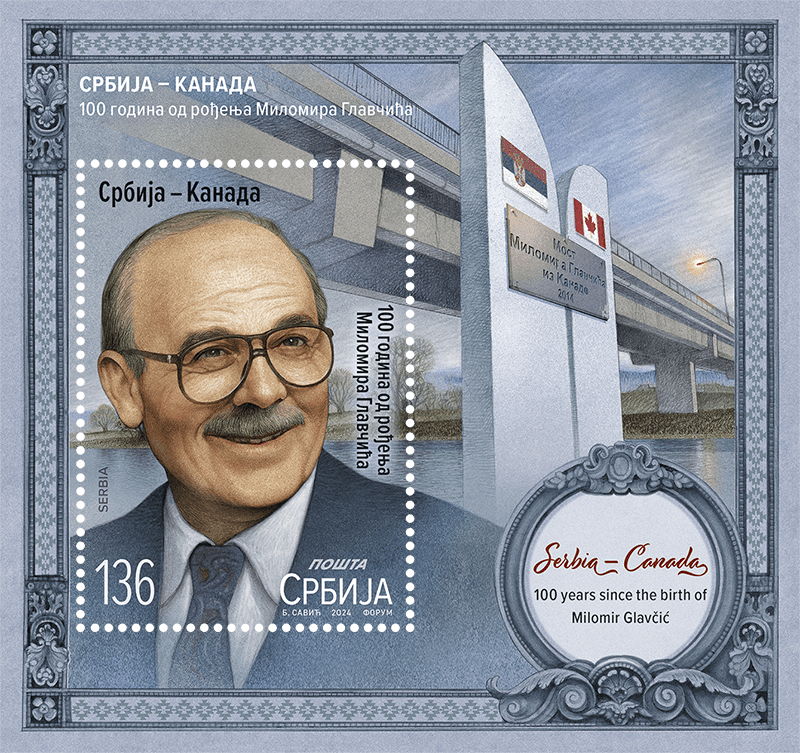
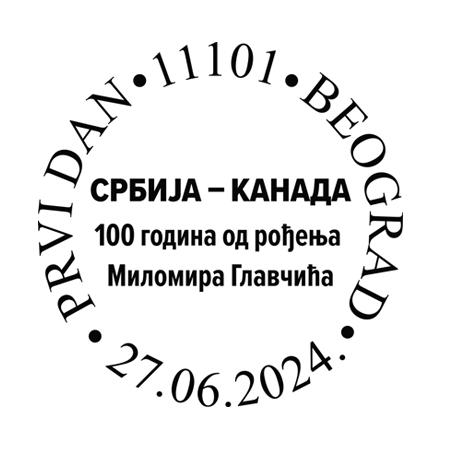
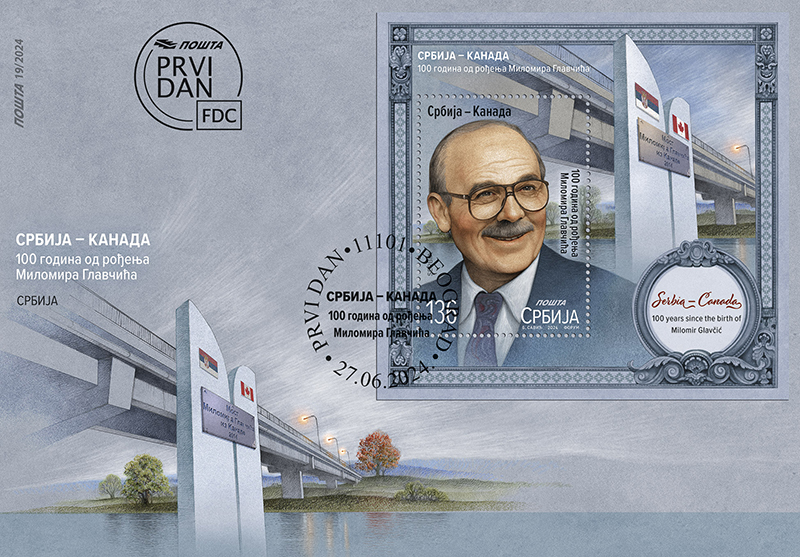
Diplomatic relations between Serbia and Canada were formally established only in 1941, but today a large and influential Serbian community has been present in this North American country since the end of the 19th century.
One of the most prominent residents of Canada of Serbian origin, Milomir Glavčić, a native of the village of Pope near Jošanička Banja, the Canadian with the longest residential address in Niagara Falls, is celebrating his hundredth birthday this year.
Born on 6 December, 1924, he spent his childhood and youth in pre-war Yugoslavia in misery and poverty. After the end of the Second World War, he settled in Canada, where, through hard and thoughtful work, he managed to acquire wealth for himself and others.
Milomir Glavčić is a true member of the world of humanity and philanthropy. He helped people regardless of religion and nation. In Canada, he invested considerable funds for the construction of a church and a hospital in Niagara Falls, and in his native Serbia, he helped build a bridge over the Ibar in Kraljevo, which not only connected the banks of this river, but also two countries – Canada and Serbia, and today the cities of friends – Kraljevo and Niagara Falls, as evidenced by the markings on this building.
He also financed the construction of churches, kindergartens, centres of culture, library buildings, asphalting of roads, and renovation of elementary schools. He donated medical devices and ambulances to hospitals in Kraljevo and Raška. He helped, and continues to help, both close and distant relatives, but also hundreds of unknown families. In Serbia, his charity is kept from being forgotten. Streets, a boulevard, a kindergarten, and a cultural centre are named after him in the area of the Raški district. He is the winner of numerous awards, as well as the highest state and church awards. In Canada, as a sign of respect, on his 99th birthday, Niagara Falls were painted with the colours of the Serbian flag.
Thanks to Milomir Glavčić, in 2015 the first Serbian–Canadian Friendship Charter in modern history was signed, which is a significant step in the improvement of bilateral relations between the two countries, especially in terms of cultural exchange and economic cooperation and investments.
Artistic realization of the issue: Boban Savić MA, academic painter
Technical details
Date of issue: 27. 06. 2024.
Number of stamps in set: block with 1 stamp
Denomination and printrun:
Block 114: 136.00 RSD, 10.000
FDC: 1
Artistic realization: Boban Savić
Subject: Serbia – Canada: 100 years since the birth of Milomir Glavčić
Block 114: The bridge and the portrait of Milomir Glavčić
Issue format: block
Dimensions of the block: 85 x 80 mm
Dimensions of the stamp in block: 35 x 49,3 mm
Perforations: 13 3/4
Printer: Forum Novi Sad
110 years of commemoration of the heroes of the First World War
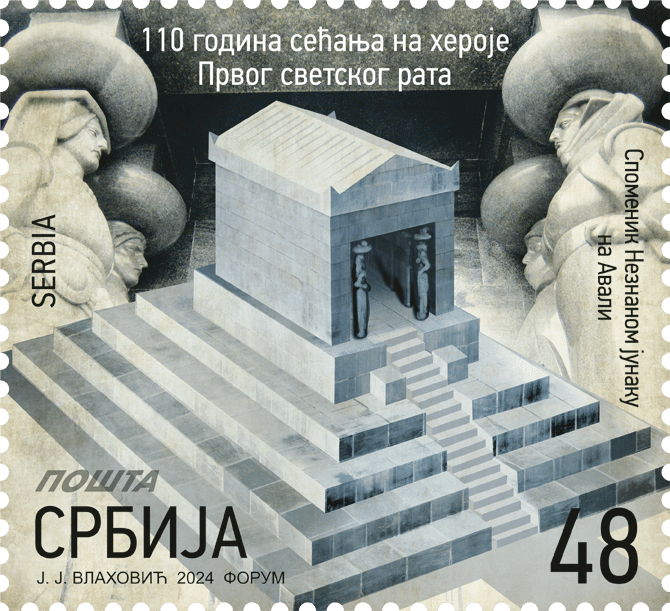
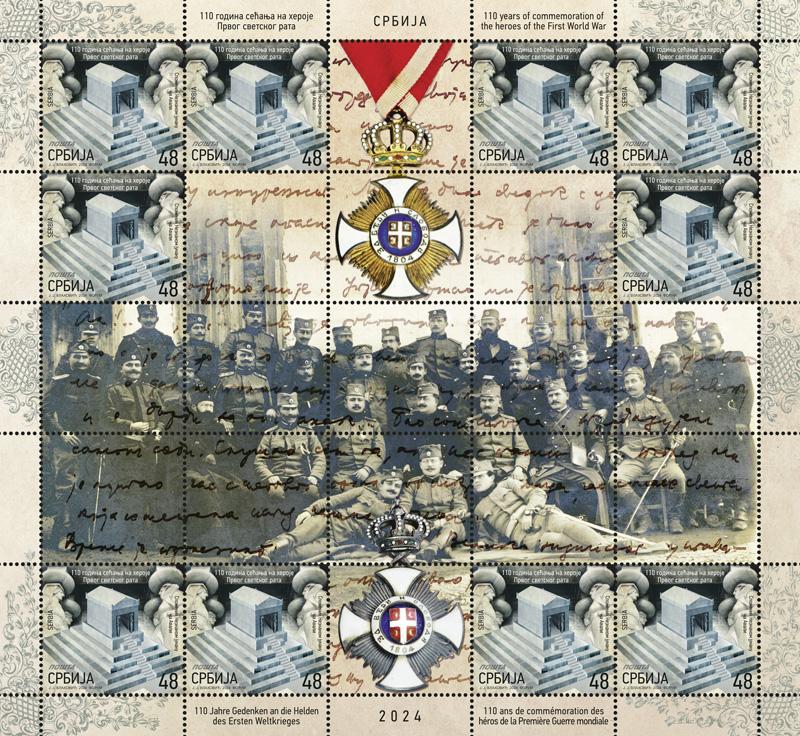
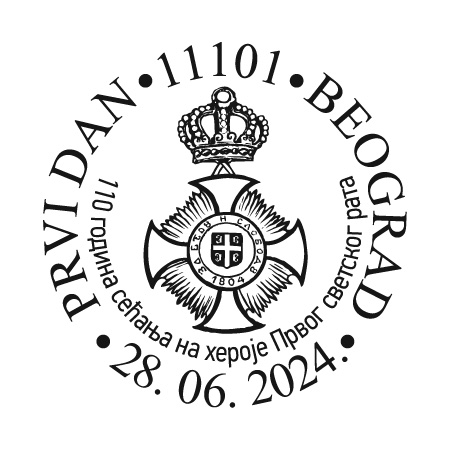
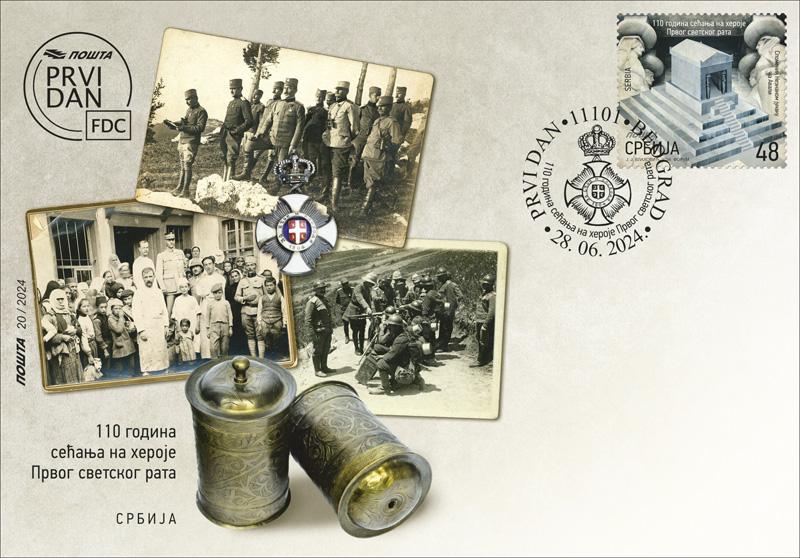
This year we mark 110 years since the beginning of the First World War, one of the largest military conflicts in the history of civilization, in which more than 70 million people under arms participated. The army of the small Balkan state of Serbia will be remembered for its heroic epic, which began with the Battle of Cer in 1914, the first allied victory in the First World War against the incomparably more numerous Austro-Hungarian forces, followed by the Albanian Golgotha in 1915 and the landing on Corfu in 1916, continuing with the great and significant victory at Kaimaktsalan in 1916 and finally, the breakthrough of the Thessaloniki front in 1918 and the proud rush to the final liberation of the Homeland.
During the entire war, Serbian soldiers stood out for their courage, endurance, resilience and chivalry, despite the difficult conditions and enemy superiority. The civilian population in occupied Serbia suffered terribly due to the occupation and war operations, but still remained determined to support their soldiers in the fight for freedom, showing national unity and solidarity.
Serbia emerged from the First World War as one of the victorious countries, but it paid for it with huge losses – it is estimated that more than a million people were killed or wounded during the war that forever changed the course of history.
Stamp motif: Monument to the Unknown Hero on Avala, Ivan Meštrović, 1938.
Motifs on the vignettes: Heroes – Serbian soldiers from the period of the First World War and Serbian decorations; from the collection of the Adligat Society, the legacy of Leko family.Motifs on the First Day Cover: photos of heroes – Serbian soldiers and civilians from the First World War period and artillery shells that Serbian soldiers engraved, processed into cups and used in the trenches; from the collection of the Adligat Society, the legacy of Leko family.
Professional cooperation: Society for culture, art and international cooperation Adligat, Belgrade.
Artistic realization of the issue: MA Jakša Vlahović, academic graphic artist
Technical details
Date of issue: 28. 06. 2024.
Number of stamps in set: 1
Denomination and printrun:
1333: 48.00 RSD, 25.000
FDC: 1
Artistic realization: Jakša Vlahović
Subject: 110 years of commemoration of the heroes of the First World War
1333: Monument to the Unknown Hero on Avala
Issue format: sheet of 10
Dimensions of stamps: 35 x 31,9 mm
Perforations: 13 3/4
Printer: Forum Novi Sad
185 YEARS OF DIPLOMATIC RELATIONS BETWEEN SERBIA AND FRANCE
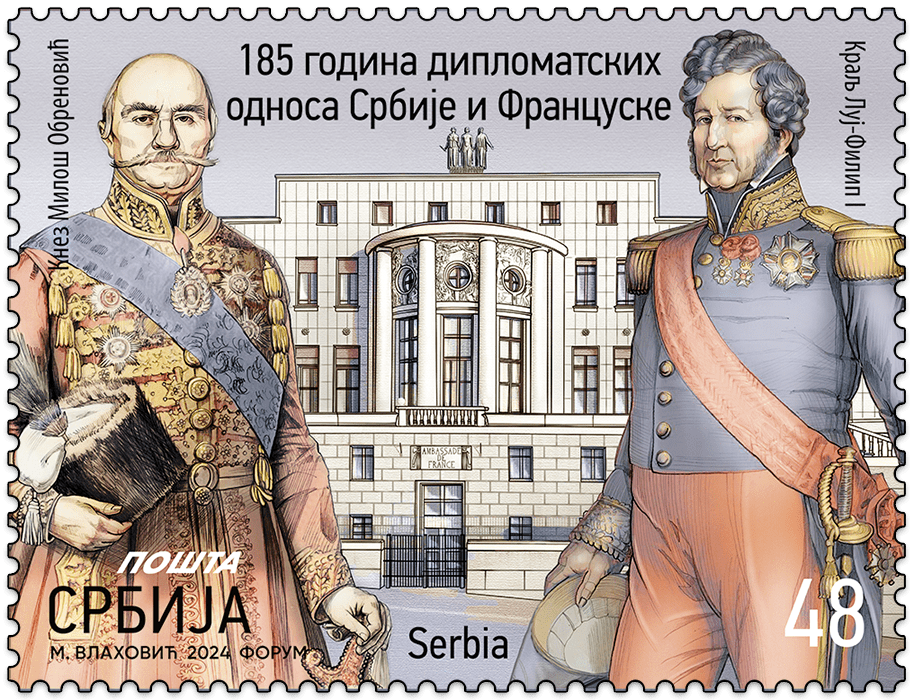

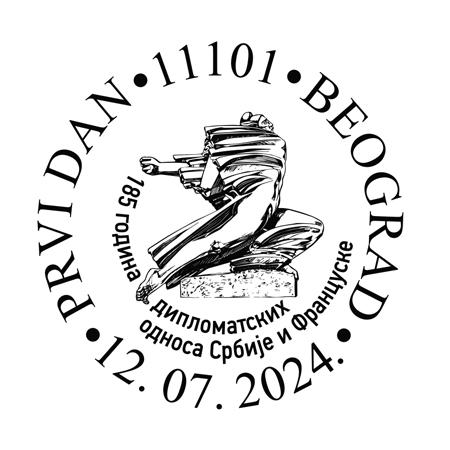
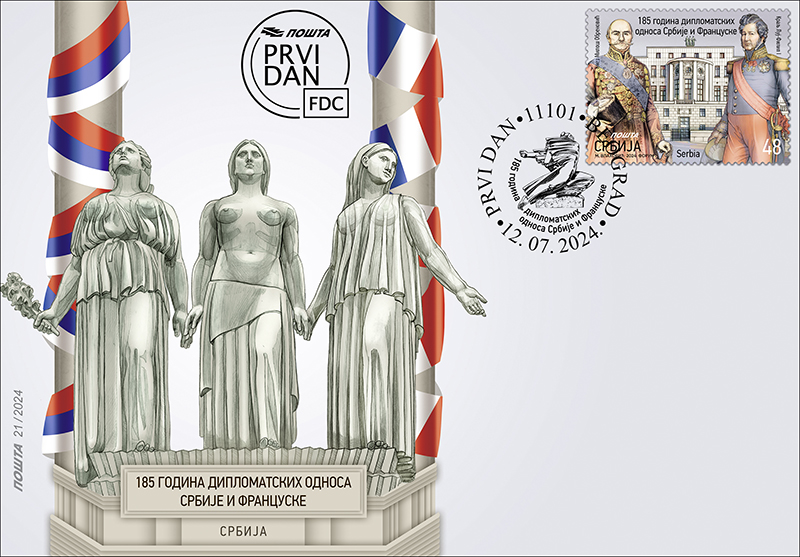
Serbia and France established contacts as early as the Middle Ages, as evidenced by the marriage of King Uroš with Princess Jelena of Anjou. The modern era brings new contacts between the two countries at the beginning of the 19th century, at the time of the First Serbian Uprising, and the formal establishment of diplomatic relations took place in 1839, when France opened the first consulate in the Principality of Serbia. The second half of the 19th century brought an intensification of relations and cultural influence brought to Serbia by numerous ”French students”, among whom were members of both Serbian dynasties, which led to the strengthening of French friendship with Serbia, which was especially confirmed by the alliance in the First World War, when France stood by Serbia from the beginning, helping it financially, but also through numerous medical missions, treating Serbian wounded in French hospitals, educating Serbian pupils and students in French schools and finally, in brotherhood in arms – the joint battles of Serbian and French soldiers at the Salonica front. Today, Belgrade is the only city outside of France to be awarded the Legion of Honour, and Belgrade’s bohemian district of Skadarlija is the only one in the world that is twinned with Montmartre in Paris.
The friendship between Serbia and France was confirmed by the fight against the common enemy – Nazism, during the Second World War, as well as by economic cooperation in the 20th century, and bilateral relations in the 21st century have seen an increase in the formation of a strategic partnership between the two countries, recent visits by top officials and the personal friendship of the presidents of the two countries. Economic cooperation has been intensively developing in the last few years, and France has been among the biggest investors in the Serbian economy and the most important foreign trade partners of Serbia for years.
Motif on the stamp: Prince Miloš Obrenović and King Louis-Philippe I
Motif on the vignette: Monument of gratitude to France at Kalemegdan in Belgrade, work of sculptor Ivan Meštrović; building of the Embassy of the Republic of France in Belgrade
Motif on the envelope: Freedom, Equality, Fraternity, sculpture on the building of the Embassy of France in Belgrade
Artistic realisation of the issue: MA Marija Vlahovic, academic graphic artist
Technical details
Date of issue: 12. 07. 2024.
Number of stamps in set: 1
Denomination and printrun:
1334: 48.00 RSD, 25.000
FDC: 1
Artistic realization: Marija Vlahović
Subject: 185 years of diplomatic relations between Serbia and France
1334: Prince Miloš Obrenović and King Louis-Philippe I
Issue format: sheet of 10
Dimensions of stamps: 42 x 31,9 mm
Perforations: 13 3/4
Printer: Forum Novi Sad
140 years of railway infrastructure construction in Serbia

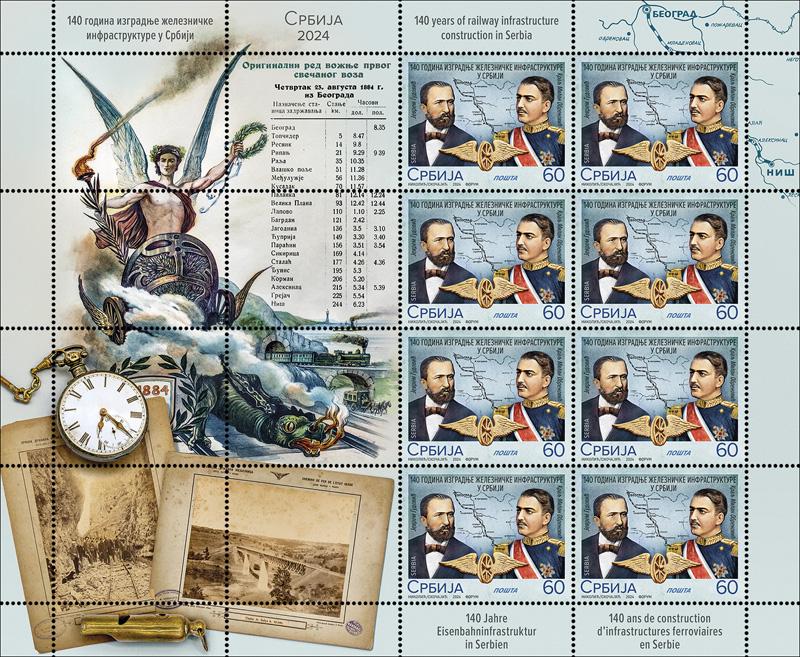
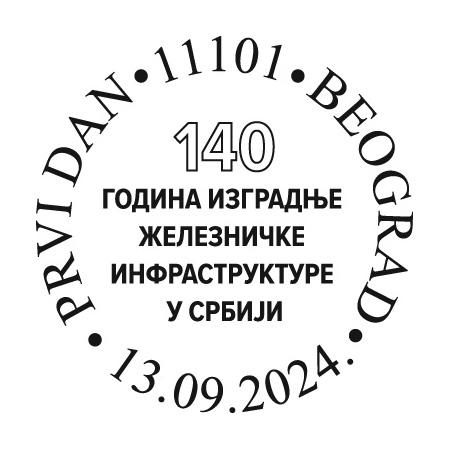
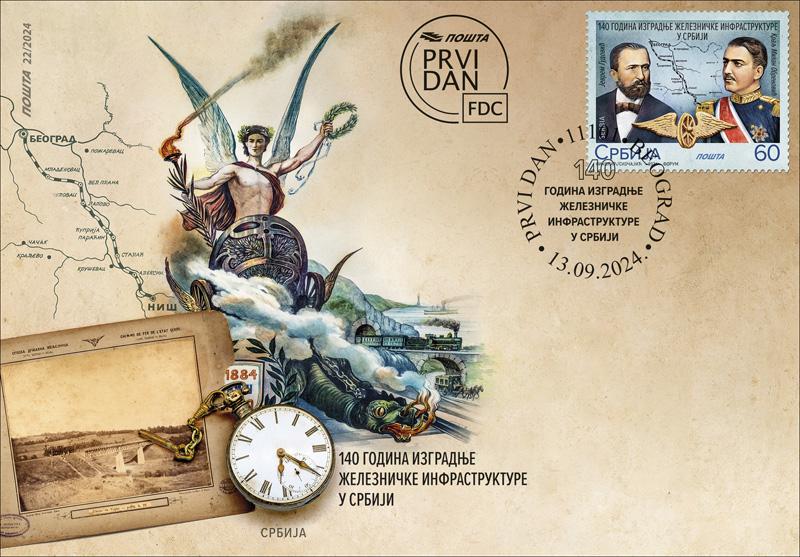
The first half of the 19th century brought to Europe intensive economic development, industrial and civil revolution throughout the continent, struggles for the liberation of peoples and the emergence of new states.
After the Berlin Congress, which confirmed the independence of Serbia as an independent state and expanded its borders, intensive work began on the implementation of plans for the development of railway traffic, which primarily involved the connection between the Austro-Hungarian Empire and the Ottoman Empire through the territory of the Principality of Serbia, in which the young state saw its strategic interest, since Austria–Hungary undertook to connect its railway network with the planned first Serbian railway near Belgrade, via the Sava bridge.
The agreement signed by the two countries stipulated 1883 as the deadline for the completion of the construction of the first Serbian railway. Works on the construction of railway infrastructure in Serbia were led by the Ministry of Construction headed by Minister Jevrem Gudović. At the big ceremony held on the occasion of the start of the construction works, on July 3, 1881, in the presence of members of the Government, the state leadership and a large number of dignitaries, near today’s Mostar interchange in Belgrade, Prince Milan Obrenović used a silver pickaxe to symbolize laying of the foundation for the first Serbian railway on the route Belgrade–Niš.
The construction of the railway began in the Principality of Serbia, and the first train ran through the new railway, 243 kilometres long, in the Kingdom of Serbia, because Serbia had become a kingdom in the meantime. The first, ceremonial train, left Belgrade for Niš on September 4, 1884. Regular railway traffic began operating on September 15 of the same year.
Serbian Railways celebrates this day every year as Railway Day.
Motifs: portraits of King Milan Obrenović and Minister Jevrem Gudović; facsimile of the timetable of the first ceremonial train from August 23, 1884; the “Winged wheel” symbol and an illustration from a framed tableau from the permanent exhibition “Train engineers of the Niš boiler room 1884–1910”; railway pocket watch “Zenit”, 1884; sound signalling device – a whistle; photographs “Railway construction in the Sićevo Gorge”, “Ralja Viaduct on railway route Belgrade–Vranje” (1885) and “Viaduct Veliki potok, on the railway route Belgrade–Vranje” (1885) and a map of the railway route Belgrade–Niš.
Professional cooperation and material for motifs: Railway Museum as part of Serbian Railways
Artistic realization: Miroslav Nikolić and Nadežda Skočajić, academic graphic artist
Technical details
Date of issue: 13. 09. 2024.
Number of stamps in set: 1
Denomination and printrun:
1335: 60.00 RSD, 25.000
FDC: 1
Artistic realization: Miroslav Nikolić, Nadežda Skočajić
Subject: 140 years of railway infrastructure construction in Serbia
1335: portraits of King Milan Obrenović and Minister Jevrem Gudović; facsimile of the timetable of the first ceremonial train from August 23, 1884; the “Winged wheel” symbol and an illustration from a framed tableau from the permanent exhibition “Train engineers of the Niš boiler room 1884–1910”; railway pocket watch “Zenit”, 1884; sound signalling device – a whistle; photographs “Railway construction in the Sićevo Gorge”, “Ralja Viaduct on railway route Belgrade–Vranje” (1885) and “Viaduct Veliki potok, on the railway route Belgrade–Vranje” (1885) and a map of the railway route Belgrade–Niš.
Issue format: sheet of 8
Dimensions of stamp: 42 x 33,35 mm
Perforations: 13 3/4
Printer: Forum Novi Sad
100 years of the Belgrade Archdiocese

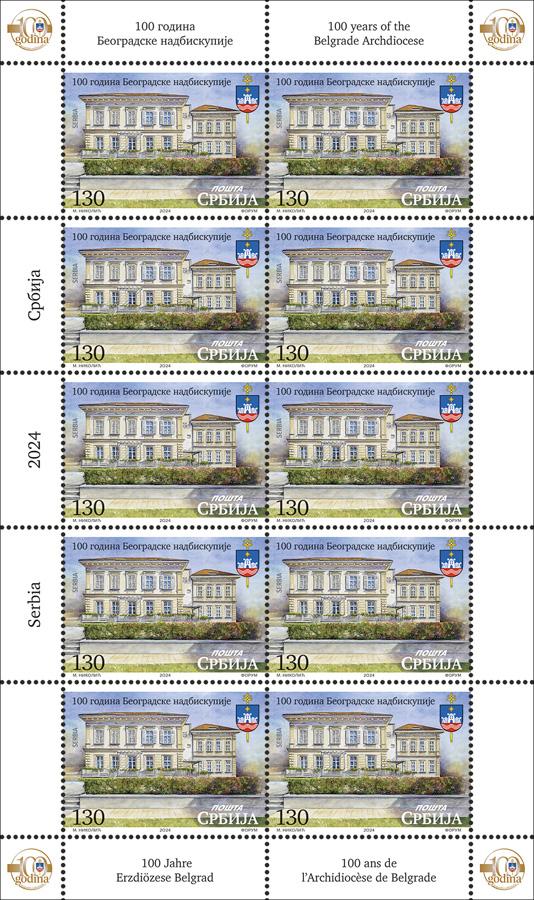
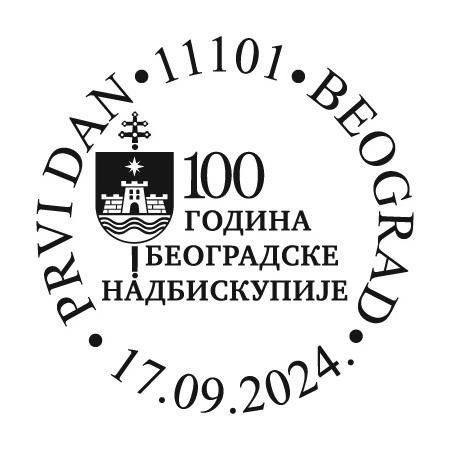
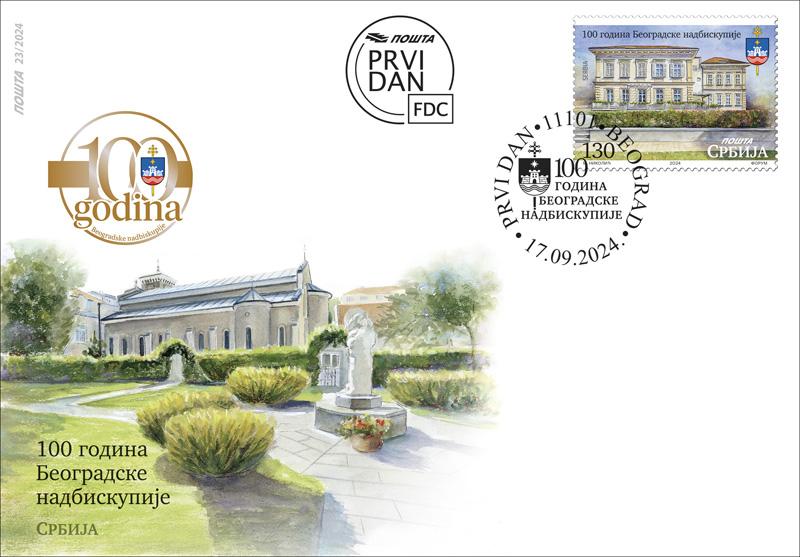
In Singidunum, today›s Belgrade, there was a bishop,s seat already in the 4th century AD. The turbulent history of Belgrade over the centuries caused insufficient knowledge about church organization during the early and later Middle Ages, and in later history, we note the presence of titular bishops and apostolic administrators until the 20th century.
The Concordat between the Holy See and the Kingdom of Serbia in 1914 provided for the establishment of an archdiocese based in Belgrade, which took place ten years later. The first bishop of the Belgrade Archdiocese was Rafael Rodić, who entered the ministry in 1924.
Today, the Belgrade Archdiocese, headed by Archbishop Ladislav Nemet as of November 5, 2022, includes Serbia without Vojvodina and consists of around 25,000 believers. It is divided into 16 parishes, five in Belgrade and one each in Valjevo, Šabac, Bor, Zaječar, Niš, Aleksinac, Kraljevo, Kragujevac Smederevo, Jagodina and Ravna Reka.
The dioceses of Subotica and Zrenjanin belong to the Belgrade archdiocese as suffragan dioceses.
The headquarters of the Belgrade Archdiocese is located in the building of the former Austrian diplomatic mission, which was built in 1884 and represents one of the most significant architectural achievements in Belgrade from the 19th century. Conceived in the spirit of then-ruling academicism with neo-Renaissance elements in the treatment of facade details, the one-story building of the Belgrade Archdiocese, together with the chapel from 1888, the garden and the parish office building from 1926, forms a unique spatial and functional unit and bears the status of a cultural monument.
Professional cooperation: for Belgrade Archdiocese, Velimir Martinović
Artistic realization of the issue: Miroslav Nikolić
Technical details
Date of issue: 17. 09. 2024.
Number of stamps in set: 1
Denomination and printrun:
1336: 130.00 RSD, 25.000
FDC: 1
Artistic realization: Miroslav Nikolić
Subject: 100 years of the Belgrade Archdiocese
1336: Building of the headquarters of the Belgrade Archdiocese
Issue format: sheet of 10
Dimensions of stamp: 42 x 31,9 mm
Perforations: 13 3/4
Printer: Forum Novi Sad
80 years of the Halyard mission
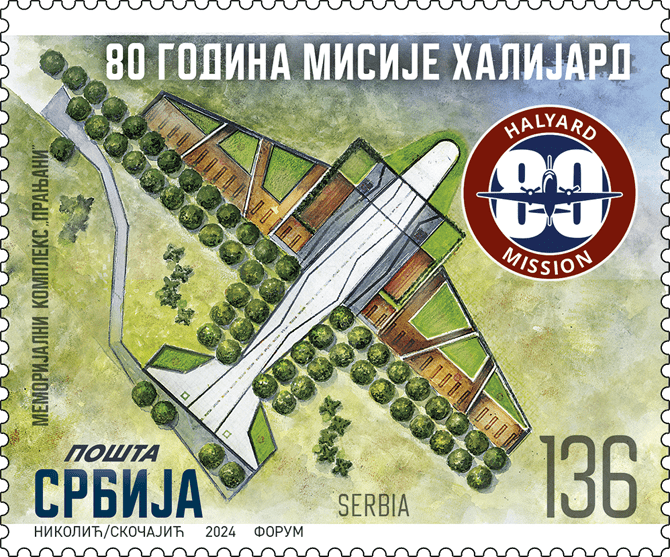

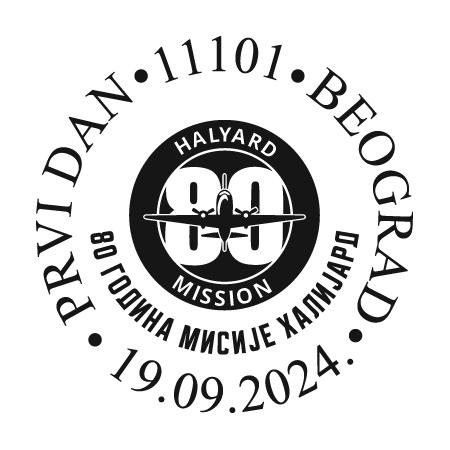

Operation Halyard was one of the largest and most successful missions to rescue downed Allied airmen during World War II. Conducted from August to December 1944 in occupied Yugoslavia, the mission was led by the Yugoslav Army in the Fatherland (JVuO) in partnership with the U.S. Office of Strategic Services (OSS).
The goal was to evacuate Allied pilots shot down during bombing missions to oil fields in Romania and other targets in the Balkans. With the aid of local villagers, the JVuO hid and protected the airmen until the evacuation. The primary location of the operation was Pranjani in central Serbia where General Dragoljub Mihailović ordered the construction of an improvised airfield on Galovića field. Hundreds of local villagers built the airstrip using ox carts and hand tools, exemplifying the complex coordination between the local population, the JVuO, the U.S. 15thAir Force, and the OSS.
Despite the presence of numerous German units in the area, over 500 Allied airmen were successfully evacuated without being detected. Operation Halyard not only saved the Airmen but demonstrated the effectiveness of rescue efforts under the most difficult conditions. Although initially obscure due to post–war political circumstances, the operation has since gained recognition as a testament to extraordinary courage and collaboration in the face of tremendous adversity.
Professional cooperation and materials for motifs: Halyard Mission Foundation
Artistic realization: Miroslav Nikolić and Nadežda Skočajić, academic graphic artist
Technical details
Date of issue: 19. 09. 2024.
Number of stamps in set: 1
Denomination and printrun:
1337: 136.00 RSD, 25.000
FDC: 1
Artistic realization: Miroslav Nikolić, Nadežda Skočajić
Subject: 80 years of the Halyard mission
1337: Memorial center "Pranjani"
Issue format: sheet of 8
Dimensions of stamp: 42 x 34,8 mm
Perforations: 13 3/4
Printer: Forum Novi Sad
Joy of Europe
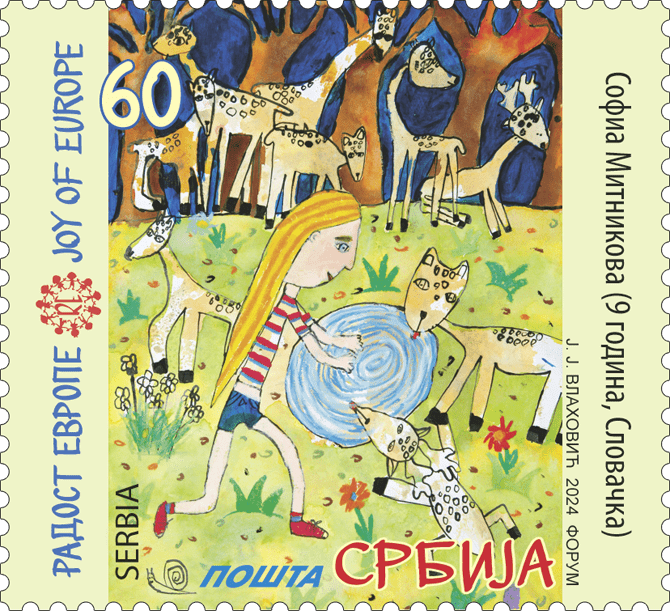
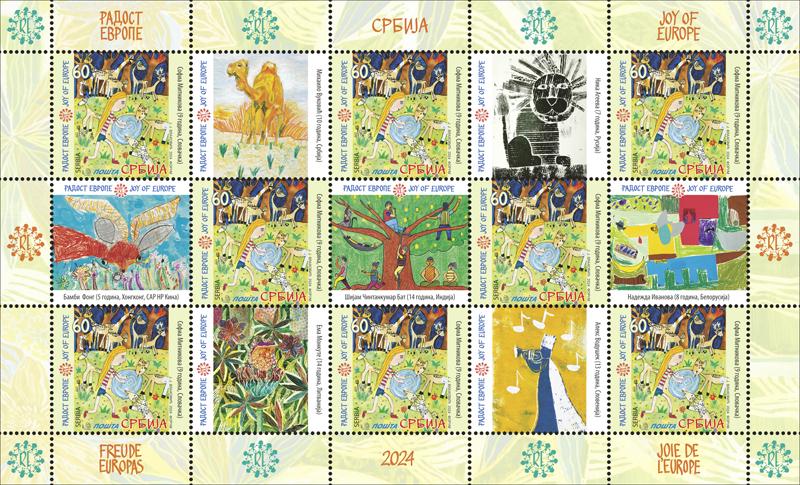
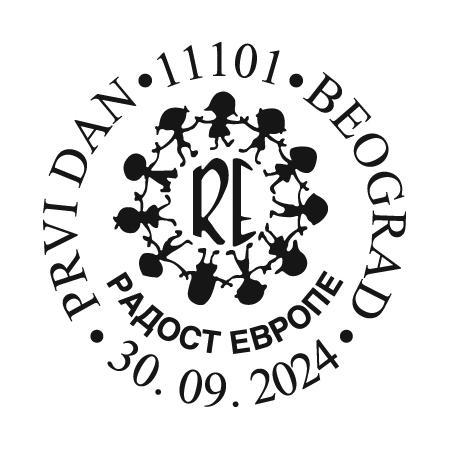
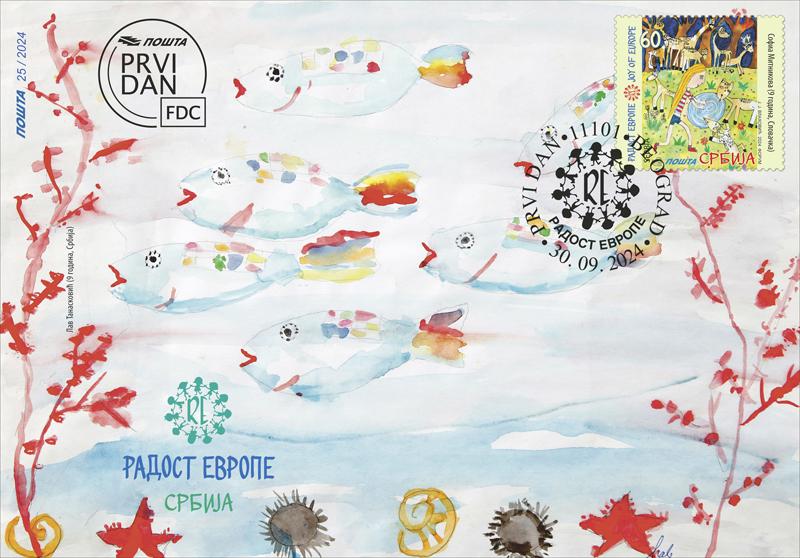
In 1969, on the occasion of the World Children’s Day, the first international festival of children’s songs and dances “Joy of Europe” was held in Belgrade with the support of the city government, President Tito, UNICEF and the United Nations General Assembly. More than half a century has passed since then and over 20,000 children have visited Belgrade. From the beginning, the main pillar of the event has been the hosts – parents, who welcome boys and girls from Europe into their homes, offering our traditional hospitality. The main idea of the event was and remains getting to know each other and creating friendships, and children’s play is at the centre of all events. In 1998, the 25th jubilee meeting “Joy of Europe” received a new program content – the International Art Competition, in which individuals, preschool institutions, schools, children’s art studios, children’s cultural centres and similar institutions participate since its establishment as well as associations from all over the world (children and the youth aged 4 to 18). Artworks created in the pencil, tempera, gouache, watercolour, pastel, ink, collage or graphics techniques have been making up the rich palette of the traditional manifestation for 26 years. They also find their place on the commemorative postage stamps “Joy of Europe” as a testimony that only the original, hand drawn and naive, carries fresh and strong creative power, because children have always drawn and enjoyed the creative process itself.
This year, the emphasis is on the beauty of flora and fauna, on respecting and caring for indigenous plants and animals around the world.
Let’s awaken ecological awareness! The world depends on the generations to come, who will build a future in harmony with nature better than we have. This stamp supports a natural and creative way of living in the most beautiful way possible!
Мотив на марки је рад Софиe Митниковe (9 година, Словачка). Аутори радова на вињетама су: Михаило Вуковић (10 година, Србија), Ника Агеева (7 година, Русија), Бамби Фонг (5 година, Хонгконг, САР НР Кина), Шијам Чинтанкумар Бат (14 година, Индија), Надежда Иванова (8 година, Белорусија), Ема Монкуте (14 година, Литванија), Алекс Водушек (13 година, Словенија). Аутор рада на коверти је Лав Танасковић (9 година, Србија).
Expert collaboration: Lidija Seničar, editor of the International Art Competition “Joy of Europe”, Children’s Cultural Centre Belgrade.
Graphic realisation of the issue: MA Jakša Vlahović, academic graphic artist
Technical details
Date of issue: 30. 09. 2024.
Number of stamps in set: 1
Denomination and printrun:
1338: 60.00 RSD, 25.000
FDC: 1
Artistic realization: Jakša Vlahović
Subject: Joy of Europe
1338: Work of Sofia Mitníkova (age 9, Slovakia), one of awarded drawings on the International Art Competition "Joy of Europe"
Issue format: sheet of 8
Dimensions of stamp: 35 x 31,9 mm
Perforations: 13 3/4
Printer: Forum Novi Sad
European values
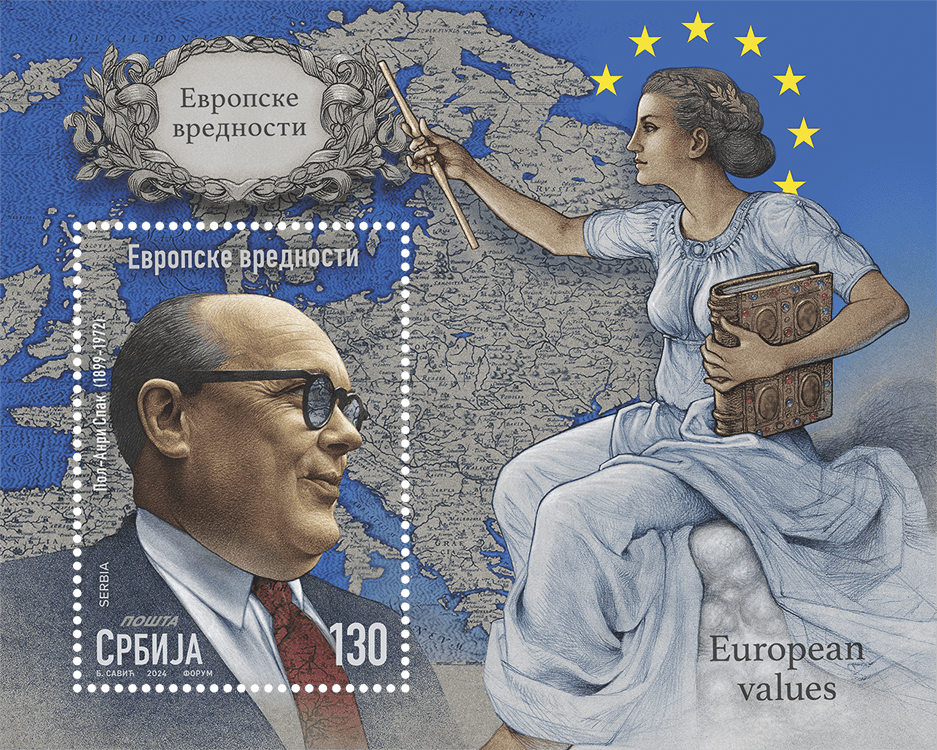

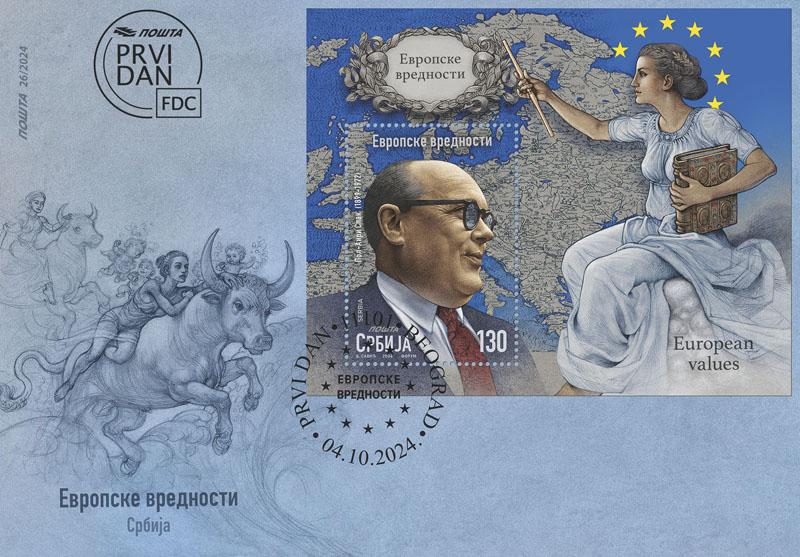
This issue points to the common values that the Republic of Serbia shares with the countries of the European Union by paying tribute to great people or events that are symbols of these values.
Paul-Henri Spaak (1899-1972) was a distinguished Belgian diplomat and statesman who promoted the ideals of multilateralism and interstate cooperation, as well as the building of strong European institutions, through his many decades of activity in the field of international politics. He presided over the first session of the General Assembly of the United Nations and many European organizations from which today's European Union was born.
Professional collaboration: ”Svetozar Marković” University Library, Belgrade.
Artistic realization: MA Boban Savić, academic painter.
Technical details
Date of issue: 04. 10. 2024.
Number of stamps in set: block with 1 stamp
Denomination and printrun:
115: 130.00 RSD, 10.000
FDC: 1
Artistic realization: Boban Savić
Subject: European values
115: Portrait of Paul-Henri Spaak
Issue format: block
Dimensions of the block: 100 x 80 mm
Dimensions of the stamp in block: 35 x 49,3 mm
Perforations: 13 3/4
Printer: Forum Novi Sad
100 years of the Institute of Public Health of Serbia “Dr Milan Jovanović Batut”
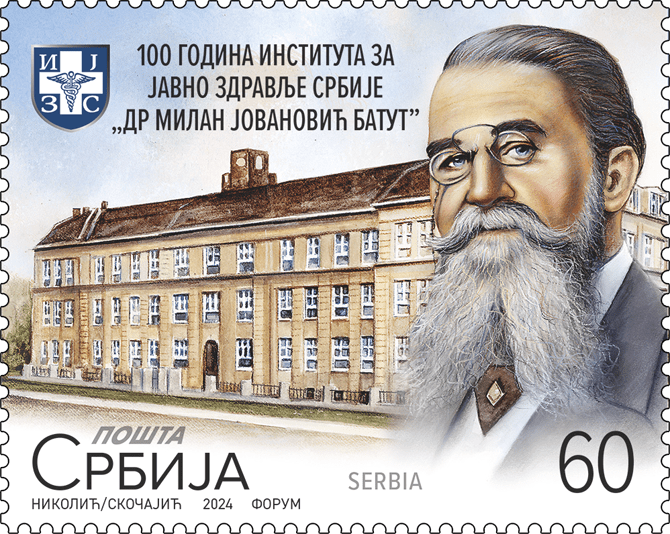
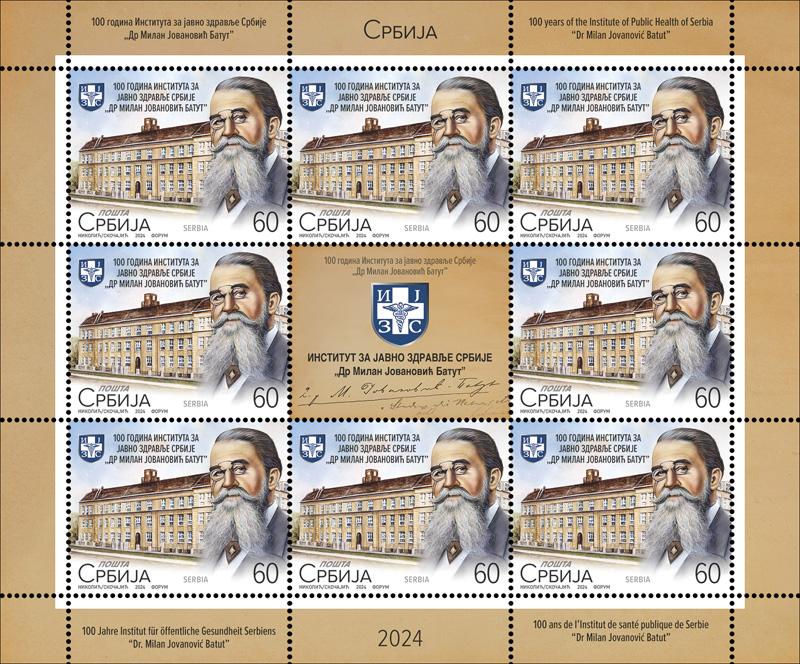

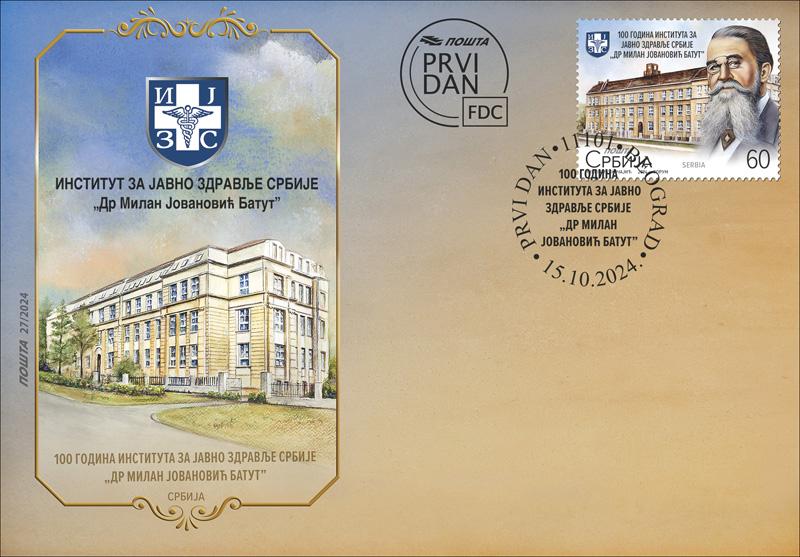
On the initiative of doctor and university professor Milan Jovanović Batut, on May 13, 1919, the Permanent Epidemic Commission of the Ministry of Health was established and monitoring of hygienic conditions and infectious diseases organized in the Kingdom of SCS. The first president of the Commission was Dr Milan Jovanović Batut. This Commission grew into the Central Institute of Hygiene in 1924.
After the Second World War, the Central Institute of Hygiene first became the Institute of Hygiene, and then the Institute for Healthcare of Serbia and took over the function of the republic's healthcare centre. In 1979, it became the Institute for Health Protection of Serbia, today the Institute of Public Health of Serbia.
The initiator of the work of the future Institute, Professor Doctor Milan Jovanović Batut was born on October 10, 1847 in Sremski Karlovci. He attended secondary school in Pančevo and Sremski Karlovci, and completed his medical studies in Vienna. He left a permanent mark in the history of the Serbian people, not only as the founder of the Faculty of Medicine and its first dean, but also as a dedicated scientific and social worker, whose life goal was medical education and raising healthcare awareness of the people. In numerous published works, he particularly emphasized the importance of family values, underlining that the family is the foundation of the strength and spirit of the people. For his entire life's work, he was awarded numerous decorations, among others the French Legion of Honour and the Order of the White Eagle. He was one of the most respected associates of "Politika" newspaper, the founder of the Serbian Literary Cooperative and an associate of Matica Srpska. He died in Belgrade on September 11, 1940. In his honour, since 1979, today's Institute of Public Health of Serbia proudly bears the name "Dr Milan Jovanović Batut".
Professional cooperation: Institute of Public Health of Serbia "Dr Milan Jovanović Batut". Artistic realization: Miroslav Nikolić, Nadežda Skočajić, academic graphic artist.
Technical details
Date of issue: 15. 10. 2024.
Number of stamps in set: 1
Denomination and printrun:
1340: 60.00 RSD, 25.000
FDC: 1
Artistic realization: Miroslav Nikolić, Nadežda Skočajić
Subject: 100 years of the Institute of Public Health of Serbia “Dr Milan Jovanović Batut”
1340: Building of Institute of Public Health of Serbia and portrait of Dr Milan Jovanović Batut
Dimensions of stamp: 42 x 33,35 mm
Perforations: 13 3/4
Printer: Forum Novi Sad
80 years since the liberation of Belgrade and Serbia
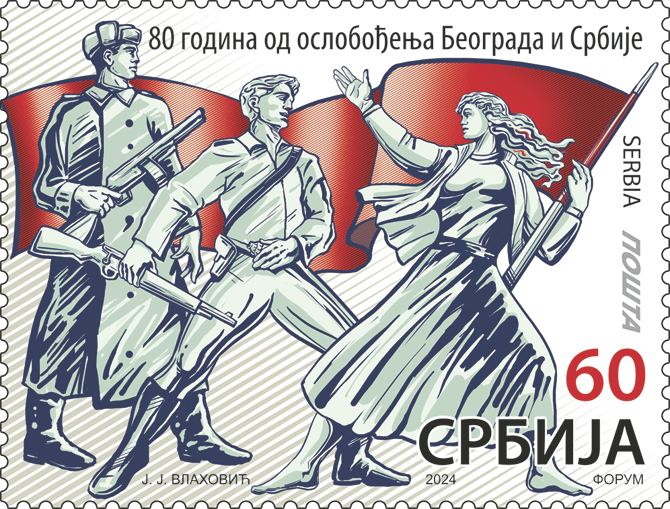
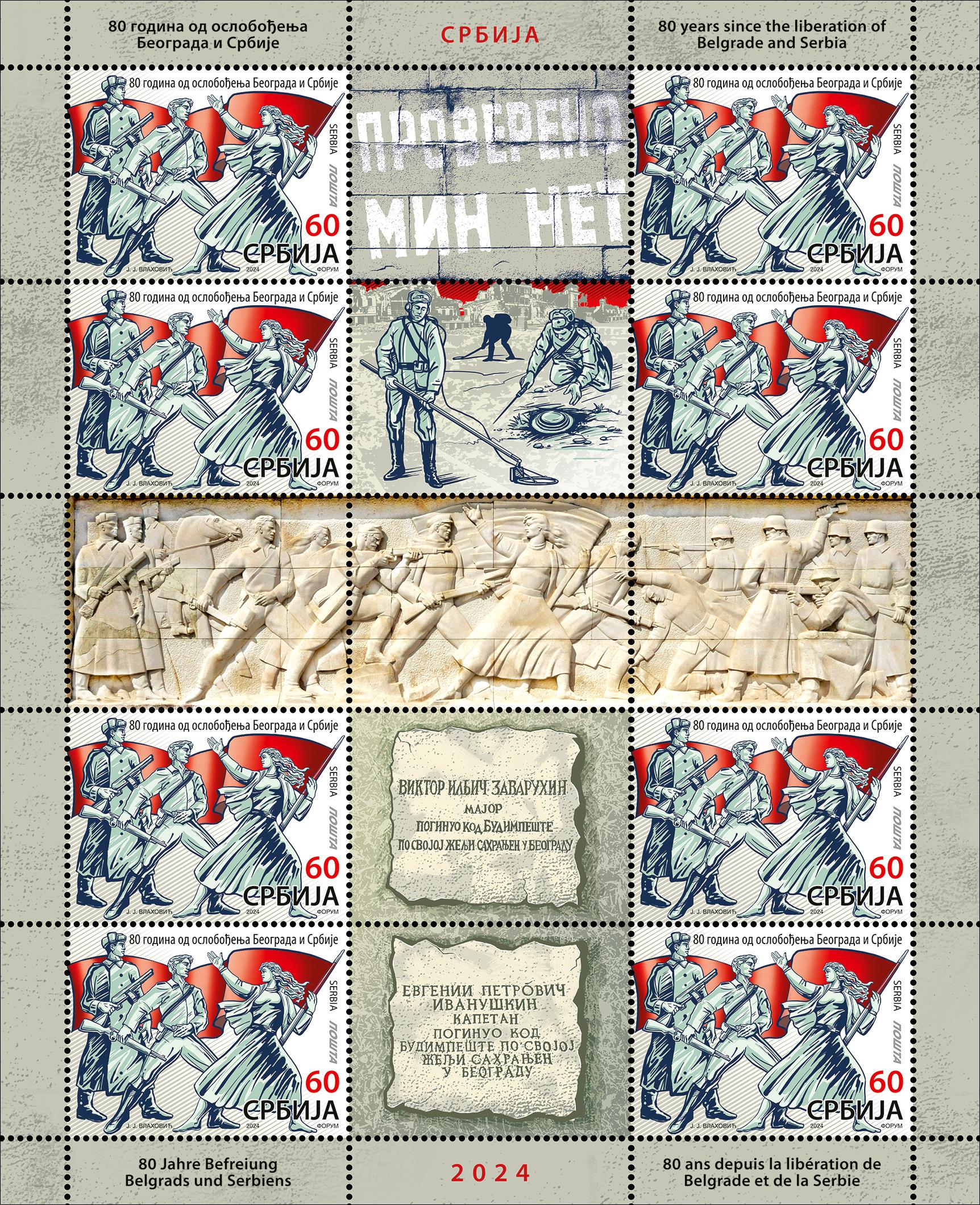

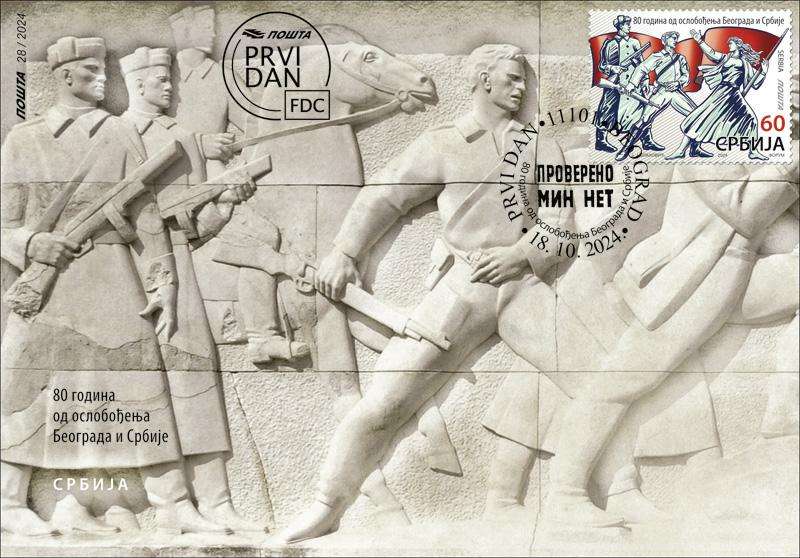
Belgrade and Serbia were liberated from the Nazi occupation in October 1944 by the joint struggle of the People’s Liberation Army of Yugoslavia (NOVJ) and the Red Army. The enemy, fleeing, mined a large number of key facilities in Belgrade, and thanks to the Red Army, almost all the mines were successfully removed. As a memory of the first days of freedom, there was an inscription on many Belgrade buildings – CHECK PASSED - NO MINES.
The fallen members of the NOVJ and the Red Army were buried together at the Memorial Cemetery of the Liberators of Belgrade. The unbreakable ties between the Russian liberators and Belgrade is evidenced by the fact that certain Red Army soldiers who liberated Belgrade, and later died in battles on the territory of Hungary and other European countries, were buried in Belgrade according to their wish.
Motifs on the vignettes: the relief at the entrance to the Memorial Cemetery of the Liberators of Belgrade, the work of sculptor Radeta Stanković (detail of the relief on the envelope); inscription in the Russian language ПРОВЕРЕНО – МИН НЕТ (trans. Check Passed – No Mines) from the period of the liberation of Belgrade in 1944, one of which is preserved at the corner of Miloš Veliki and Kralja Milana streets; inscriptions on memorial stones of fallen Red Army soldiers buried in Belgrade.
Expert coollaboration: The Russian House — Russian Centre of Science and Culture in Belgrade
Artistic realization of the issue: MA Jakša Vlahović, academic graphic artist
Technical details
Date of issue: 18. 10. 2024.
Number of stamps in set: 1
Denomination and printrun:
1341: 60.00 RSD, 25.000
FDC: 1
Artistic realization: Miroslav Nikolić, Nadežda Skočajić
Subject: 80 years since the liberation of Belgrade and Serbia
1341: Liberators of Belgrade, drawing according to the relief at the entrance to the Memorial Cemetery of the Liberators of Belgrade
Dimensions of stamp: 42 x 31,9 mm
Perforations: 13 3/4
Printer: Forum Novi Sad
European nature protection

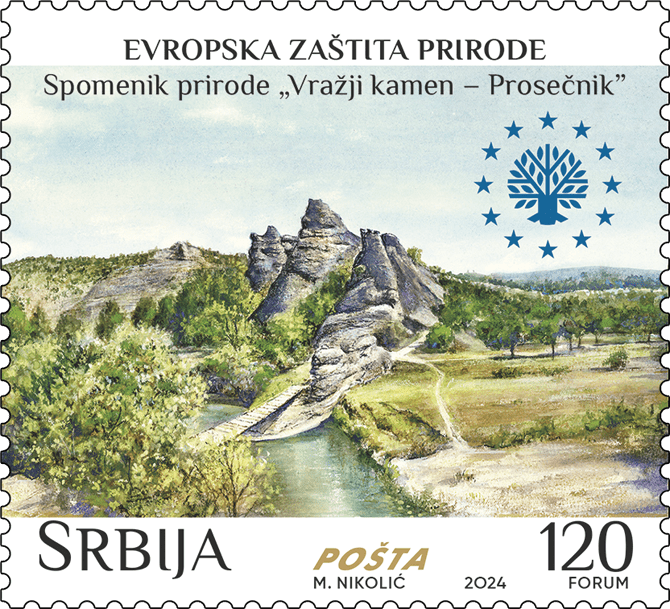
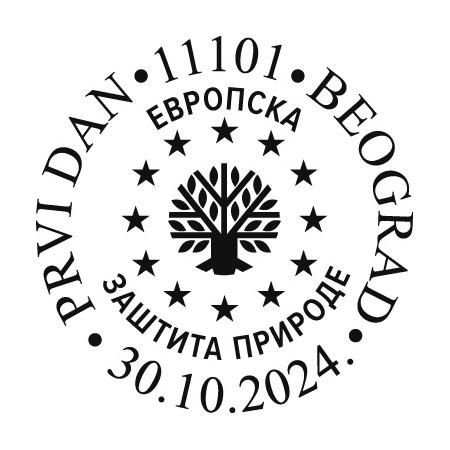
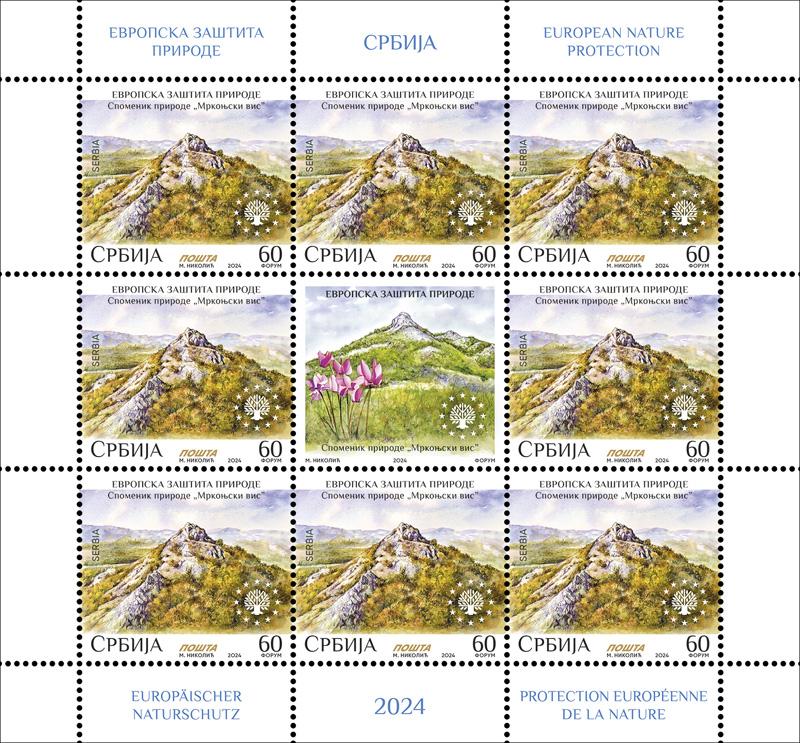
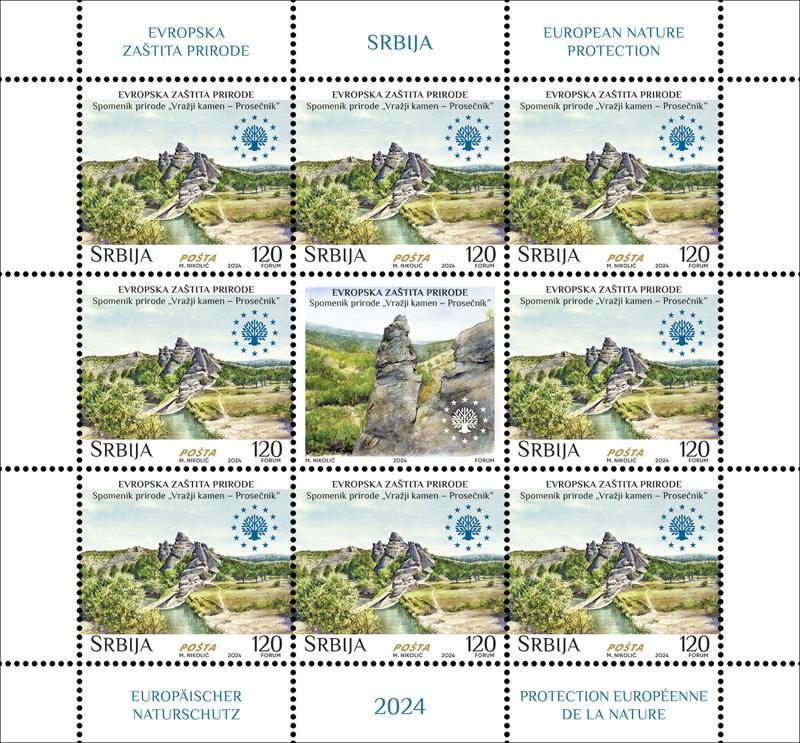

The natural monument „Mrkonjski vis“
The natural monument „Mrkonjski vis“ represents a physically distinct and recognizable geomorphological entity and belongs to the group of the most significant rocky peaks in Serbia. The top is a tectonically predisposed mountain pyramid – a spike. It is a refuge for a large number of species, which have found their refuge in the forest communities of black hornbeam and black ash, oak and hazel. 95 species of plants were registered with the presence of rich fauna. At the very top, specimens of the Greek frog were found, and in the lower areas, a large number of forest tortoises. In the wider area, 67 species of birds have been registered, and those of national and international importance are: black stork, turtledove, Syrian woodpecker, black woodpecker, honey buzzard, middle-spotted woodpecker, peregrine falcon, red-backed shrike, wood lark, common white and ortolan bunting.
The nature monument Mrkonjski vis is a protected area of category III protection – a protected area of local importance.
The natural monument „Devil’s Stone – Prosečnik“
The natural monument „Devil’s Stone – Prosečnik“ represents an exceptional natural value of geomorphological character with rocky sections, erosion beams and a large number of bones of different sizes and shapes, created by the selective action of the erosion process. 267 plant taxa have been recorded in this area, two of which are endemic species of sedum. 39 woody and shrubby species were singled out, and the old Polish elm tree stands out for its special value. Significant species of herpetofauna were recorded with six species of amphibians and ten registered species from the class of reptiles, as well as 44 species of birds. The church of St. Virgin Mary from the second half of the 14th century is located on the Devil’s Stone above Prosečnik, with the remains of buildings and infrastructure that were part of the church complex.
The Devil’s Stone – Prosečnik is a protected area of the II category of protection – an area of regional, that is, of great importance.
Expert collaboration: Institute for Nature Conservation of Serbia
Artistic realization of the issue: Miroslav Nikolić
Technical details
Date of issue: 30. 10. 2024.
Number of stamps in set: 2
Denomination:
1342: 60.00 RSD
1343: 1200.00 RSD
Printrun: 25.000
FDC: 1
Artistic realization: Miroslav Nikolić
Subject: European Nature Protection
1342: The natural monument „Mrkonjski vis“
1343: The natural monument „Devil’s Stone – Prosečnik“
Dimensions of stamp: 35 x 31,9 mm
Perforations: 13 3/4
Printer: Forum Novi Sad
70 years of diplomatic relations between the Republic of Serbia and the Republic of Indonesia
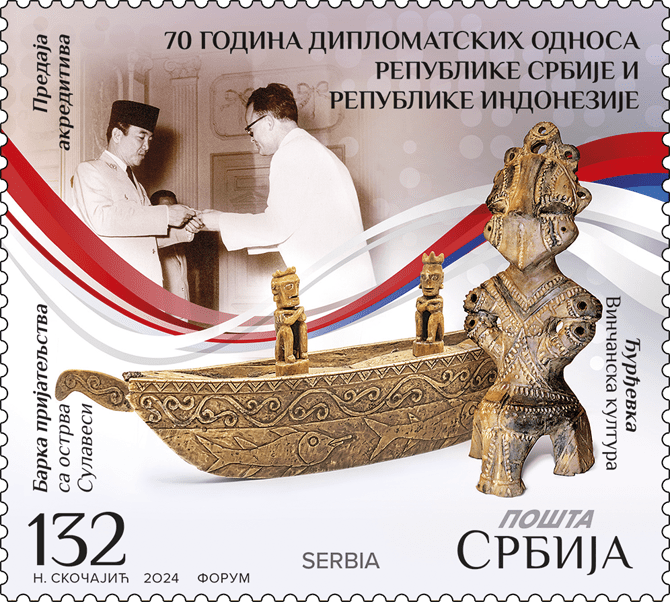
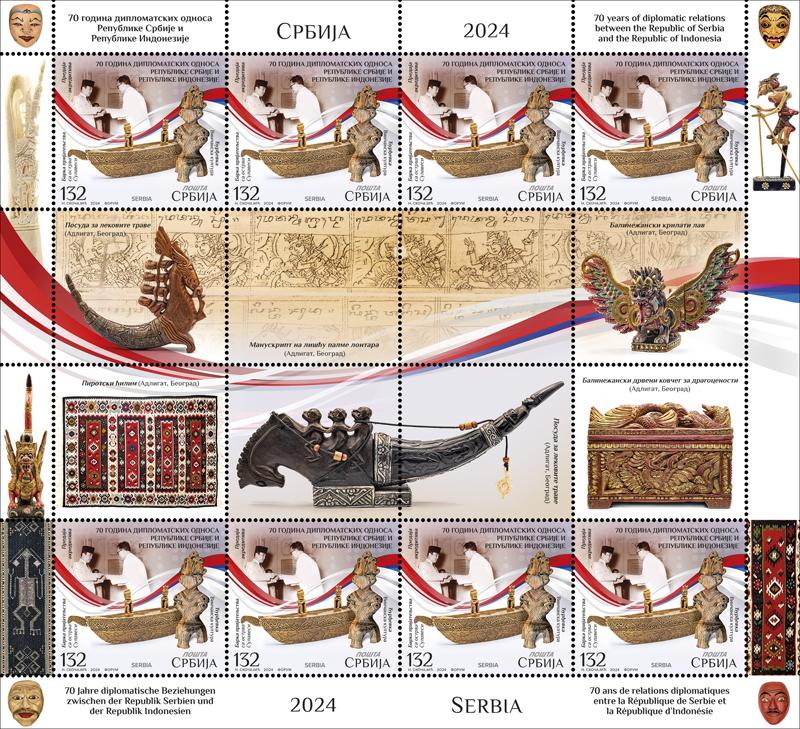
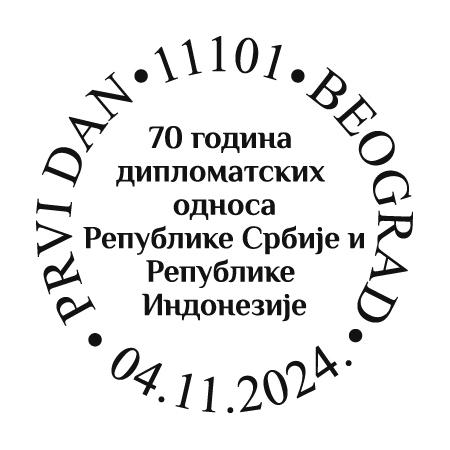
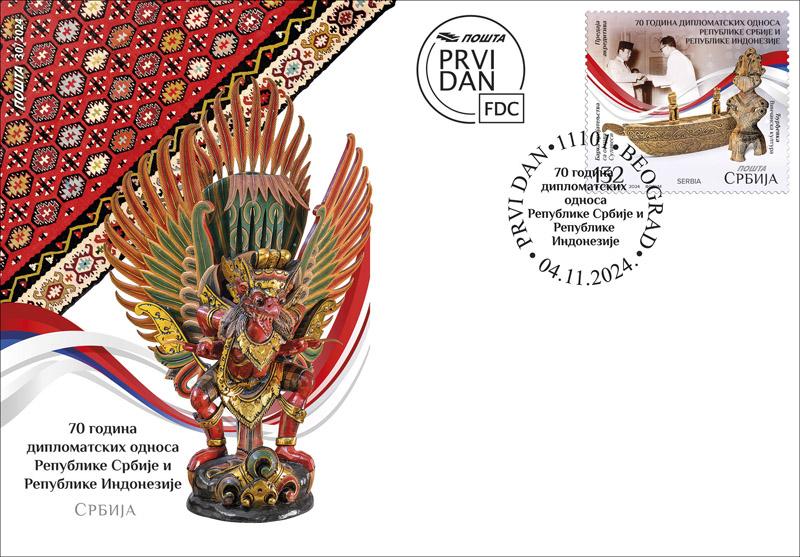
Diplomatic relations between Serbia and Indonesia were established in 1954 at the height of the global decolonization process. Our people were among the first in Europe to welcome the people of Indonesia with open arms and open hearts into the great family of equal people of the world, and the relations between the two countries intensified through cooperation on the formation of the Non-Aligned Movement.
Decades of successful bilateral cooperation between the two countries and very good political relations have also been confirmed in this century by interstate visits at the highest level. This is evidenced by two extremely important visits to the Republic of Serbia in 2024, the year of the 70th anniversary of the establishment of diplomatic relations – by the President of Indonesia Prabowo Subianto and the Speaker of the House of Representatives of the Parliament Puan Maharani, as well as the participation of the Ministers of Foreign Affairs of Indonesia at the ceremonial gatherings in Belgrade in 2011 and 2021, on the occasion of the 50th and 60th anniversaries of the First Conference of the Non-Aligned Movement. The friendly relations between the two countries are confirmed by a series of signed interstate agreements that facilitate economic cooperation and the cooperation in the fields of education, science, culture and other areas of mutual importance.
Motifs on the stamp: Đurđevka, anthropomorphic figure, Vinča culture (5300–4500 BC), Friendship boat from the island of Sulawesi; in the background – Ambassador Pavlič hands over letters of credit to President Sukarno in 1954. Motifs on the vignettes: medicinal herbs container; manuscript on lontar palm leaves; Balinese winged lion; Pirot rug; a medicinal herbs container and a Balinese wooden treasure chest. On the edges: in the corners – Balinese and Javanese masks for dance and shadow theatre; left – buffalo bone mythological creature, Balinese winged lion and tenun ikat (detail) – double weave (ceremonial fabric from central Indonesia); right – “Javajka” (Java doll) – Wayang puppet for shadow theatre and a Pirot rug (detail). Motif on the envelope: Pirot rug and Garuda, a golden mythical bird, symbol of Indonesia.
Publishing materials: Adligat Association, Museum of Books and Travels, Indonesia Collection, Ambassador Stane Pavlič's Legacy, Ivan and Cherry Hadisubroto's Legacy and Vladislava Golubović's Legacy.
Expert cooperation: The Embassy of the Republic of Indonesia in Belgrade and the Adligat Association.
Artistic realization: Nadežda Skočajić, academic graphic artist.
Technical details
Датум издања: 04. 11. 2024.
Број марака: 1
1344: 132.00 дин
Printrun: 25.000
Коверат првог дана (FDC) са жигом: 1
Табак: 8
Димензије марака: 42 x 37,7 mm
Штампа: вишебојни офсет
Зупчање: чешљасто 13 3/4
Штампарија: Форум Нови Сад
75 years since the founding of Radio-television of Vojvodina
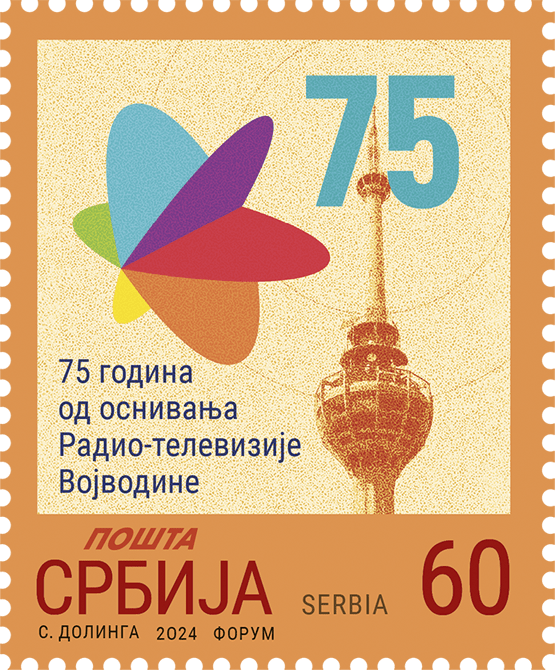
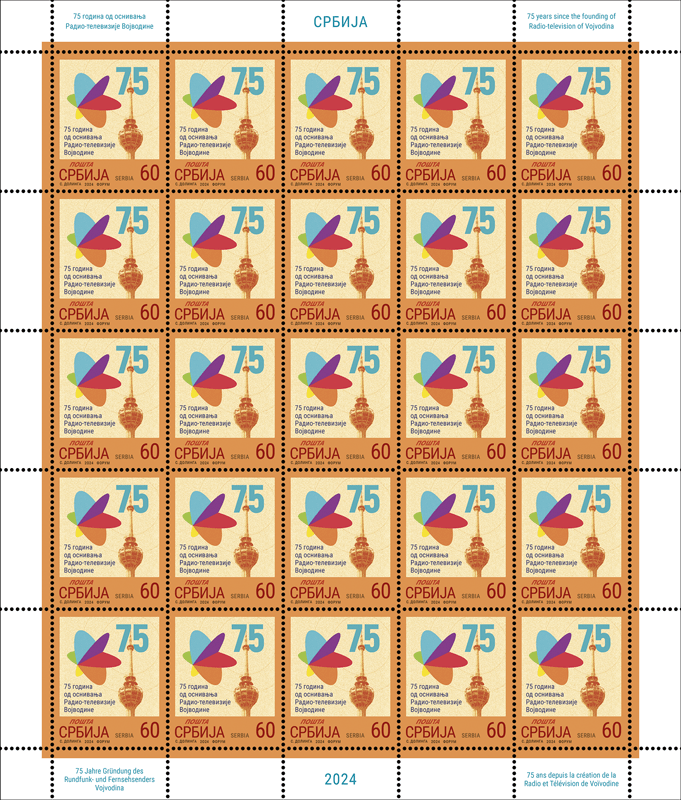
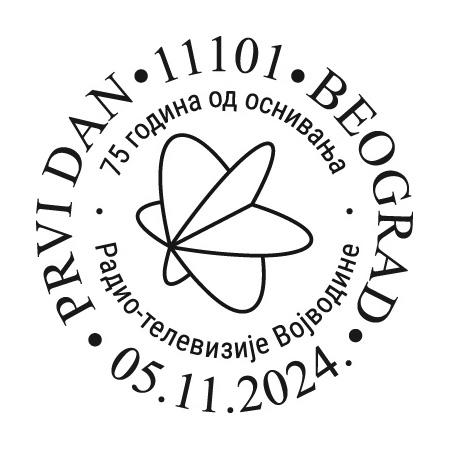

In the tumultuous years after the end of World War II, the young socialist state of Yugoslavia faced a propaganda war waged against it by the Cominform. In the desire to adequately respond to the accusations of the countries of the Stalin bloc in the surrounding of which Yugoslavia was located, on November 29, 1949, Radio–Novi Sad was launched, a regional radio station that broadcast its program in five languages – Serbo-Croatian, Hungarian, Slovak, Romanian and Rusyn.
The informative program of this radio was not intended only for members of the national minorities of the multi-ethnic Vojvodina, but also for the residents of the surrounding countries who, very soon after the launch of Radio–Novi Sad, became its permanent listeners, because this radio, in addition to informative programs, also broadcast popular music unconstrained by ideology, bringing a touch of European and global pop culture to the residents of the Eastern Bloc countries on their radio waves.
The development of the media and the progress of technology in the 20th century also led to the need to create a television program for the residents of Vojvodina, so, by the decision of the Assembly of AP Vojvodina, Radio-Novi Sad grew into Radio–Television Novi Sad, RTNS in 1972. The first minutes of the television program of this media company were broadcast on November 26, 1975 from the newly built studio in Mišeluk, Novi Sad. The informative program was broadcast in Serbo-Croatian and Hungarian, and the rest of the program, just like on the radio two and a half decades earlier, was broadcast in five languages.
At the beginning of the 21st century, RTNS grew into a public radio and television service, Radio-television of Vojvodina. Today, two television and four radio programs of this media house are broadcast from the new building of Radio-television of Vojvodina in Mišeluk, recognizable by its dominant antenna pole. In the modern building, moved into in 2021, there are five TV studios, radio studios, a music studio and two universal sound studios where around 1,200 RTV employees create countless hours of television and radio programs every day.
Expert collaboration and design: Radio-television of Vojvodina
Graphic realization: MA Nadežda Skočajić, Academic Graphic Artist
Technical details
Датум издања: 05. 11. 2024.
Број марака: 1
1345: 60.00 дин
Printrun: 25.000
Коверат првог дана (FDC) са жигом: 1
Табак: 25
Димензије марака: 29 x 35 mm
Штампа: вишебојни офсет
Зупчање: чешљасто 13 3/4
Штампарија: Форум Нови Сад
Уметничка реализација: С. Долинга
Нацрт: 1345. Знак и антенски стуб радио-телевизије Војводине
110 years of the Australian medical mission in Serbia
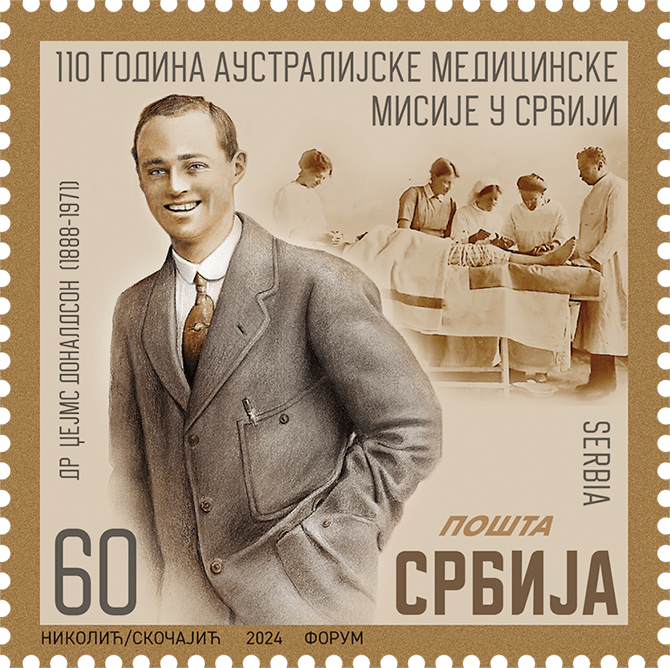


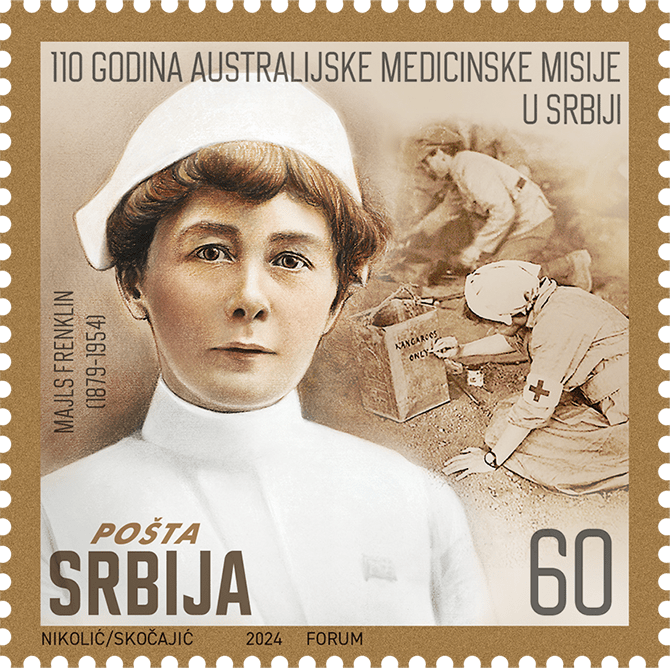

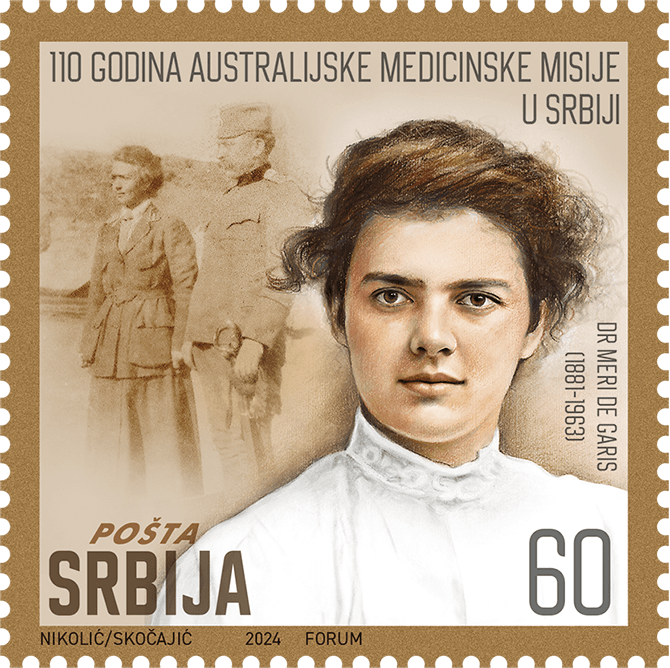
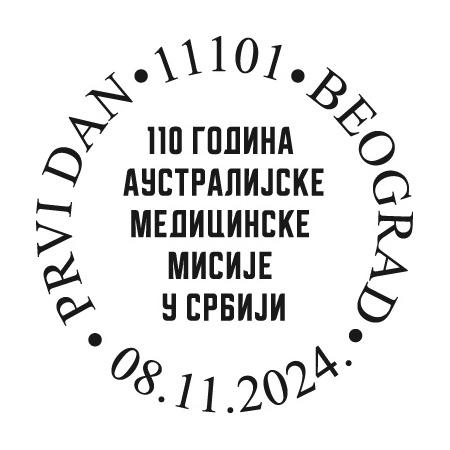

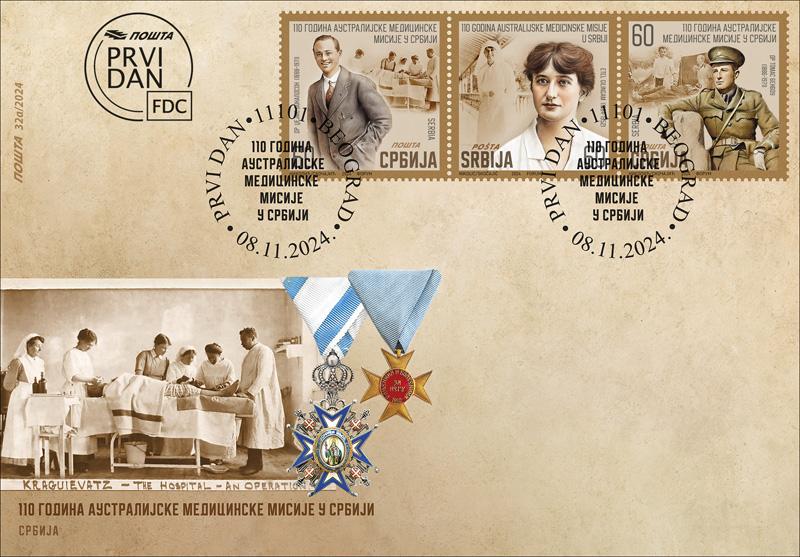
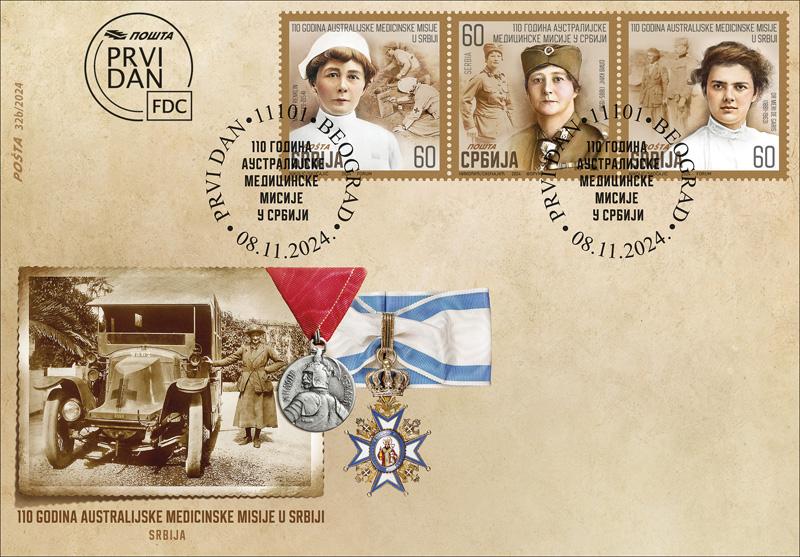
When the brave, small European Kingdom of Serbia was dragged into the whirlwind of the First World War, the word about the heroism and chivalry of its soldier–farmers quickly spread throughout the free world after the first victories in the battles of Cer and Kolubara. Volunteers from all over rushed to help the brave Serbian soldiers and the Serbian people. Among the first were volunteers from Australia, who treated wounded and sick soldiers and civilians as part of medical and Red Cross missions.
Donaldson, James Blair (1888–1971) came to Serbia in 1915 as a member of the Allies War Relief organisation. In the hospital in Kragujevac, he was in charge of an X-ray unit. Later, he served in the French Army field hospital, Hospital d’Evacuation, No. 2, on the Greek border, where he also performed surgical procedures. He studied medicine at the University of Melbourne, and graduated from the University of Edinburgh in 1913. In the years after World War I, he returned to Australia with his wife and son, where he worked as a medical doctor.
Gillingham, Ethel May (1884–1952) came to Serbia with the Second British Red Cross Serbian Mission and, as a volunteer nursing sister, she served in Vrnjačka Banja from May 1915 to October 1915. She was detained during the Austro-Hungarian occupation offensive on Serbia, but was set free in February 1916, so she continued her mission as a nursing sister in Egypt, where, during her service in Cairo, she met Captain Richard Evans, who served on the Salonika front in 1917, and became engaged to him. After the war, Ethel and Richard married and had three children.
Benbow, Thomas Alexander Palmer (1886–1971) came to Serbia in November 1914 with the British Red Cross Number One Unit and with a valedictorian degree of the Jefferson College of Medicine in Philadelphia. Until June 1915, he worked in the Serbian Fourth Reserve Hospital in Skopje, treating the wounded and those sick with typhus, which he himself contracted during his service. He was awarded the Order of Saint Sava, Class IV. After the war, he returned to Australia where he establsihed a medical practice.
Franklin, Stella Maria Sarah Miles (1879–1954) voluntarily joined the Scottish Women's Hospitals in 1917 and reported for service at the «America» hospital near Ostrovo, performing the duties of hospital cook and taking care of the warehouse. She described her wartime experiences in the memoir «Ne mari ništa: Six months with the Serbs» and in the play «By far Kajmacktchalan: A Play of the Balkan Front Today». Due to impaired health, she retired from the front at the beginning of 1918.
King, Olive May Kelso (1885–1958) The Great War found her in England, where she immediately volunteered for war service. She came to Serbia in 1915, with her own light truck converted into an ambulance, as a driver in the Scottish Women's Hospitals, and in 1916, she joined the Serbian army on the Salonika front. As an ambulance driver on the Salonika front, she was promoted to the rank of sergeant, and for her service was awarded the Medal for Zealous Service, the Cross of Mercy, the Silver Medal for Bravery and the Order of Saint Sava, Class V.
De Garis, Mary Clementina (1881–1963) joined the Scottish Women's Hospitals after the death of her fiancé, who was killed in action on the Western Front. She began her service as a medical officer in the hospital «America» near Ostrovo, on the territory of Macedonia, which was supporting the Serbian army. She was appointed Chief Medical Officer of the hospital in 1917 after Dr Agnes Bennett, the CMO of this hospital, retired from her duties, and was at its head until 1918. For her selfless and self-sacrificing engagement in the organization of medical support for the Serbian army, she was awarded the Order of Saint Sava, Class III.
Professional cooperation and materials for motifs: Australian Embassy in Belgrade and Bojan Pajić
Artistic realization: Miroslav Nikolić and Nadežda Skočajić, academic graphic artist
Technical details
Date of issue: 08. 11. 2024.
Number of stamps in set: 6
Denomination:
1346: 60.00 RSD
1347: 60.00 RSD
1348: 60.00 RSD
1349: 60.00 RSD
1350: 60.00 RSD
1351: 60.00 RSD
Printrun: 25.000
FDC: 2
Artistic realization: Miroslav Nikolić, Nadežda Skočajić
Subject: 110 years of the Australian medical mission in Serbia
1346: Donaldson, James Blair
1347: Gillingham, Ethel May
1348: Benbow, Thomas Alexander Palmer
1349: Franklin, Stella Maria Sarah Miles
1350: King, Olive May Kelso
1351: De Garis, Mary Clementina
Dimensions of stamp: 35 x 34,8 mm
Perforations: 13 3/4
Printer: Forum Novi Sad
185 years of Military Security Protection and 80 years of Military Counterintelligence Service
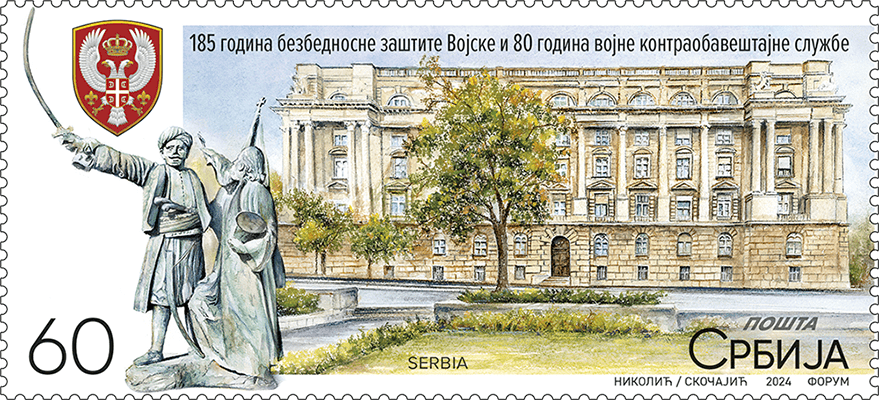
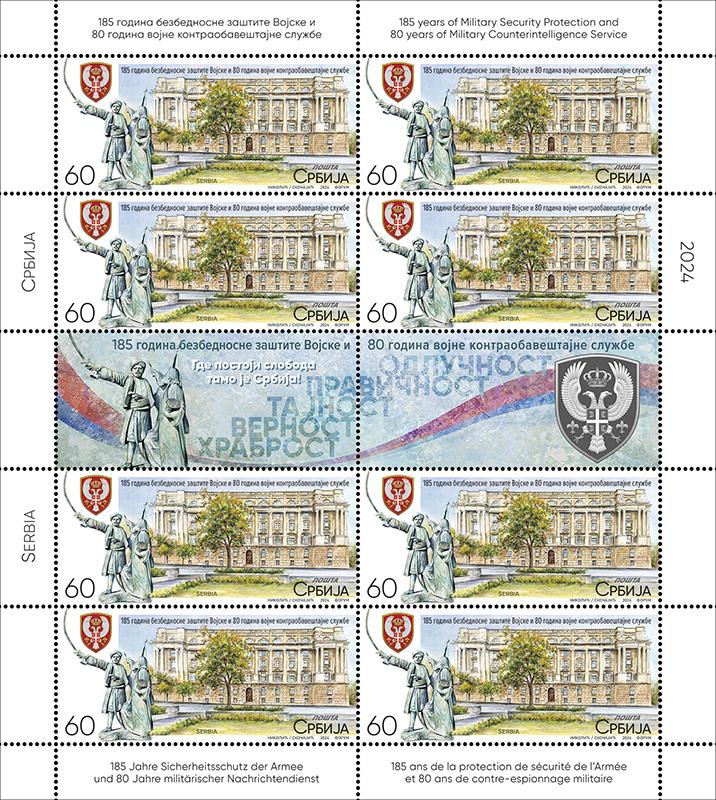

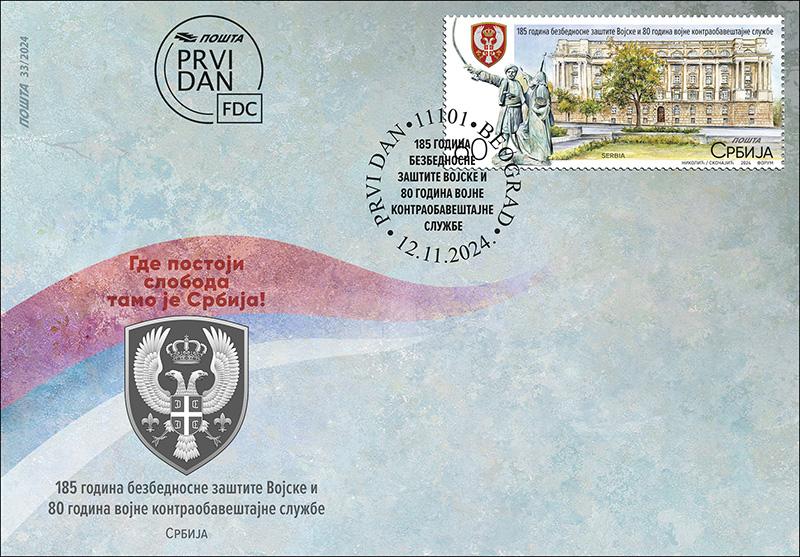
185 years ago, on November 12, 1839, the Military Law (Закон воениј) was passed in the Principality of Serbia, which is the first legal act that systematically defines military security protection and prescribes punishments for acts of treason, desertion, rebellion, espionage and acts against «people›s freedom». This legal act is the cornerstone of the institutional existence and development of security protection of the Army and the bodies and services that implement it. Their improvement and operation through various forms and shapes continued during the 19th and 20th centuries until today.
The uprising of the people of Yugoslavia against the fascist occupation in 1941, the formation of the bodies of the people›s government and the NOV (People’s Liberation Army) and POJ units (Partisan Units of Yugoslavia), mobilized all patriots in the fight against the occupiers and quislings. Security protection was achieved through the collection of data on the occupier and opposing military formations and the prevention of infiltration by enemy agents. The comprehensive and aggressive intelligence and subversive activities of the occupiers and quislings required more effective protection and the existence of a centralized counterintelligence service. For this purpose, 80 years ago, on May 13, 1944, the Department for Protection of the People – OZNA was formed as a centralized security service. Within the OZNA, there was the third section – Counterintelligence protection of the armed forces. After the liberation, in 1946, from the third and fourth sections of the OZNA, the Counterintelligence Service (KOS) of the Ministry of National Defence was formed, which in 1955 received the name Security Directorate, in 2002 the Military Security Service and since 20 years ago (as of 2004) exists under the name Military Security Agency.
Artistic realization: Miroslav Nikolić and Nadežda Skočajić, academic graphic artist
Technical details
Date of issue: 12. 11. 2024.
Number of stamps in set: 1
Denomination:
1352: 60.00 RSD
Printrun: 25.000
FDC: 1
Artistic realization: Miroslav Nikolić, Nadežda Skočajić
Subject: 185 years of Military Security Protection and 80 years of Military Counterintelligence Service
1352: Headquarters of the Military Security Agency (VBA) of the Ministry of Defense of the Republic of Serbia, the coat of arms of the VBA and a monument representing the Serbian ruler Miloš Obrenović and Archimandrite Melentije (a replica of the "TakovoUprising" monument by the sculptor Petar Ubavkić).
Dimensions of stamp: 70 x 31,9 mm
Perforations: 13 3/4
Printer: Forum Novi Sad
Serbia - Russia
185 years since the birth of Colonel Nikolay Raevsky
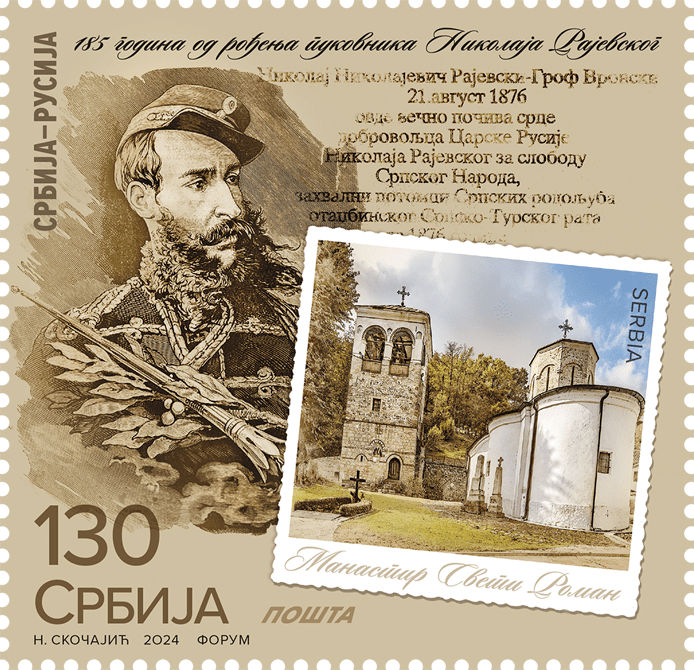

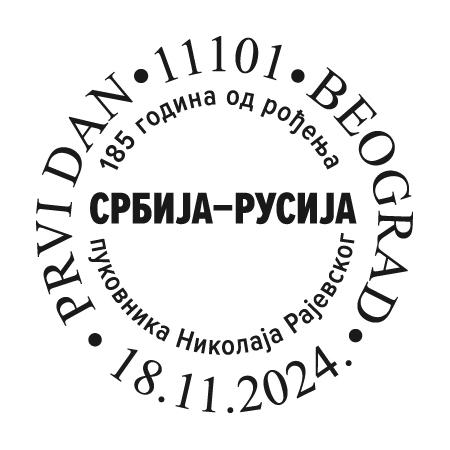
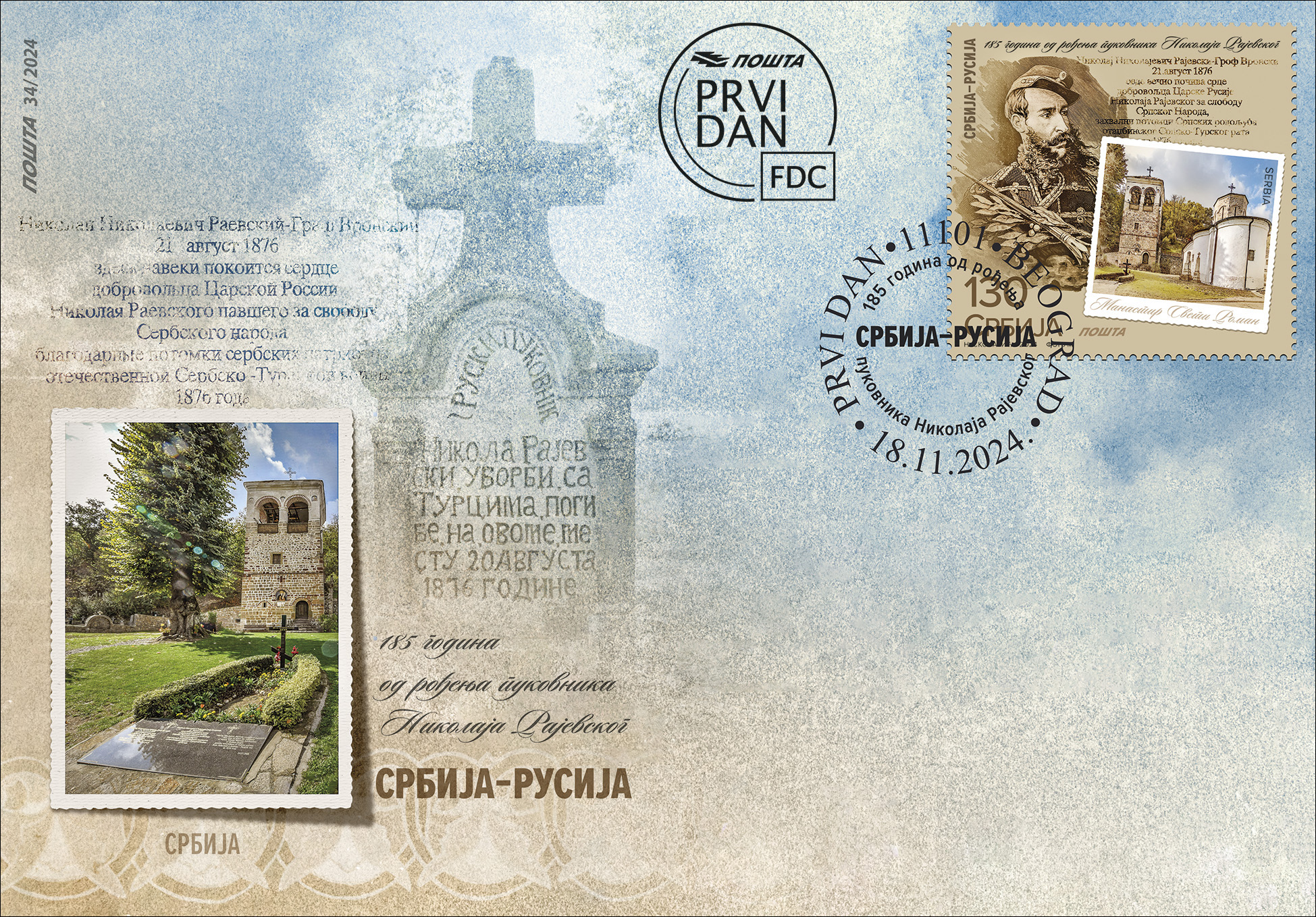
One of the most striking figures in the long history of Serbian and Russian friendship, Colonel Nikolay Nikolayevich Raevsky (Russian: Николай Николаевич Раевский, November 17, 1839 – September 2, 1876 according to the Gregorian calendar) was born in Russia, in the Crimea in an aristocratic military family. He was the grandson of the celebrated general Nikolay Raevsky, the hero of the Patriotic War of 1812 against Napoleon. His father, who was also called Nikolay Nikolayevich, was a lieutenant general, commander of the Black Sea Coastal Line, founder of the city of Novorossiysk, the largest seaport on the Black Sea, and the closest friend of the Russian poet Alexander Pushkin.
When the war between Serbia and Turkey broke out in 1876, Colonel Raevsky came under the command of General Chernyayev as a volunteer. He commanded a detachment of Russian volunteers in the Battle of Aleksinac, and died a heroic death in the Battle of Gornji Adrovac on September 2, 1876.
He was buried in his homeland, but his heart, which beat for the Slavic brothers, remained forever in Serbia, in the Saint Roman monastery. The heroic personality of Nikolay Raevsky inspired the writer Leo Tolstoy for the character of Count Vronsky in the novel Anna Karenina.
Professional cooperation: The Russian House – Russian Centre of Science and Culture in Belgrade, Brotherhood of Saint Roman Monastery
Artistic realization: Nadežda Skočajić, Academic Graphic Artist
Technical details
Date of issue: 18. 11. 2024.
Number of stamps in set: 1
Denomination:
1353: 130.00 RSD
Printrun: 25.000
FDC: 1
Artistic realization: Nadežda Skočajić
Subject: 185 years since the birth of Colonel Nikolay Raevsky
1353: Colonel Nikolay Raevsky and Monastery of Saint Roman
Dimensions of stamp: 43,5x42mm
Perforations: 13 3/4
Printer: Forum Novi Sad
Slava – Celebration of Family Saint Patron’s Day
Venerable Mother Paraskeva – Saint Petka
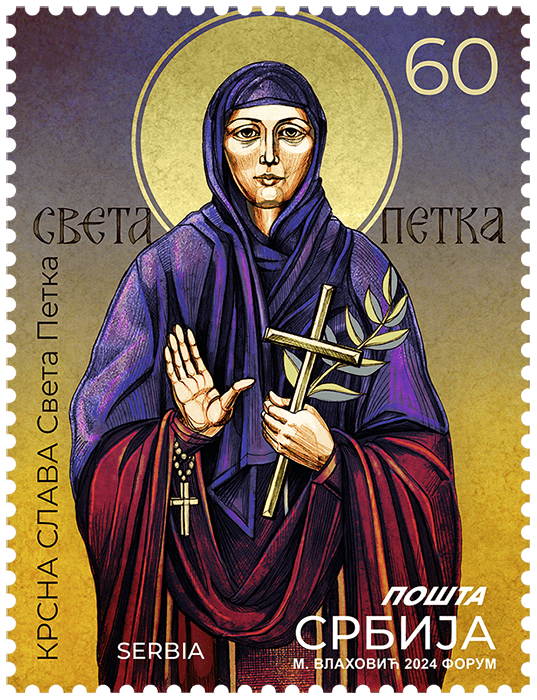
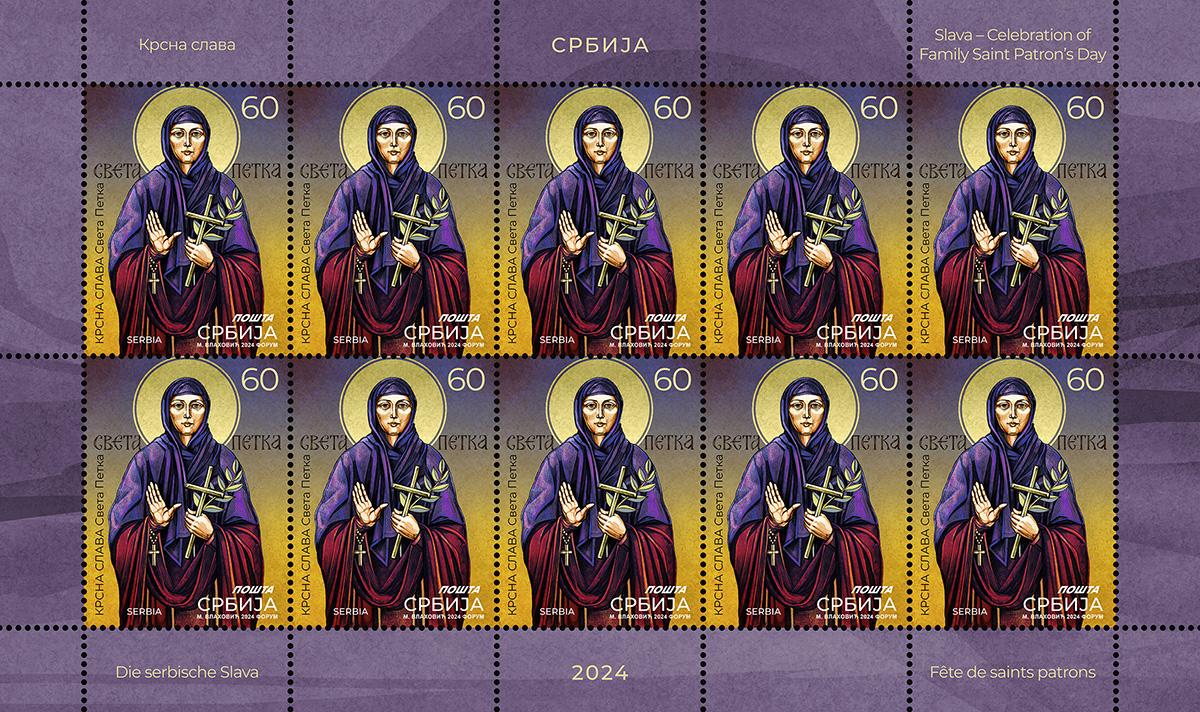
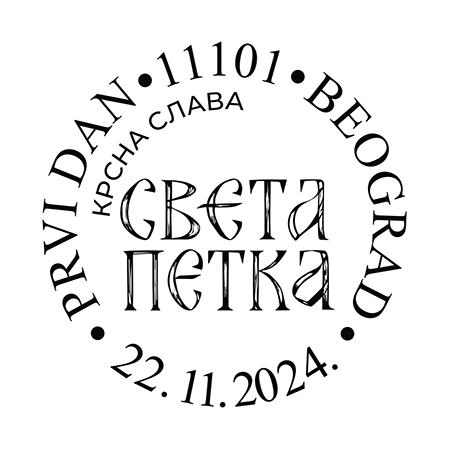
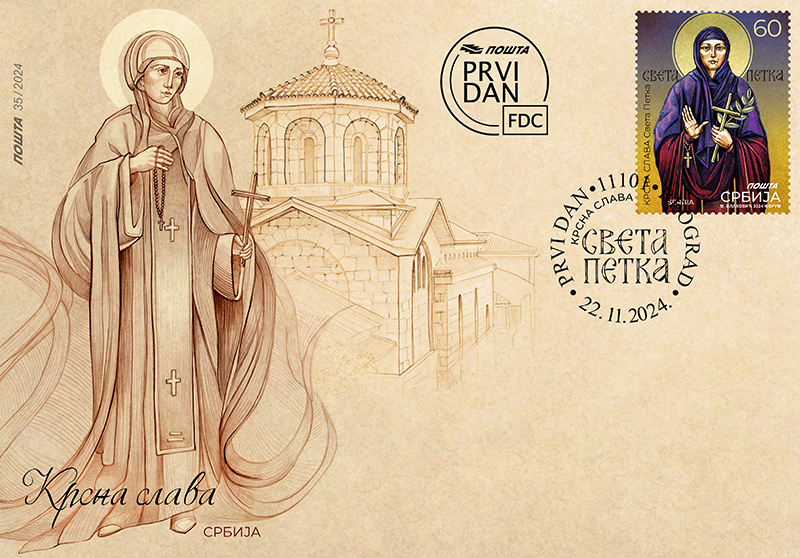
Patron Saint’s Day (Slava) is a holiday dedicated to a Christian saint whom the family takes as its patron and protector. The celebration of the Patron Saint among Serbs dates back to the time of Saint Sava. Today, the majority of Orthodox Christians in the territory of Serbia celebrate the Patron Saint’s Day as a significant holiday in which individual families and their guests – members of the extended family, spiritual relatives, neighbours and friends– participate. As bearers of a unique Orthodox tradition, Serbs perceive Patron Saint’s Day as a way of expressing their Christian and national identity.
Slava is a vital element of the intangible cultural heritage of the Serbian people, and in 2014 it was inscribed on the UNESCO Representative List of the Intangible Cultural Heritage of Humanity.
Venerable Mother Paraskeva was born in the middle of the 10th century, in a wealthy and pious Byzantine family in a town on the coast of the Sea of Marmara. She was pious since childhood, and after the death of her parents, her love for God took her to Palestine, to worship holy places, and then to the Jordan desert, where she lived in strict asceticism until old age. Towards the end of her life, she returned to her native Epibates, where she presented herself unto God, but as she did not reveal who she was to anyone, she was buried in the part of the cemetery where unknown people were buried. Legend has it that, during the burial of a drowned person, they dug up the saint›s grave and found her remains uncorrupted, so they laid the relics in the church of the Holy Apostles Peter and Paul in Epibates.
Two centuries later, the Bulgarian emperor Jovan moved the relics to Tarnovo, where they remained until the Turkish conquests, after which they were transferred to Wallachia and, in 1396, upon advocacy of Princess Milica Hrebeljanović, they were transferred to Belgrade, to the chapel of Saint Petka, which was built on Kalemegdan fortress. The relics were then transferred to Constantinople in 1521, but the Venerable Mother Paraskeva remained one of the most respected and beloved saints among out people. Saint Petka is celebrated on October 27, and in terms of the number of people who celebrate her as their Patron Saint, it is one of the biggest Slavas in Serbia.
Artistic realisation of the issue: MA Marija Vlahovic, academic graphic artist
Technical details
Date of issue: 22. 11. 2024.
Number of stamps in set: 1
Denomination:
1354: 60.00 RSD
Printrun: 25.000
FDC: 1
Artistic realization: Marija Vlahović
Subject: Patron saint’s day
1354: Venerable Mother Paraskeva – Saint Petka
Dimensions of stamp: 31,9x42mm
Perforations: 13 3/4
Printer: Forum Novi Sad
Christmas

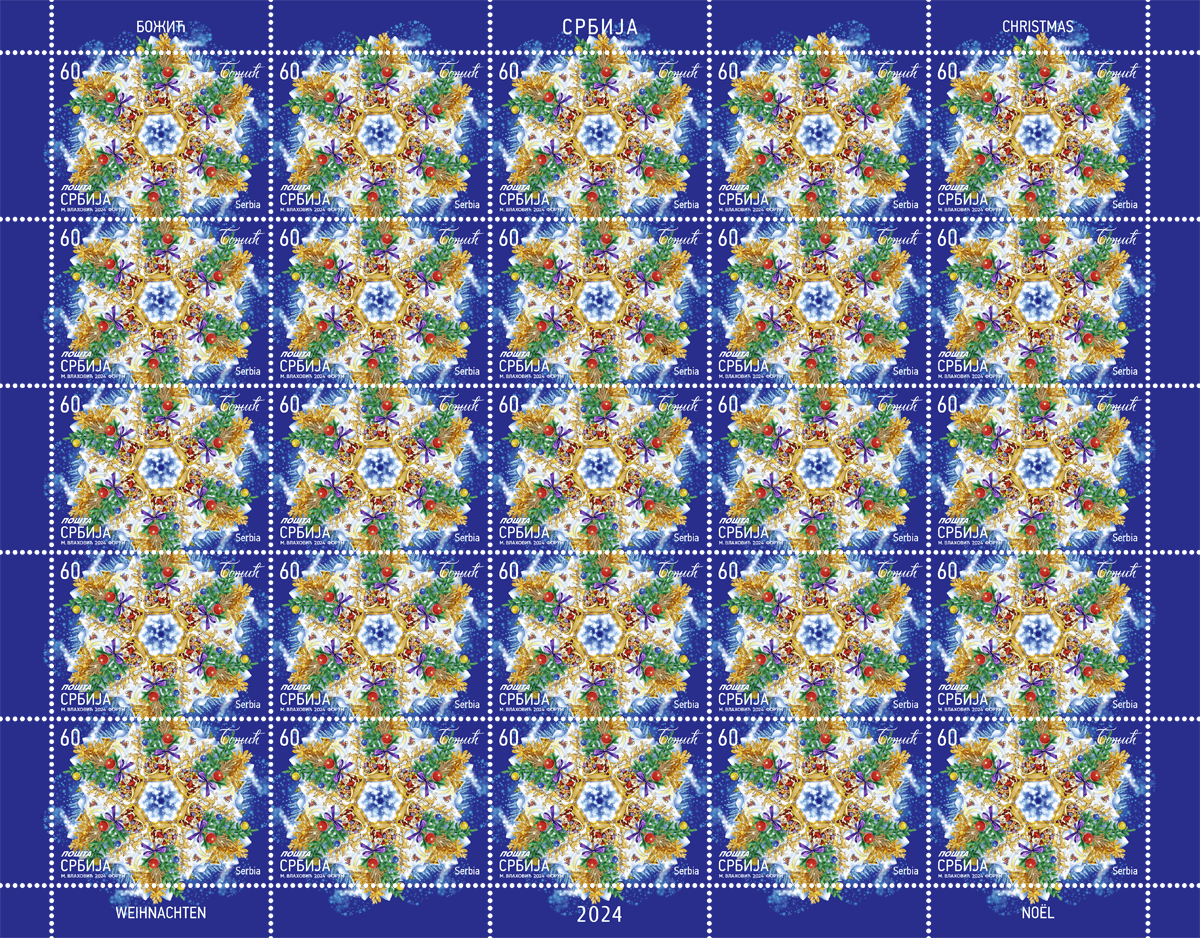
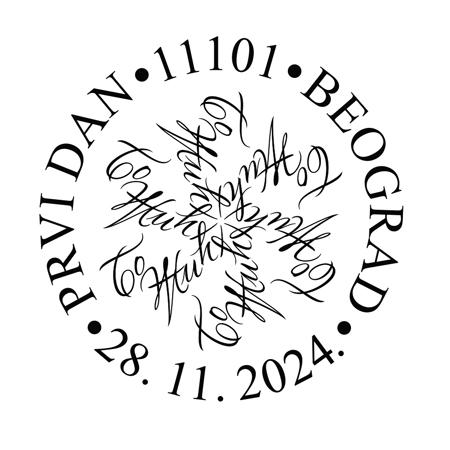

Christmas is one of the most important and one of the most joyous Christian holidays, that is celebrated both by the Orthodox and Catholic believers. The difference is only in the date of the celebration; the Orthodox celebrate it on January 7th, and the Catholic on December 25th, but its message remains the same – the message of peace and love.
We celebrate Christmas for three days. It is primarily family holiday, and there are numerous traditions and customs regarding Christmas. On the day before Christmas and Christmas Eve, the yule log is being brought into house, cresset lit and hay with hidden candies, prunes, walnuts, sugar and coins, spread all over the house. The hay is a symbol of the manger in which Christ was born. The yule log represents longevity and substance of Christianity, as well as of the warmth of the love Christ brought to us when he was born and arrived to the Earth. On the very day of the Christmas, early in the morning the church bells of all Orthodox temples are ringing, announcing the nativity of Christ. People go to church to attend Christmas liturgy and they all greet each other by “Christ has been born” and “Indeed he has”.
Artistic realisation of the issue: MA Marija Vlahovic, academic graphic artist
Technical details
Date of issue: 28. 11. 2024.
Number of stamps in set: 1
Denomination:
1355: 60.00 RSD
Printrun: 25.000
FDC: 1
Artistic realization: Marija Vlahović
Subject: Christmas
1355: Christmas holiday motifs forming snowflake
Dimensions of stamp: 42 x 31,9 mm
Perforations: 13 3/4
Printer: Forum Novi Sad
75 years since the founding of the Terazije Theatre
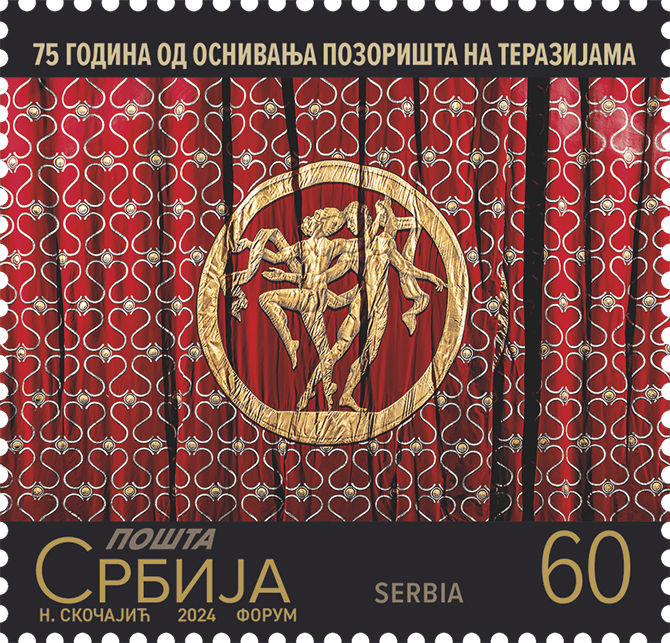
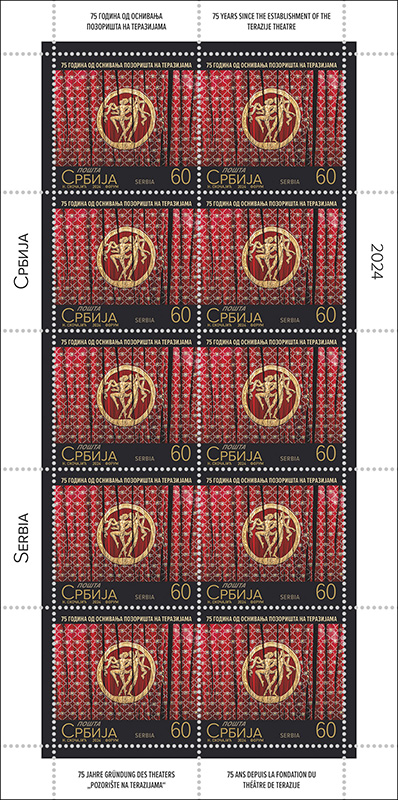
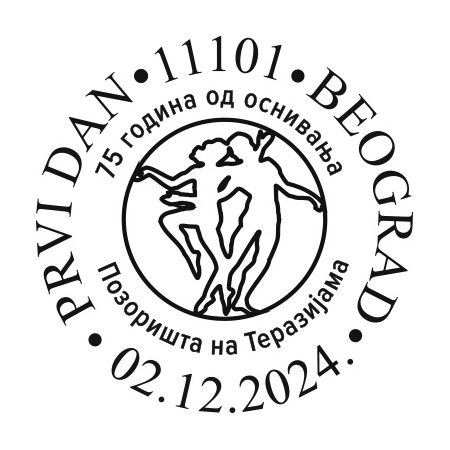
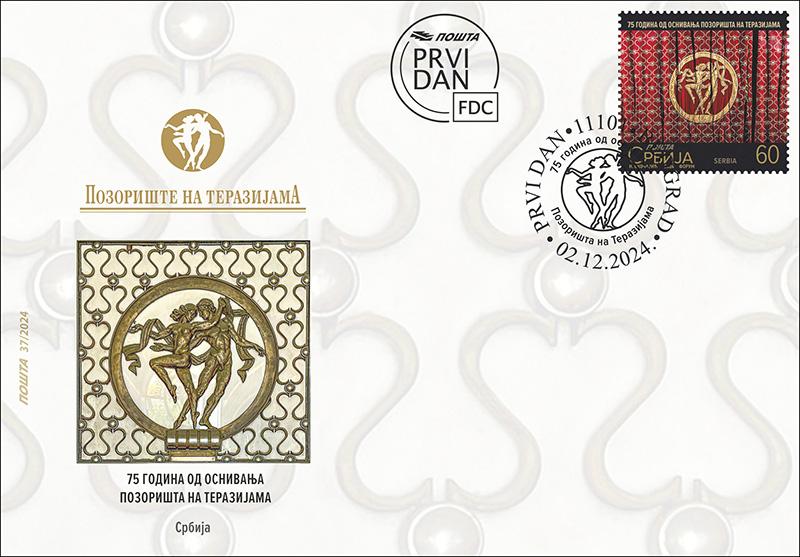
Terazije Theatre was founded on December 23, 1949 as the “Humorous Theatre” and then changed its name several times. From 1954 to 1959, it was called the “Belgrade Comedy”, and after merging with the Belgrade Drama Theatre in the autumn of 1959, it became the Contemporary Theatre with two stages – at the Red Cross and at Terazije. With the new season of 1975/76, it became independent again, under its current name – the Terazije Theatre.
In the first years of its existence, the repertoire of the Terazije Theatre consisted mainly of comedies and plays with singing. Later, operettas began to be performed, and in the 1960s the first licensed musicals such as Oklahoma (1966), West Side Story (1968) and Kiss Me, Kate (1969) were added to the repertoire.
During its seven decades of existence, the Terazije Theatre has continuously enriched its drama, orchestral, ballet and choir ensembles with new, primarily young, talented and educated artists. This has always brought it a dominant note of artistic freshness, which the audience has unmistakably been able to recognize.
Today, the Terazije Theatre is synonymous with musicals and musical theatre, not only in Belgrade, but also throughout the country. In addition to performing Broadway hits such as Cabaret, Grease or A Chorus Line, the Terazije Theatre's repertoire today also includes the following plays: Gypsies Are Found Near Heaven, Chicago, Some Like It Hot, The Producers, Mamma Mia!, The Drowsy Chaperone, Flashdance, Women on the verge of a nervous breakdown, as well as the world hit The Phantom of the Opera. In recent decades, the Terazije Theatre has also nurtured and developed plays based on domestic literature that we recognize as “domestic musicals”, including Lutka sa naslovne strane (Front Cover Babe), The Marathon Family, Na slovo, na slovo (First Letter Given), as well as ever-popular plays such as Zona Zamfirova, Glavo luda (Silly Head), Mr. Dollar or Sa druge strane jastuka (On the Other Side of the Pillow).
Professional cooperation: Terazije Theatre
Artistic realization: Nadežda Skočajić, Academic Graphic Artist
Technical details
Date of issue: 02. 12. 2024.
Number of stamps in set: 1
Denomination:
1356: 60.00 RSD
Printrun: 25.000
FDC: 1
Artistic realization: Nadežda Skočajić
Subject: 75 years since the founding of the Terazije Theatre
1356: Scene with recognizable logo on curtain of the Terazije Theatre
Dimensions of stamp: 35 x 33,35 mm
Perforations: 13 3/4
Printer: Forum Novi Sad
World Art Greats
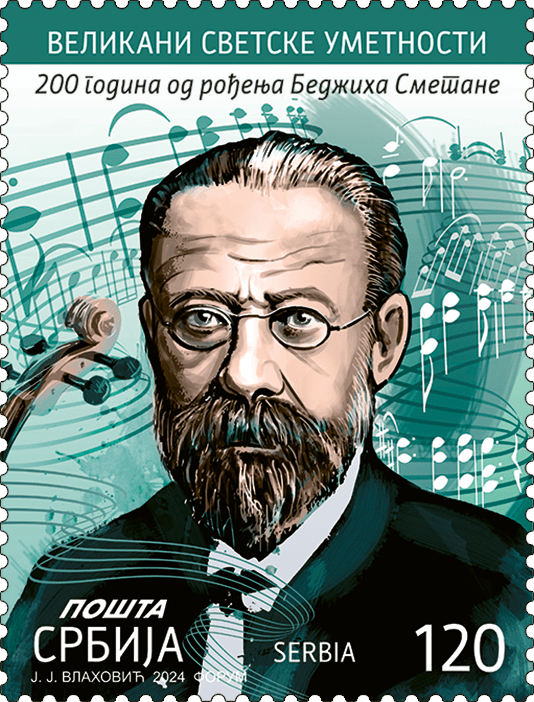
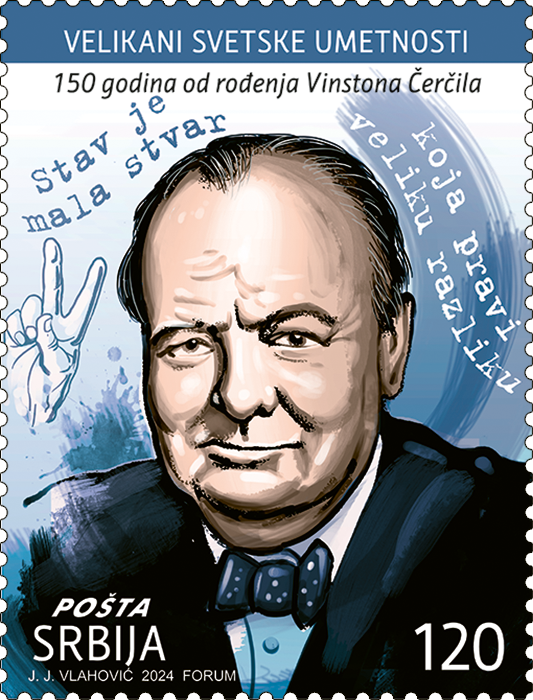
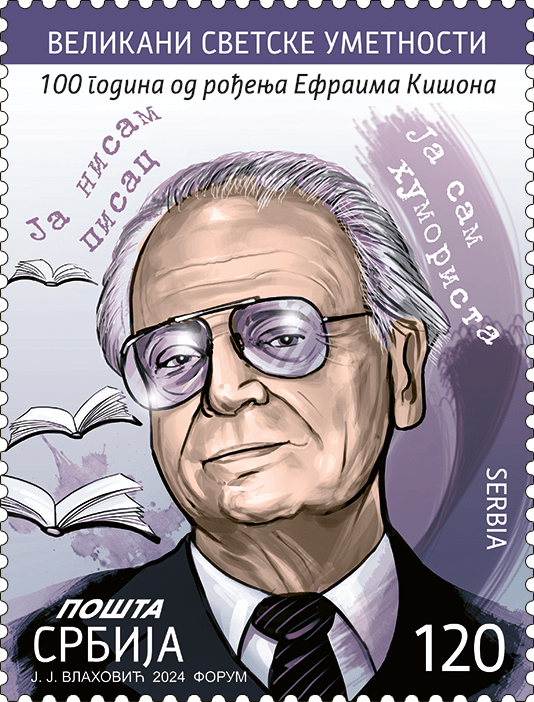
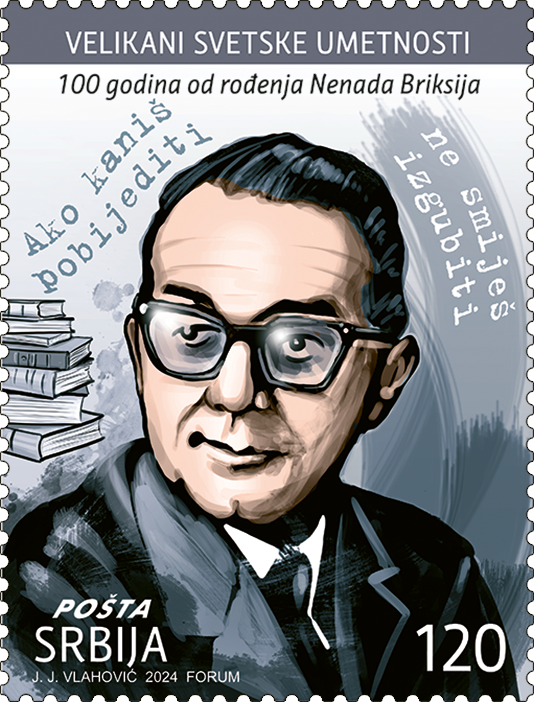
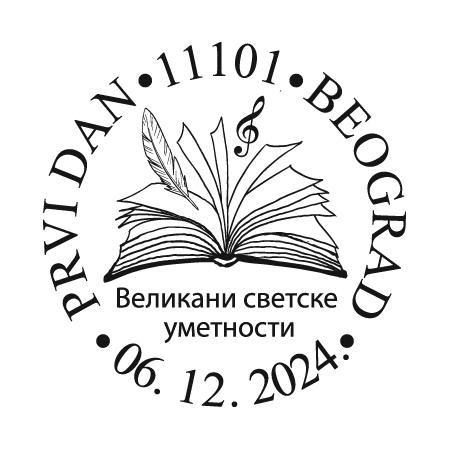
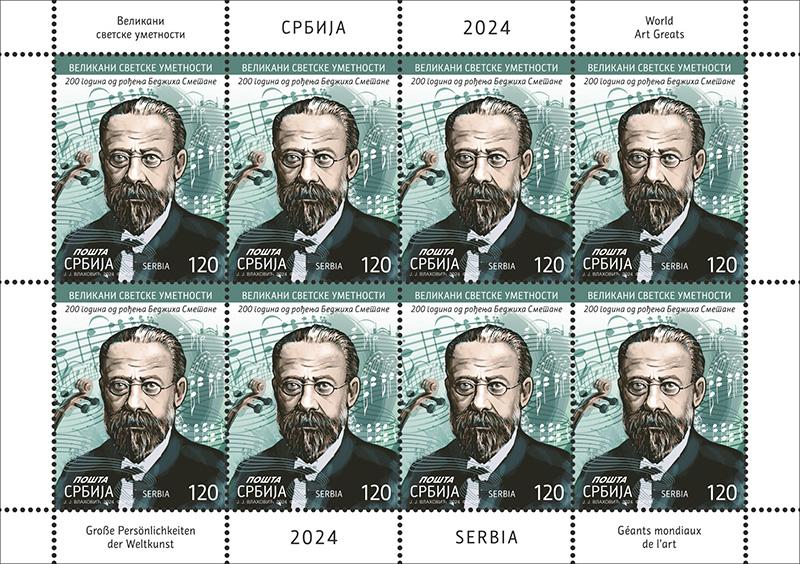

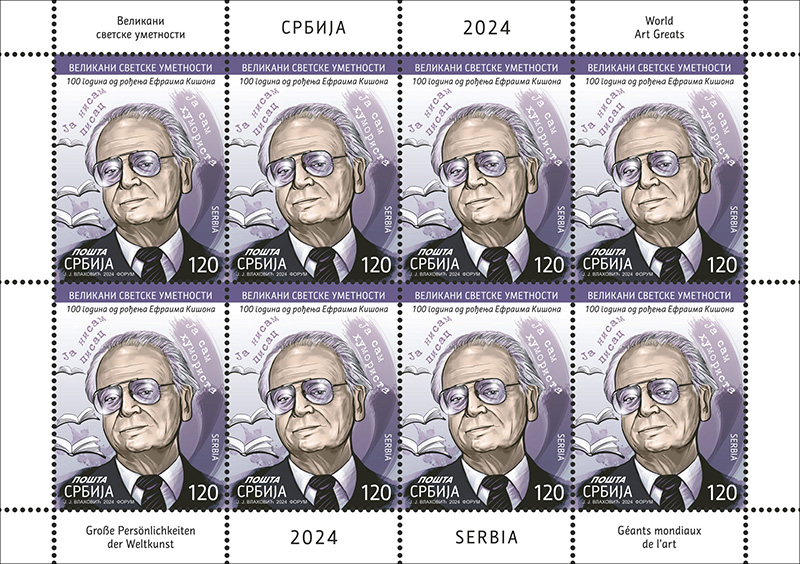
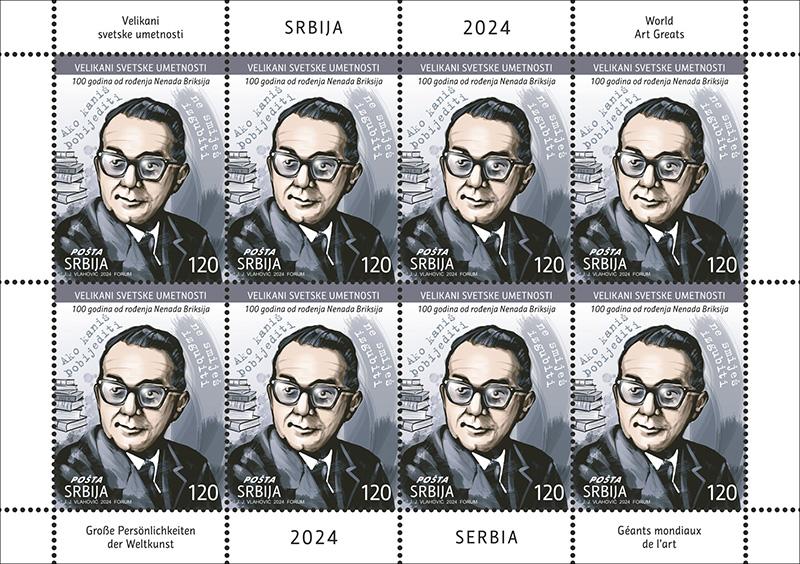
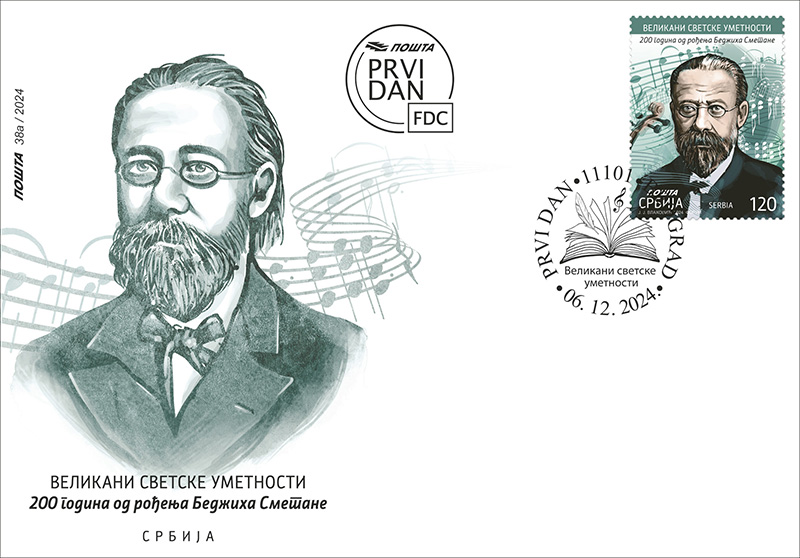
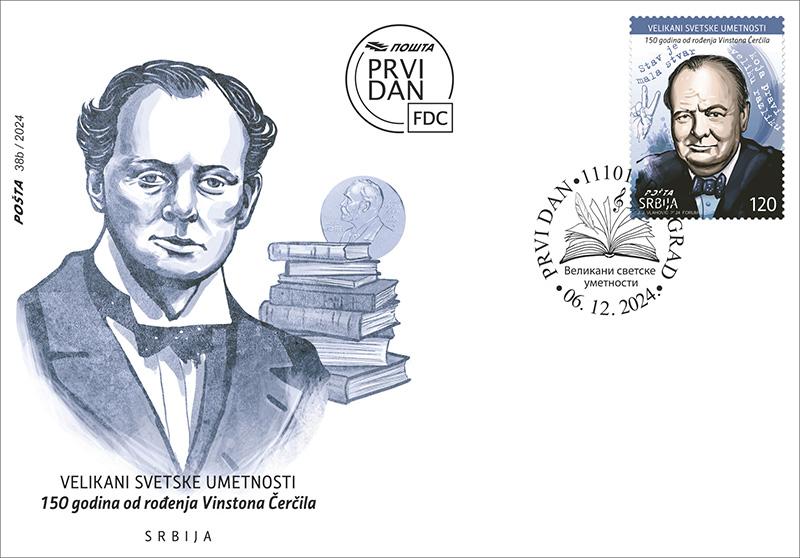
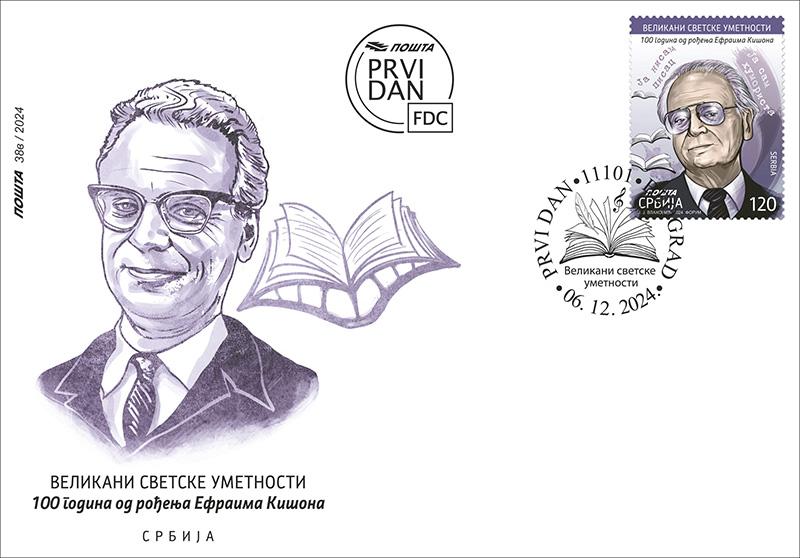
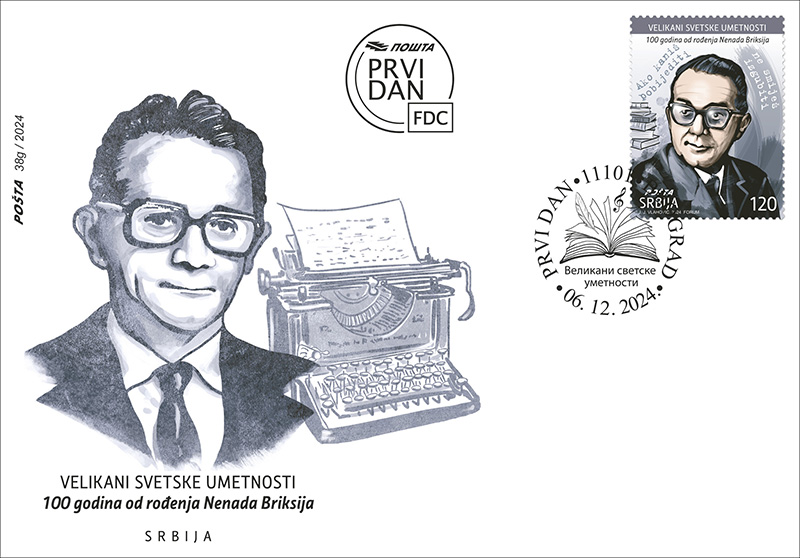
200th anniversary of the birth of Bedřich Smetana
Bedřich Smetana (Litomysl, March 2, 1824 – Prague, May 12, 1884), Czech composer and conductor, creator of the Czech national opera and master of the symphonic poem. His compositional work significantly shaped Czech national music. He was a pioneer in the integration of elements of folklore into classical music, and his authorial work represents a link between romanticism and modernism. Smetana’s music is emotional and dynamic, often using rich harmonies and coloristic effects.
One of his most famous works is the opera “The Bartered Bride”, which has become a symbol of Czech culture and identity. This opera, based on folklore, encompasses themes of love, respect and tradition. Smetana, using folk melodies and rhythms, contributed to the creation of a unique musical language that reflects the Czech spirit, thus affirming the culture of his people.
Bedřich Smetana is also the author of symphonic music, among which the cycle of symphonic poems “My Homeland” stands out. This musical piece, which has as its theme the natural beauties and historical events of Czechia, exudes his love for his homeland. Each poem from the cycle, among which “Vltava” is the most famous and popular today, brings a special atmosphere and story.
Bedřich Smetana is today considered one of the most important Czech composers, and his works are performed all over the world. His ability to combine personal feelings with folk tradition and national identity left a deep mark on music, which continues to inspire generations of musicians and listeners.
150th anniversary of the birth of Winston Churchill
Sir Winston Leonard Spencer Churchill (Woodstock, November 30, 1874 – London, January 24, 1965) was a British statesman, wartime Prime Minister of the United Kingdom in World War II, one of the creators of the global order in recent human history and one of the most significant historical figures of the 20th century. In addition to the numerous statesmanship functions he held, he was also a talented and successful artist from a young age. Art was a means for Churchill to achieve inner peace and escape reality, especially during turbulent periods in his political life. He discovered his passion for painting in his youth, and devoted himself to it more seriously after World War I. His style was inspired by Impressionism, so he often painted landscapes, gardens and scenes from nature, using rich colours and expressive brushstrokes.
Churchill’s prolific literary work includes historical, biographical and autobio-graphical pieces, as well as one romance novel and at least two film scripts. He wrote a biography of his father, “Lord Randolph Churchill” (1906) and a biography of his family ancestor, “Marlborough: His Life and Times” (1933–1938). He also published autobiographical works from the times of British Imperial Wars in India, the Sudan and South Africa. Although he was not an academic historian, he wrote some of the most famous and voluminous works of narrative history – “The World Crisis”, six volumes published between 1923 and 1931, “The Second World War”, six volumes published between 1948 and 1953, and “A History of the English-Speaking Peoples”, four volumes published between 1956 and 1958. He received the Nobel Prize in Literature in 1953 for “The Second World War”.
More than 500 painting pieces and over 40 literary titles make up Winston Churchill’s artistic legacy, which complements his political greatness, leaving the lasting mark on the political and artistic history of humanity of the 20th century.
100th anniversary of the birth of Ephraim Kishon
Ephraim Kishon (Hebrew: אפרים קישון; Budapest, August 23, 1924 – Appenzell, January 29, 2005) was an Israeli satirist, playwright, screenwriter and film director. He was born Ferenc Hoffman. He studied fine arts, painting and sculpture. He began writing during his studies, developing a specific creative style that can be described as “humour in the service of truth”. He survived the Holocaust, which profoundly influenced his perspective and creativity. He emigrated to Israel in 1949. His specific humour, which combined irony, sarcasm and wit, was a sharp criticism of human stupidity and social anomalies, but often also depicted the struggles and challenges faced by the new Israeli nation. Ephraim Kishon’s works are inspired by everyday life and his characters represent various aspects of Israeli society. Ephraim Kishon wrote novels, short stories, plays, and film scripts, and his satirical and cynical analyses of social phenomena have made him one of the most beloved writers in Israel and around the world.
Among his most famous works are “My Family Right or Wrong”, “How unfair, David”, “Mein Kamm – My Comb”, “Blessed is He Who Believes”, “The Seasick Whale”, “The Fox in the Chicken Coop”, “No Oil, Moses” and numerous others, in which he critically shed light on serious life topics through humour and satire, making an exceptional contribution to Israeli and world culture and literature.
100th anniversary of the birth of Nenad Brixy
Nenad Brixy (May 4, 1924, Varaždinske Toplice – August 17, 1984, Zagreb) was a Croatian journalist, novelist and comedian, the founder and editor of many magazines in post-war Yugoslavia. He edited “Varaždinske vijesti” (1945–1947), “Novi list” in Rijeka (1947–1954), “Narodni list” in Zagreb (1955), and Globus (1956). He was the editor-in-chief of the magazine “Plavi vjesnik” (1960–1967), and then the entertainment editor of the Zagreb-based “Vjesnik” (1967–1974), but he retired early due to health problems.
Brixy was also a successful author of short stories, sketches, humoresques, and travelogues, and published notable novels under the pseudonym Timothy Thatcher, the best-known and most successful of which is “No Entry for the Dead”, translated into five languages, published in about a dozen editions, and filmed in two different movie versions.
Nevertheless, Nenad Brixy will be remembered in the social history of the former Yugoslavia as the editor and translator of the Italian comic book “Alan Ford”, whose brilliant and ironic translations, extremely successfully localized, contributed to “Alan Ford” gaining mythical popularity and cult status in the Serbo-Croatian speaking area.
The original twists that Brixy “composed” brought freshness to the comic, making it an integral, almost original piece of domestic popular and alternative culture: “Better something from something than nothing from nothing”, “He who sleeps is not awake”, “If you intend to win, you must not lose”, “Better to live a hundred years as a millionaire than one week in poverty” and others, were the maxims with which generations born in post-war Yugoslavia grew up.
Nenad Brixy has also written numerous other pieces, including the book of reports “Side by Side”, the novel “And So On” and the radio comedy “A Quiet Life”, as well as a series of novels about detective Timothy Thatcher.
Artistic realization of the issue: MA Jakša Vlahović, academic graphic artist
Technical details
Date of issue: 06. 12. 2024.
Number of stamps in set: 8
Denomination:
1357: 120.00 RSD
1358: 120.00 RSD
1359: 120.00 RSD
1360: 120.00 RSD
Printrun: 25.000
FDC: 4
Artistic realization: Jakša Vlahović
Subject: Greats of world arts
1357: Bedřich Smetana
1358: Sir Winston Leonard Spencer Churchill
1359: Ephraim Kishon
1360: Nenad Brixy
Dimensions of stamp: 31,1 x 42 mm
Perforations: 13 3/4
Printer: Forum Novi Sad
120 years since the publication of the first issue of the daily newspaper "Politika"

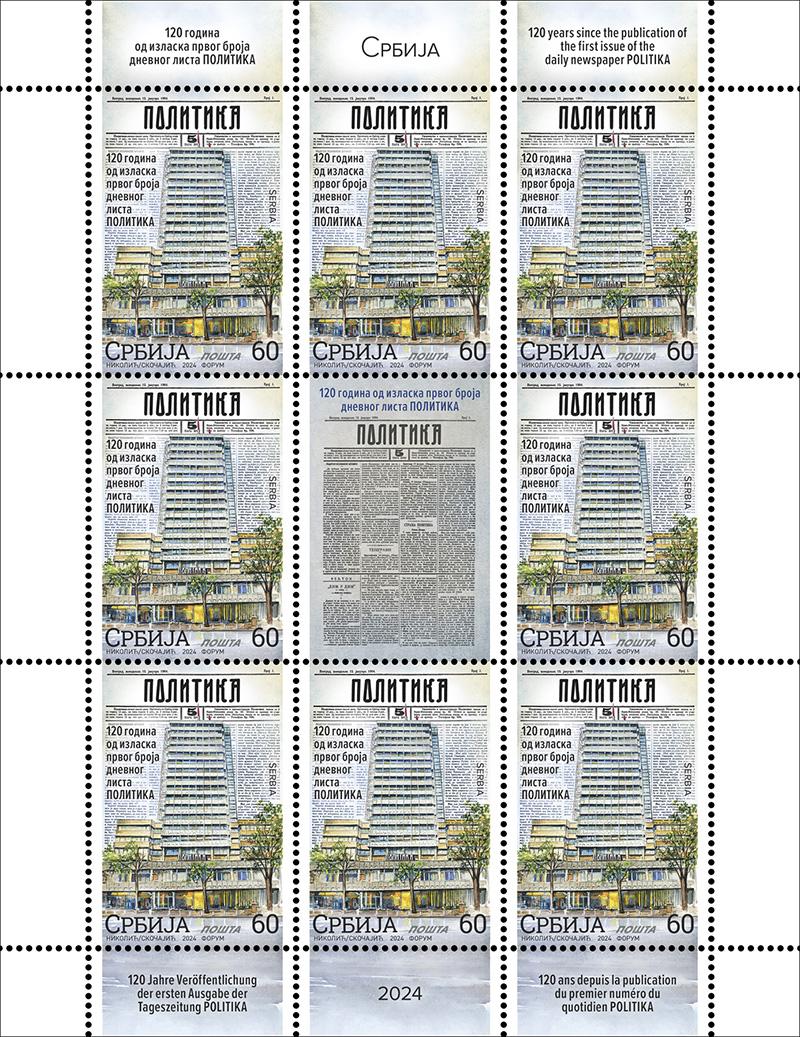
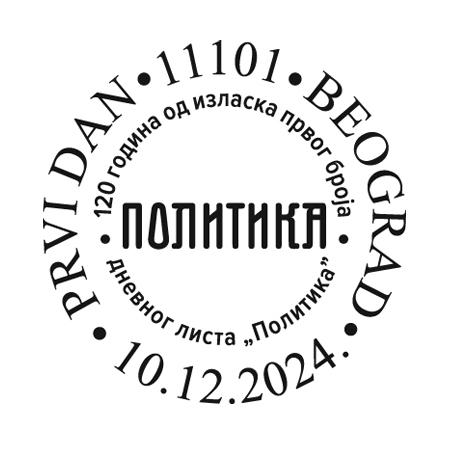

When Vladislav Ribnikar, the founder and editor-in-chief of "Politika", filed a request with the authorities back in 1904 regarding the launch of a new daily newspaper, he stated that the newspaper would be political and independent. The colporteurs who shouted the name of the new daily newspaper on the streets of Bel-grade on January 25, 1904, printed on four pages, in a circulation of 2,450 copies, and sold for five para, started a history that would last 120 years.
During all that time, "Politika" gained its readership mainly among educated citizens and chose its contribu-tors from among significant cultural and scientific creators, such as Nobel Prize laureate Ivo Andrić, Miloš Crnjanski, Branko Ćopić, Jovan Dučić, Branislav Nušić, Desanka Maksimović, Slobodan Jovanović, Isidora Sekulić, Tin Ujević, Momo Kapor, Vladimir Bulatović Vib, Mihajlo Petrović, Vasko Popa, etc. Author's texts for "Politika" were also written by Sir Winston Churchill and Thomas Mann.
During times when the country was under occupation, "Politika" was not published – during World War I from 1914 to 1919, and again during World War II, from April 1941 to October 1944.
Today, "Politika" is a daily political newspaper that traditionally adheres to highly professional journalistic standards and fosters a culture of dialogue and freedom of expression. The oldest, most respected and most influential daily newspaper in the Balkans is today considered one of the national institutions in Serbia, the founders of which not only laid the foundations of modern journalism but, by establishing this unique institution of culture and civic thought in Serbia, showed that it is possible to last in our region as well, if the foundations are well laid and carefully guarded.
Professional cooperation: Nikola Trklja, "Politika Newspapers and Magazines".
Artistic realization: Miroslav Nikolić, Nadežda Skočajić, academic graphic artist.
Technical details
Date of issue: 10. 12. 2024.
Number of stamps in set: 8
Denomination:
1361: 60.00 RSD
Printrun: 25.000
FDC: 1
Artistic realization: Miroslav Nikolić and Nadežda Skočajić
Subject: 120 years since the publication of the first issue of the daily newspaper "Politika"
1361: the building of Politika, in the background is the first issue of the daily newspaper POLITIKA
Dimensions of stamp: 30,45 x 42 mm
Perforations: 13 3/4
Printer: Forum Novi Sad
80 years of the daily newspaper “Magyar Szó”
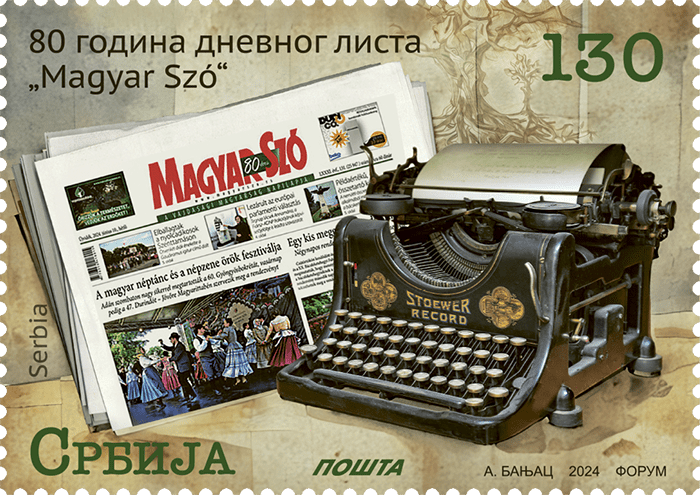
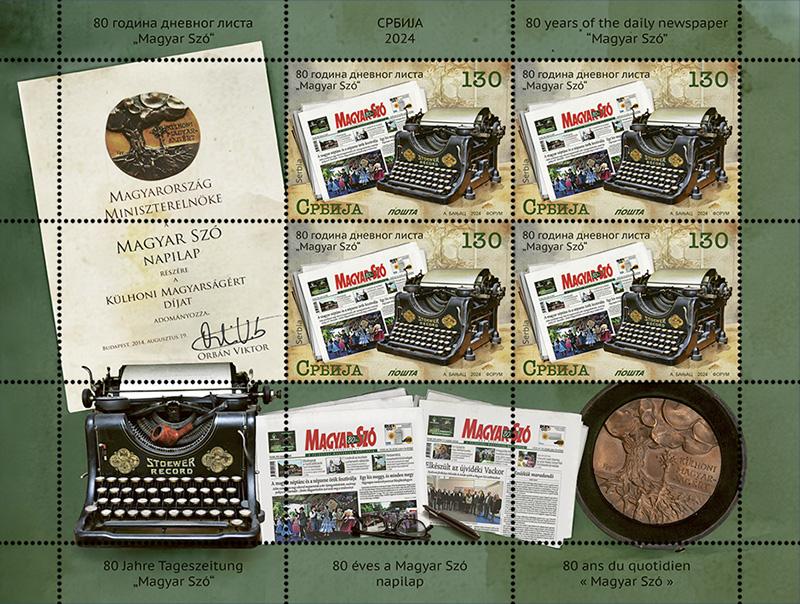
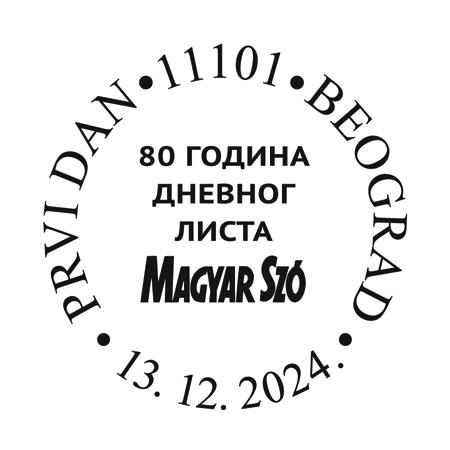
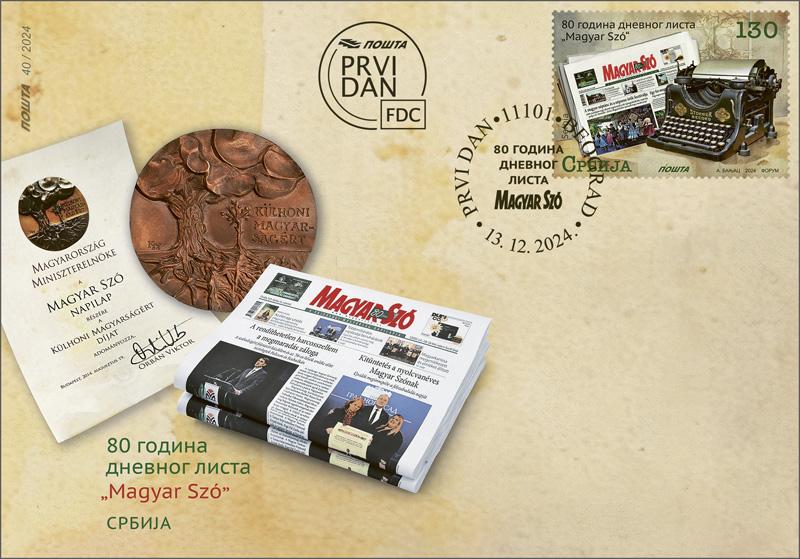
While war and peace were writing the last chapters of the destruction of yesterday's world, on December 24, 1944, the first issue of the daily newspaper “Magyar Szó” appeared in the provincial capital. The first issues were translations of „Slobodna Vojvodina“ into Hungarian, and on September 27, 1945, the paper was renamed “Magyar Szó”.
With 80 years of continuity, “Magyar Szó” is today the only daily newspaper in a minority language in Serbia, with original newspaper articles and thematic supplements in the Hungarian language, which is available to the readership every day except Sundays in the printed edition, i.e. continuously in the online edition (www.magyarszo.rs) and with editorial offices in Novi Sad, Subotica, Senta and Bačka Topola.
“Magyar Szó”, during eight decades of publication, became and remained the voice of Hungarians in Vojvodina, for which the paper received numerous domestic recognitions, as well as recognitions from Hungary.
Professional cooperation: Magyar Szó
Artistic realization of the issue: MA Anamari Banjac, academic painter
Technical details
Date of issue: 13. 12. 2024.
Number of stamps in set: 4
Denomination:
1362: 130.00 RSD
Printrun: 25.000
FDC: 1
Artistic realization: Anamari Banjac
Subject: 80 years of the daily newspaper “Magyar Szó”
1362: jubilent issues of the daily newspaper “Magyar Szó” and old typewriter
Dimensions of stamp: 49,3 x 35 mm
Perforations: 13 3/4
Printer: Forum Novi Sad